John Boyd Designs Notting Hill 3 Drawer Chest

At the Lacquer Chest, her fabled antiques shop in Kensington Church Street, Gretchen Andersen has a ringside seat from which to monitor and influence the shifting sands of our changing taste in things. When she started out, interiors magazines had yet to be invented. She took the shop over from her mother in law who'd had it since the end of the war, and came from a grand Anglo-Indian family. 'In those days wonderful things were available. And then she gave up because, she said, there were no antiques left. Then Vivian my husband [who died in 2013] said, You're very good at beginning things, but not very good at finishing. So he gave up his job with Ove Arup, and we began working together. We've been there over 60 years as well. '

Gretchen understands the flows and ebbs of antique dealing with the same keen intelligence of a trawler-skipper working the seabed and its teeming populations. Charlie Porter of @tat.london rates @lacquerchest as a TOP SHOP and so does @theworldofinteriors – with a feature on Gretchen's London House published a month ago that has segued into this one, when I returned for more talking and more photographs. 'Unlike most shops, at the Lacquer Chest, you never know what's going to be there.' Gretchen told me. 'It's best if you please yourself, but if I liked something, I'd get seduced and I would always buy it and I don't think that's a very good way to deal. But it's perfectly obvious – via Instagram – that most people just want to be like other people, there are a few who do just what they want, but that's very unusual.'

'If I was in the shop I would deal with the customers because I knew them, so I made lots of friends. I met such interesting people, only one in all those years who sent me running into the back of the shop – and he was a famous dealer.
I remember going to so many houses and saying, My God that 's wonderful! Where did you get it? And they said, We got it from you! Those Mochaware mugs have come down from the hiring department, 20 years ago we hired them out a lot. They're just out of fashion. Hiring has taught us a lot about fashion.'

'I knew all the people who worked for Terence Conran, his buyers. When he was young, he came into the shop and said, I've bought a small company that makes chairs, and if you find a chair that's worth copying please let me know. I was very flattered.
I thought Sir Roy Strong was a very, very clever man. I watched his progress, his garden exhibition at the V and A – it was wonderful! Theatrical. As I left, I thought, Gardens are never going to be the same – and now people are obsessive about them! That's a Howard sofa, I bought it because it was so comfortable, to replace a Chesterfield, 60 years ago, I only found out the maker's name later on.'

'That's real Morris. I got it 50 years ago, nobody knew what it was.'

'A boy who used to work for us painted that table. I know at least two people who've inherited their father's Regency furniture and its looks ghastly in their houses ,and you think – Why? '

'I've just read a book again that I read about 10 years ago, about the Garlands – Kathleen [Garland], Lady Epstein, one of Epstein's many mistresses, she stayed the course and had three children by him – She bought a kitchen table from us.
The dining room was the thing then, but we had one big room that was our kitchen and our dining room. Within ten years the dining room had ceased to be a thing. Do you have a dining room?'

'It is hard for a husband and a wife to work together. I always felt so guilty, because I worked so hard, I really wanted to bring up my children. I used to come home and eat lunch with them every day and I was an obsessive cook.'

'We had a tiny kitchen up to here.
We rebuilt it about 30 years ago.'

'Viv had a very good eye and bought some wonderful things. I was much the bigger buyer, so I was out three days and Viv was out perhaps one or two. I used to go to Scotland every month – everywhere – I used to take the car to Olympia, put it on the train and get out at Perth. Well, I loved it! I used to go to the west country every week. Once the M5 came and Gloucestershire became so grand, it was not so easy. We never looked up things when we bought them privately which meant we always sold things at a bargain.'

'We've lived here for over 62 years.'

'Antiques were considered only before 1830. We were buying what other people left behind. I was an avid reader of Vogue and I followed Elizabeth David – casseroles, wooden spoons and bread boards – and I bought all that sort of thing. And then I remember suddenly realising the word 'lifestyle' had entered into society,' she says.

'What is so awful is that almost everything I collected – like samplers and blue and white china – is unthinkable now.'

The knocked-through kitchen is a light-box painted by a man whom she describes as a difficult genius, a colourist who used nine different yellows and added a single muted lavender stripe to one ceiling rafter.

'Near our Sussex house there was a woman from a very artistic family. And they had a studio down on the river. She asked Vivian to come, they were clearing it out. Outside there was a skip, and next to it there was that. She said. Oh those are rubbish, my sister painted them.'

'Hockney bought from us when he was a student, just useful things, armchairs and things. Julie Christie used to come for at least 5 years, buying furniture.Then she just disappeared. Min Hogg bought a huge bed from us. She'd just come in and say, I love it! I'll have it, please deliver it.'

'That Delft pot? I bought it years ago, it had a broken handle and I had it ground off. It's sad that almost anything old is better than anything new. It's really hard when you buy things, to know which are the winners. Even after all those years – you should know. I bought the most beautiful thing, a Green Man by Prue Piper.
I sold it to someone who I think knew what it was. That picture there – I bought to sell – in a shop in Marlborough. Oh I loved her!
I bought it for a fiver.
It's so peaceful.'

'This is the nicest, lightest, room, I live in here. That teapot cost about £10, from a shop selling tea, in China – I went there with a friend who wrote the Blue Guide. I've always lived on Lapsang. I made this mismatched set of breakfast cups. The tablecloth? Its English, I pulled it out of the hiring department. That's something called Ruskin ware, Ive got masses of it, its very hard to sell.'

'There's no real problem about finding out about things in England with all these marvelous museums – Maybe if you lived in Australia there would be – you just have to go and open your eyes and look!'


'I had this man's dressing gown in hiring and it never hired, so it's been lined for me to wear.'

Alphabet lithographs by William Nicholson.

staircase corner

ablutions

abolition sampler

The orange corduroy chairs? – I sold the matching corduroy sofa to Lord Snowdon's second wife.

cushions

cushions

'I can remember a customer coming and showing this wallpaper to me and saying the people who made it were closing down. And I rushed into the west end, and bought it. It was three shillings a roll.'

bedroom

bedroom

french empire mirror

'This is painted the way French people do it.
I think the English pick out everything in white.
Green.
It makes the room look much bigger.'

Every time we painted the place – we haven't done it since Viv was alive – he used to say, Let's get rid of all these pictures. and we'd take them down and sell them all.


spare bedroom





more Ruskin ware

'I realise, The World of Interiors validates you – if you're in it.
All the time my husband was alive they asked us, and he said, I will be in it if you say nothing about me, because he couldn't bear to read about himself. But they always wanted a story to go with it. That was Min Hogg, who was a very good customer of mine.'

top floor bathroom

de Morgan tile splash-back

only damaged tiles were used

'I used to collect a lot of china but Ive pulled things out and sold it.
30 years ago you had more clutter than you have now.'


'My long marriage wasn't always easy – the shop kept me going and my assistants were terribly good . You've got to realise, however clever and successful you think you are, you make stupid mistakes. It makes you see cause and effect. It makes me realise that nothing is what it seems.'

'I've never been interested in the money side of it. When I go into the shop I say, That's not interesting enough, I don't know why I bought it, don't put it in the front – Put it in the back!
I think when you get older, you need money more than when you are young.'

'In those days we used to sell 40 percent to American dealers, they were the biggest dealers in the world. Then hiring became the core activity 40 years ago. What I wanted to keep were the rare things, but what people wanted to hire were the not-so-rare-things.
When I started, I had a huge collection of very rare cutlery, a better collection than the V and A. But masses of things I've had to get rid of – like fish eaters – that nobody gives a damn about now. People are terrible thieves nowadays tho.'

'When the holidays came, I would decamp to our house in Sussex. I would spend 3 days there and Viv would spend 3 days there, one of them overlapping. I should get rid of it, but it's like signing a death warrant. I've sold a lot of the things from that house in the shop, and I stupidly sold them for far too little – but most things go down anyway. But they've done their work haven't they?'

'In principle if something looks like a lot of money, it's because I've paid a lot. When you've been running a shop for years you know, if someone says, This is a really nice shop, they're never going to buy anything.
Ewan [ Ramsay-Wilson, her partner in the shop] says, Nobody wants to pay what you've asked; in every sale that we make there are at least 20 others when you have to come down. But I never get used to it. Thirty years ago there was a huge market in early painted furniture. A customer tried to sell me back a dresser he'd bought from us years ago – it had been a huge price, we'd never have got that now, But for a long time, if anyone came and wanted to sell me back something I'd always buy it back, and offer them a bit more.'

'We got £600 for a pair of little Staffordshire birds, they were very early but they'd have been about three thousand twenty years ago.
Staffordshire's gone down more than anything. China was dominated by very few people, there are no collectors left now.
Only decorators buy pairs of things.
Most decorators don't like antiques, they like repro.'

'This china is called the Dollar pattern. No one's ever found one marked, its about 1820, its transferred and painted by hand, the orange is on top.
It's very hard to find now.'

Very many thanks to Gretchen Andersen
All photographs copyright bibleofbritishtaste. Excerpts may be used as long as clear links are supplied back to the original authors and content.
The Lacquer Chest
75 Kensington Church Street
W8 4BG
London

At the shop. "I'm at home having had a very exciting day buying for the shop yesterday! It involves waking and rising at 5am and staggering back at 4.15. But I found many new exciting bits for the shop.'

The Lacquer Chest
Located between Notting Hill Gate & High Street Kensington London Underground Stations(Central, Circle and District Lines)
Shop: 00 44 (0)20 7937 1306
Prop hire: 00 44 (0)20 7938 2070
email: info@lacquerchest.com
OPENING TIMES:
Monday to Friday 10:00 – 4:00
Saturday (shop only) 10:30 – 4:00
Sunday closed

In 2019, artist-designers Luke Edward Hall and Duncan Campbell were looking for a place in the country, somewhere to plant a garden and have friends for the weekend. They found it here, at the Gloucestershire end of the Cotswolds where the Chelsea tractors give way to real combine harvesters. Luke was very much enthused: 'I'd never lived in the country before, so when we came here. I said, I want china dogs, I want chintz! Naivete and super-sophistication together. We all love china dogs – all our friends bought us china dogs!'

Working from home, Friday.
'I learned my taste by myself. I had a really nice provincial upbringing, I wasn't taken to galleries or anything like that but I was always making things and drawing and my parents were very supportive of that and then that's what I did at school: I went to art club on Thursdays. The only access I had to the outside creative world at that point was going to W.H. Smith and buying magazines – not really Vogue – Dazed and Confused, The Face.' Was there a nightclub? 'Yes, it was called Liquid and I used to go and I didn't really enjoy it. I was desperate to get away to art college at the very first opportunity. I knew that I was going to go there from when I was maybe 14 or 15…. '

Their Cotswolds farmhouse. As Duncan wrote – in House and Garden last year : 'we felt ready for a new set of experiences that we hadn't found time for in London. A dog! A vegetable garden! Space for guests to stay! But mostly we wanted somewhere to retreat to at the weekends, that wasn't an expensive pub with rooms upholstered in a million shades of beige…'

'I'd always had an interest in antiques and old houses. When I was at school, I and all my friends used to work at The Vyne, that National Trust house, in the café.'

'We moved in over the summer and we sort of didn't think about it, we painted it very quickly, the green is from Leyland. We put up all our favourite colours, pink and yellow, combining objects of different periods.'

'My friend Lucy [@lucycwilks ] who I used to work with at Ben Pentreath Ltd. said, 'Oh there's an amazing spotty chair with Colefax [Malabar] loose covers coming up in Criterion auctions – I really want it but I don't need it'. ' I got it for about £200.'

Chimney garniture and home-grown tulips


'When we moved in, we literally threw up everything we could. And now I'm replacing things – those are just Picasso prints, pages from a book. Our friend Mark, who runs an online shop on Battersea Ebury Trading, , he gave us those.'

'We wanted the place to feel cosy and inviting, a bit cottagey but never twee. We were keen to entertain in a way we didn't have space for in London, and to create something that would allow us to mix styles, periods and our own designs, as well as trying out things for fun that our clients probably wouldn't agree to' – Duncan Campbell

and with Merlin, faun-like beloved young whippet.






'I applied to St. Martins {School of Art] , I knew it was the smartest place to go to and I wanted to come to London, so that was the only university I applied to, and I moved to London when I was 18. Christopher Brown (@christopherbrownlino) was my tutor – and Judith Watt (@fashion.bibliophile) – who teaches Fashion History at St Martins – taught me for one or two projects.'

'Then when I moved to London it was actually a really exciting time – because I lived in Bethnel Green – Shoreditch, Hoxton, that whole area – there were really exciting things going on there. In 2006, 7 , 8 ,when everyone was dressing up, I was in denim shorts and Dr. Martens and bleached blonde hair at that point. And I wasn't quite sure what I was going to do, I was at St Martins and going out and having a great time.'

"So I started a fashion communications degree which was kind of styling and painting. I thought I wanted to go and work on a magazine. I realised quite quickly I wanted to do design instead. So I changed to menswear and did a menswear degree . After I'd finished my degree I'd interned with Toast for 6 months, I used to go and stay with the couple who founded it in their house in Wales, tho the company had already been bought by Nicole Farhi then.'
'I think the tablecloth on the little round table is old Schumacher bought from eBay'

fridge-art


What d'you drink on Friday night? 'Loads of gin, vodka, Campari…'

'My favourite things in the house currently are the the new gothick chairs, this gold chair – we got it from Lorfords in Tetbury. I love a bit of grotto furniture. Dolphin legs and shell-shaped!'

'A big poster we bought in Rome'

coats and jasmine

design for a state bed

'That's something – Matedor paintings – I did when we needed 2 big things to go either side of the chimney, so I wacked them up'

more dogs, and Luke's candlesticks – 'I work with this ceramicist – we design the shapes together and then I hand paint them. And we make platters and vases too'

A plaster urn designed by Rex Whistler for his house, Ashcombe, and cast in the 30s. 'A few years ago someone emailed me and said, do you want one?
And then last year in lockdown when I didn't buy anything, I got back and said have you still got it? Oliver Messel made them, there were nine made, its falling apart but I love it!'

'I'd heard of Roy Strong, he was one of the talking heads who popped up in that 'Love Cecil' [Cecil Beaton] documentary that we were talking about. And then when the sale [of the contents of his house, The Laskett] came up, I just loved it all, I loved how kind of fun it was….' Pair of Strawberry Hill-style gothick chairs, from The Laskett sale

'I like the Sitwells a lot and Stephen Tennant. I just love the cover of that book, it's so great.'
 work in progress, chairs are by the Italian designer Vico Magistretti, made by Cassina and retailed by Habitat in the 1960's.
work in progress, chairs are by the Italian designer Vico Magistretti, made by Cassina and retailed by Habitat in the 1960's.

Sweet peas and King Arthur

'I get interested by scraps of fabric on ebay. In the dining room its an old Sandersons fabric I found on ebay. The sketch of costume designs for a male ballet dancer – probably for Swan Lake – is by Cecil Beaton, sold by Harry Moore-Gwyn from an exhibition of his sketches last year. One of my projects at Central St Martins was based on the 'Bright Young Things."

Merlin


'I remember the day I met Ben [Pentreath]. It was the day Amy Winehouse died. We were living in the same London square as her. When I was at university with Duncan and his best friend Haeni Kin – he did Law at Kings – we wanted to do something outside that where we could just have fun with our friend.' So they created Fox and Flyte – 'to find new homes for objects that might otherwise be considered old-fashioned or fussy.' "It is our belief that beautiful things can improve the quality of your life. But then again, perhaps you just need some teaspoons."

Ben Pentreath took them up and gave them a pop-up space in his shop. Remodelista wrote them up. 'After that I went and worked for Ben in the decorating studio upstairs over the shop for a bit, with Lucy Wilks who is now one of my great friends, which was great. I did that for 2 years.'

master bedroom


'Behind the tulips there's one of the photographs of Stephen Tennant's house, Wilsford Manor, from the Sotheby's country house sale in 1987, bought from Diana Parkin of the Michael Parkin Gallery. I go for anything Tennant – y or Beaton – y. And Peter Watson.'

Three line drawings by Peter Samuelson. Bedcover from Saved NY. 'The Endymion cushion I designed for Svenskt Tenn. My final collection at St Martins was inspired by Endymion, it was all kind of handmade linen shirts and crowns made out of Willow. I sold all the crowns .I've still got some bits…'

From Luke's instagram account, for his 2012 menswear collection, photographed by @kimjaconsento, styling by @anthonystephinson

Two Beaton photographic prints, one of Stephen Tennant and Siegfried Sassoon, one of Gervase Griffiths

outside

'Merlin – he loves to go to bed inside that bed'

'Bedroom sketches – done for me for fun'


Master bathroom.Lavender.

Blinds: 'When we moved in we just used stuff we already had and bought a few bits. I had left over silks so we just thought, Let's use these up – they're made by this lady we work with – We said, lets make them really 80s, really frilly like knickers.'

'All this lap boarding was already there. Duncan's not a fan of the decoration at Charleston, he things its childish, but we have a lot of similar tastes in things.'





more lovely blinds


'This is the Boy's Bathroom so we're filling it with boys. This is by my friend Fee Greening, she does pen and ink drawings, that's Byron. That's by Christopher Brown my old tutor – A Minotaur – and then that's one I did for Lanvin – an invitation – and then Mapplethorpe – we're big fans – it's a mixture of everything.'

a spare room

outside

Spurge

'as a final pre-Christmas offering to the garden gods, we planted a thousand tulip bulbs, some narcissi and a sprinkling of snowdrops,…' – Duncan Campbell. The garden early in May

Plan for the garden : 'We resolved to begin with the things we understood and had two L-shaped flower beds dug at the front of the house. These would be tall, exuberant English borders in the cottage garden style, bursting (if all goes to plan) with tulips, hollyhocks, roses, peonies and dahlias when the season comes around. Next to that we put in a series of raised beds in a simple geometric motif for vegetables and cut flowers, divided by gravel paths lined with fruit trees, and a couple of additional beds on the side of the house.' – Duncan Campbell

the May spring garden


a cool, late, spring, 2021


'The pink and yellow builders buckets? Nicky Haslam said, 'You have to go to this shop, Stowagricultural – it's the most ravishing shop you've ever been to!"



meadow behind

Lavatory. A tomato soup coloured Coronation Chair designed by Lord Snowdon for guests attending the Investiture of the Prince of Wales. 'That's perfect, the design is perfect – that I got in a local auction, it was in Wales or somewhere on thesaleroom.com '

'The plaster bust after Michelangelo's David? Duncan's mum gave it to me for my 30th birthday.'

'Duncan's mum drove it down from Edinburgh in the back seat of the car with her poodle sitting on the front seat, I'd seen it in a junk shop there.'

Framed magazine shoot photo on the lavatory wall. 'Our London flat's completely different now, we're having work done…'

'Ive done one book of my work and things to date – Disco Greco – but I'm working on one at the moment about the cottage and inspiration for Vendome. And I'm starting up a brand, its starting with jumpers. With the backing of a company. I'm quite excited!'

Thanks so much! to Luke Edward Hall and Duncan Campbell
All photographs copyright bibleofbritishtaste. Excerpts may be used as long as clear links are supplied back to the original authors and content.
www.lukeedwardhall.com
@lukeedwardhall
@jduncancampbell
Years ago, when our children were young, our generous friend Mary took us all for summer holidays at her family house, on one of the outermost islands in the Outer Hebrides. There in the rain, with white sands and beach lunches cooked for 22 people, I met Domenica and her husband the screenwriter and author Charlie Fletcher. She is so modest that it was only a few years ago that I found out what she was doing. Domenica was an art student, the child of two more artists, who had once worked on The World of Interiors and Elle Decor in London and LA. But she was a maker at heart, fashioning dolls, toys and dolls clothes for her daughter, 'who wasn't the least bit interested. But I became more and more obsessed.' The extraordinary canine menagerie that she began to make after that features at the end of this photo essay. But first, the house.
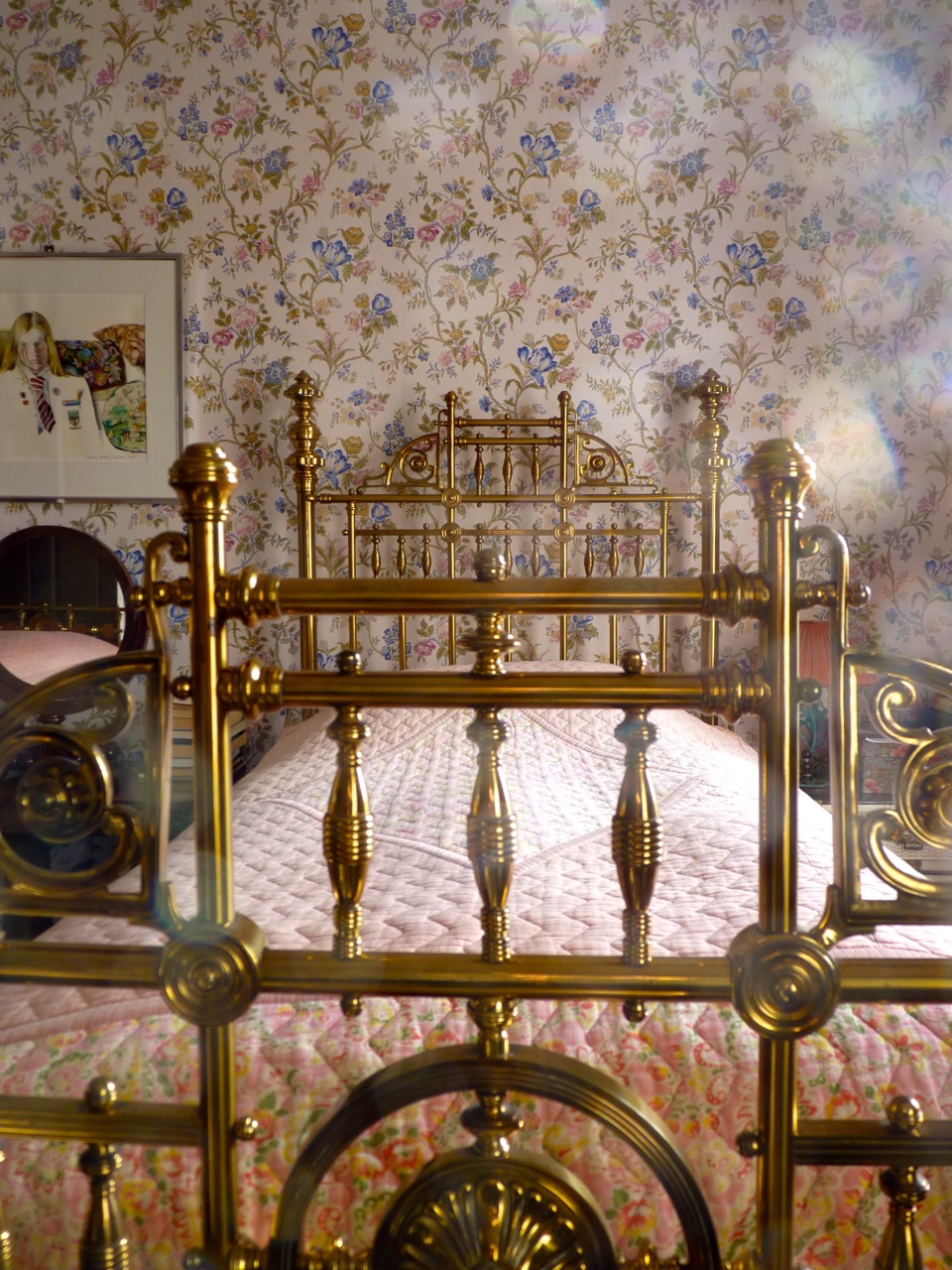
A top floor bedroom.
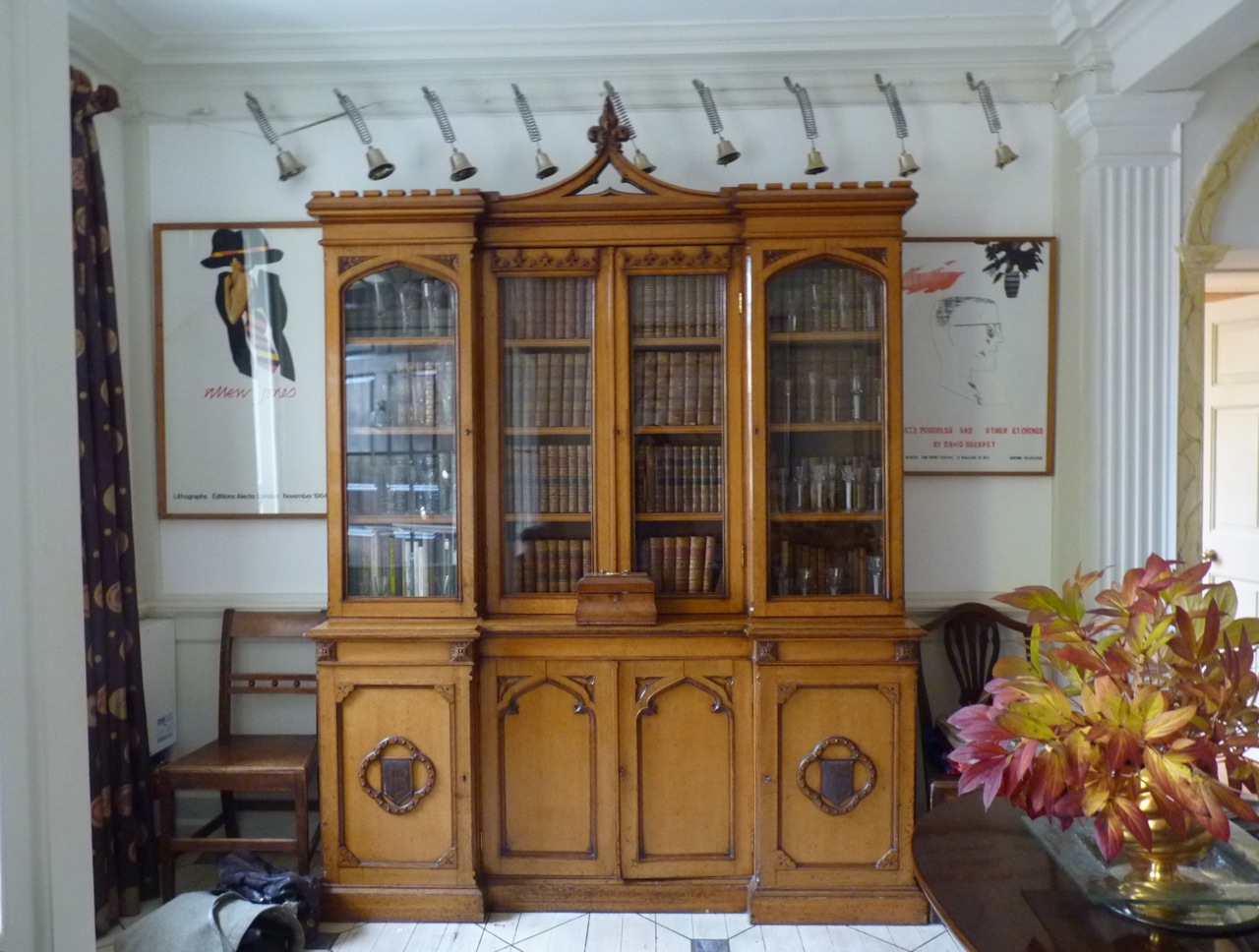
The hall.
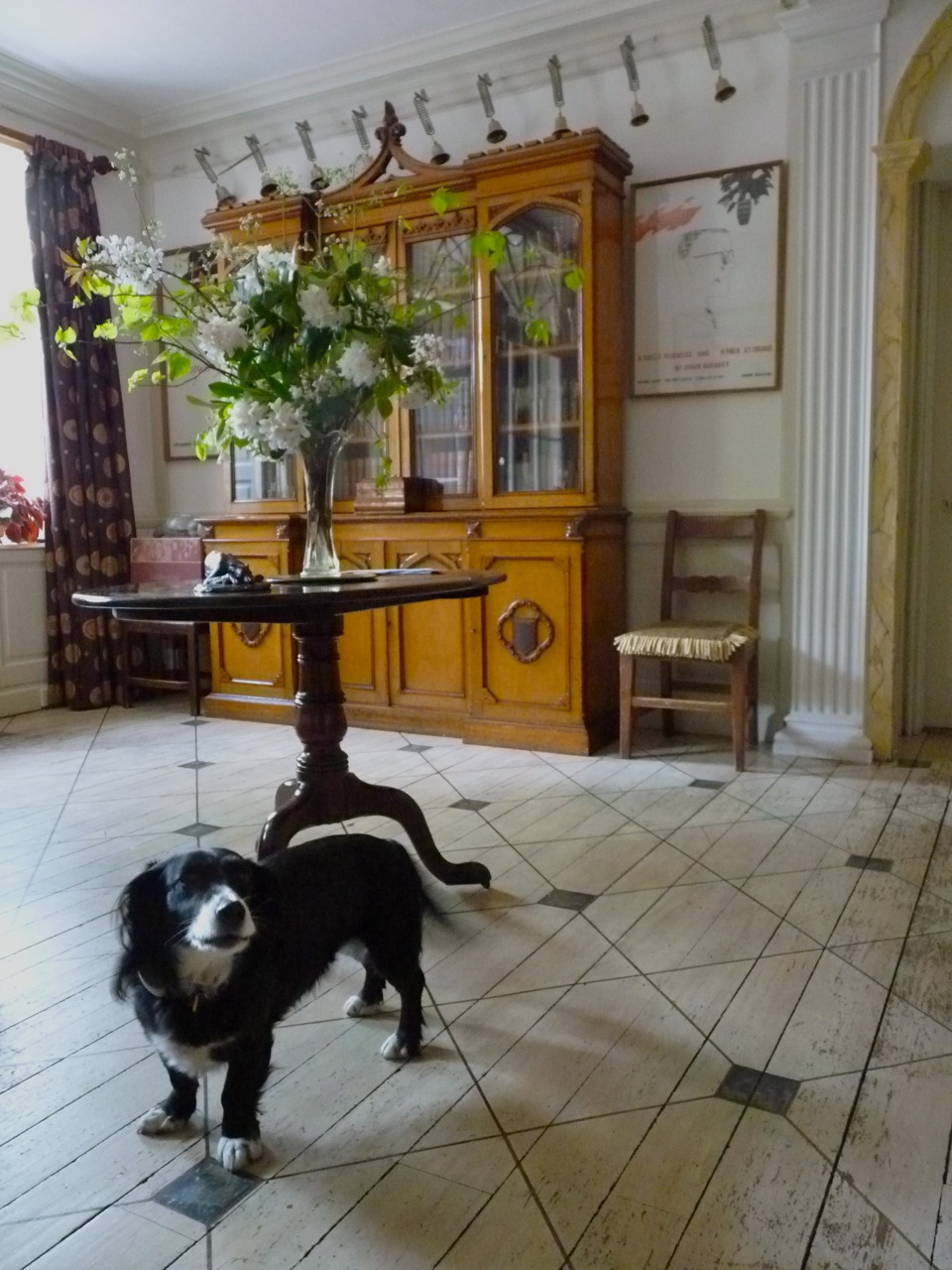
Domenica's father, the artists Harry More Gordon (b.1928) who died last year, taught at the Edinburgh College of Art. The painted hall floor was executed by two of his students. Bobs, one of two family dogs, the cheerful mongrel bitch whom he befriended on holiday in Greece.
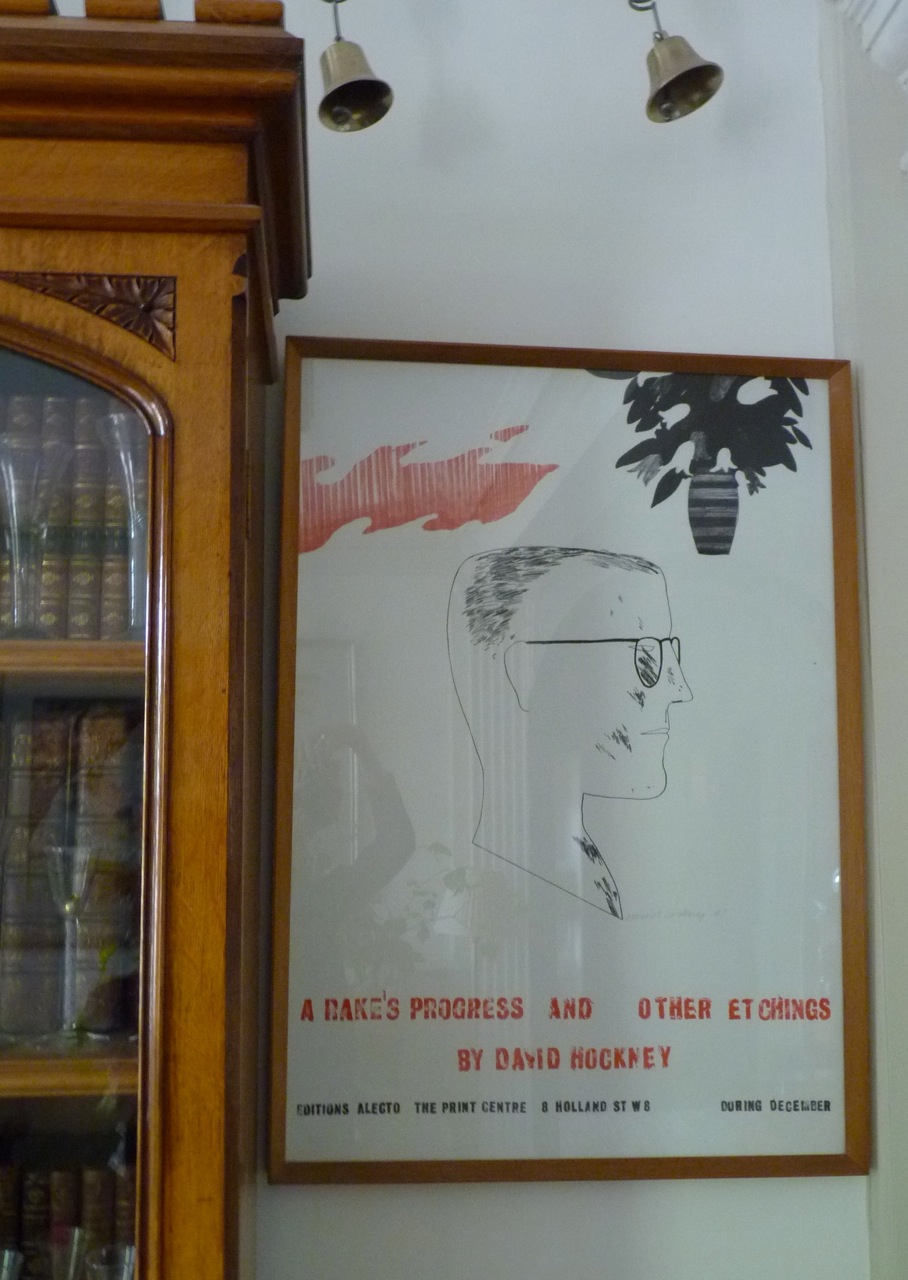
Harry's choice. An early Hockney poster, The Rake's Progress.
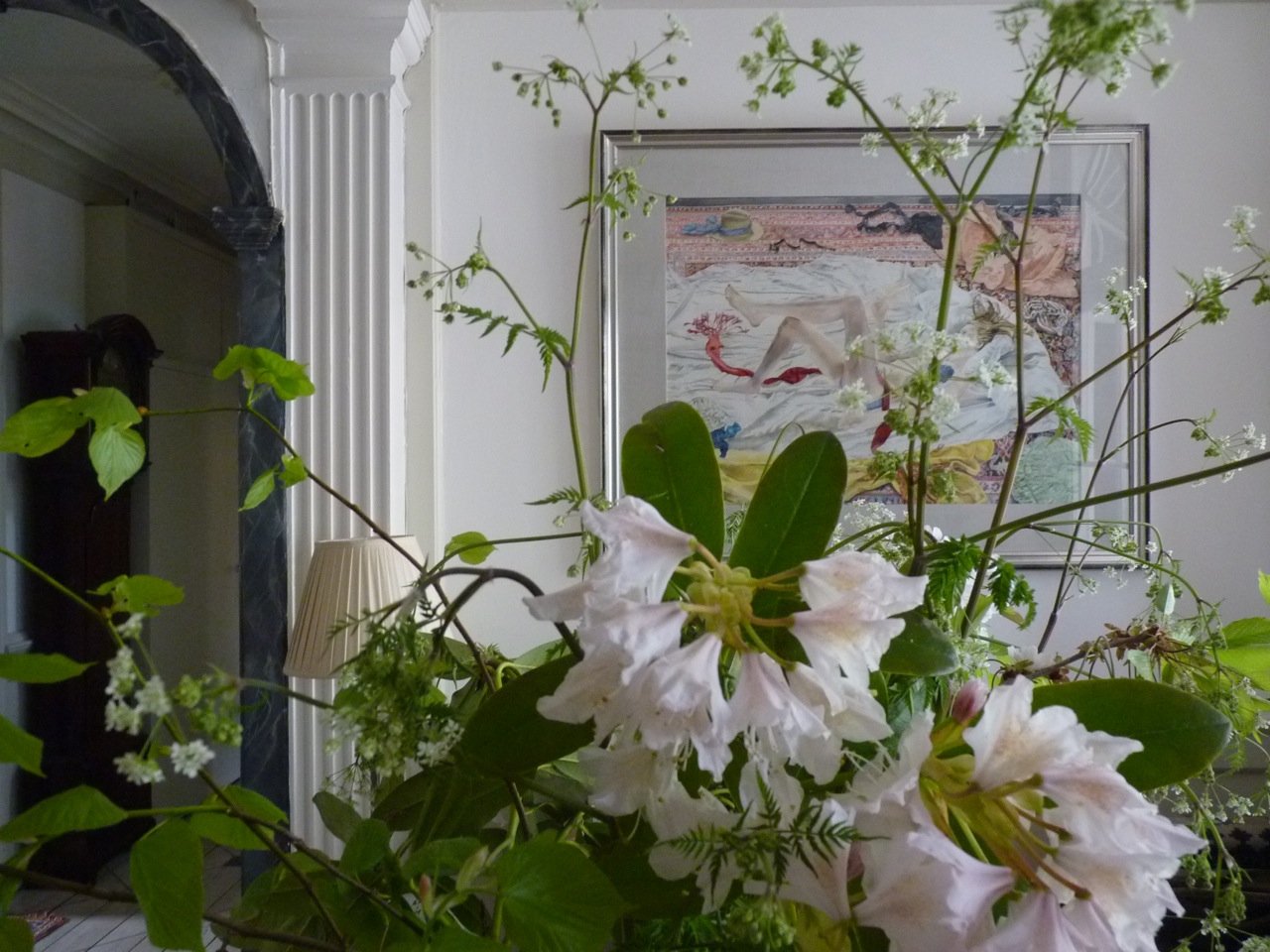
Harry's painting of Domenica, garden flowers.
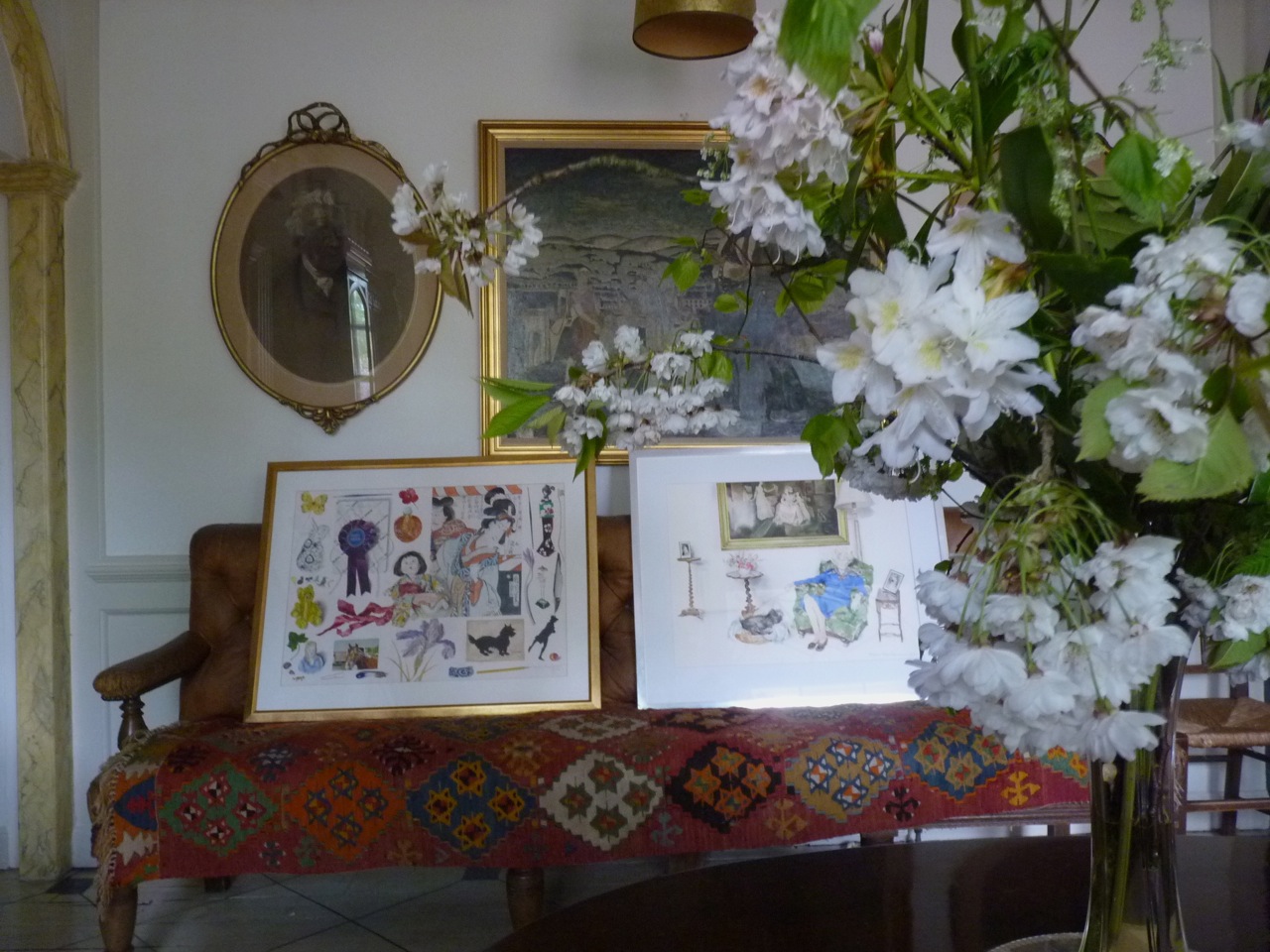 And two more of his watercolour portraits propped on the hall bench.
And two more of his watercolour portraits propped on the hall bench.
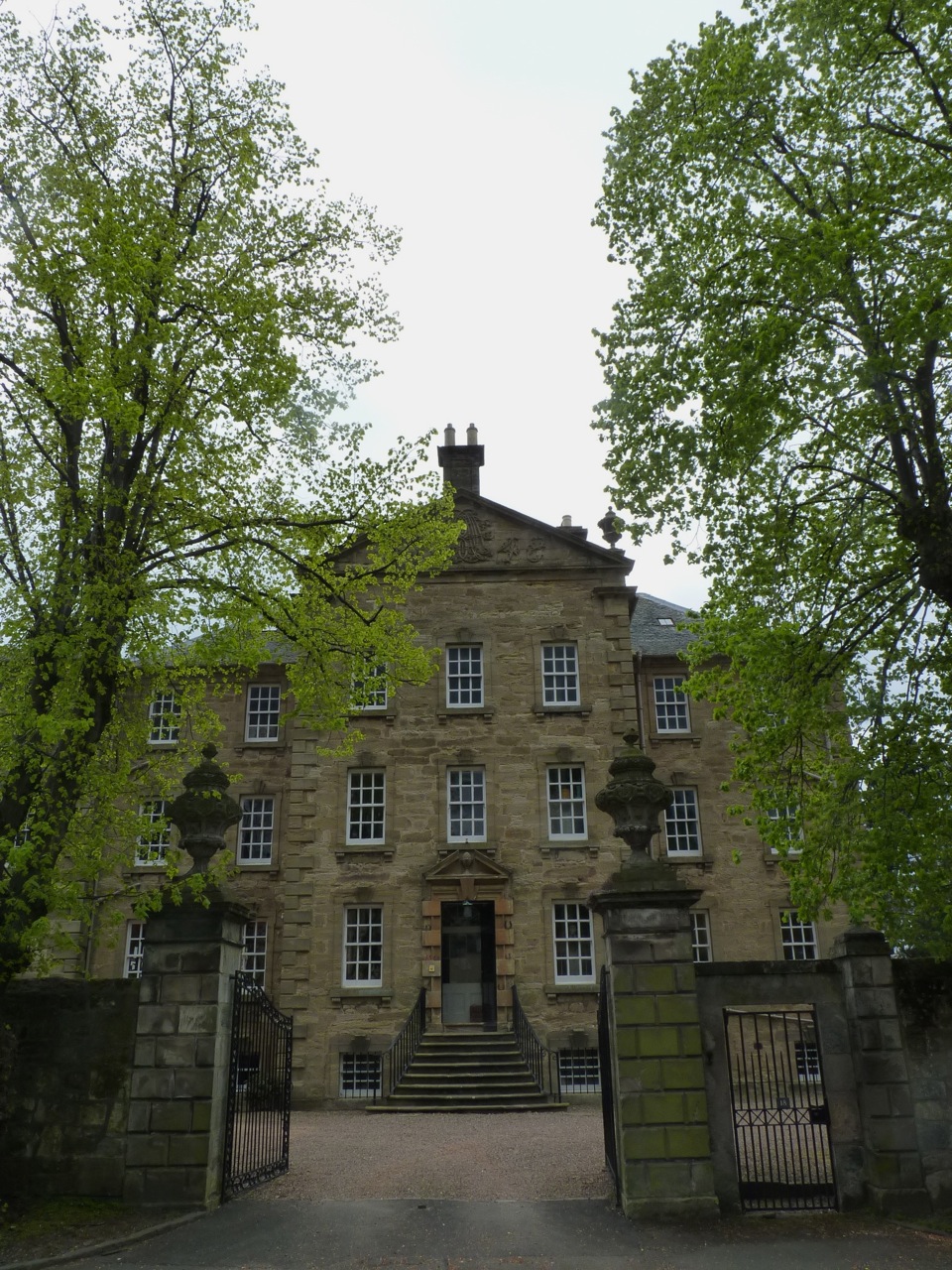
The house,a few miles north of Edinburgh towards the sea, austere, sandstone, dated 1748 in the pediment, built for Archibald Shiells. Domenica's parents Harry and Marianne, bought it in run-down state in the 1960s when she was three years old. They found its furnishings in local auctions and junkyards.
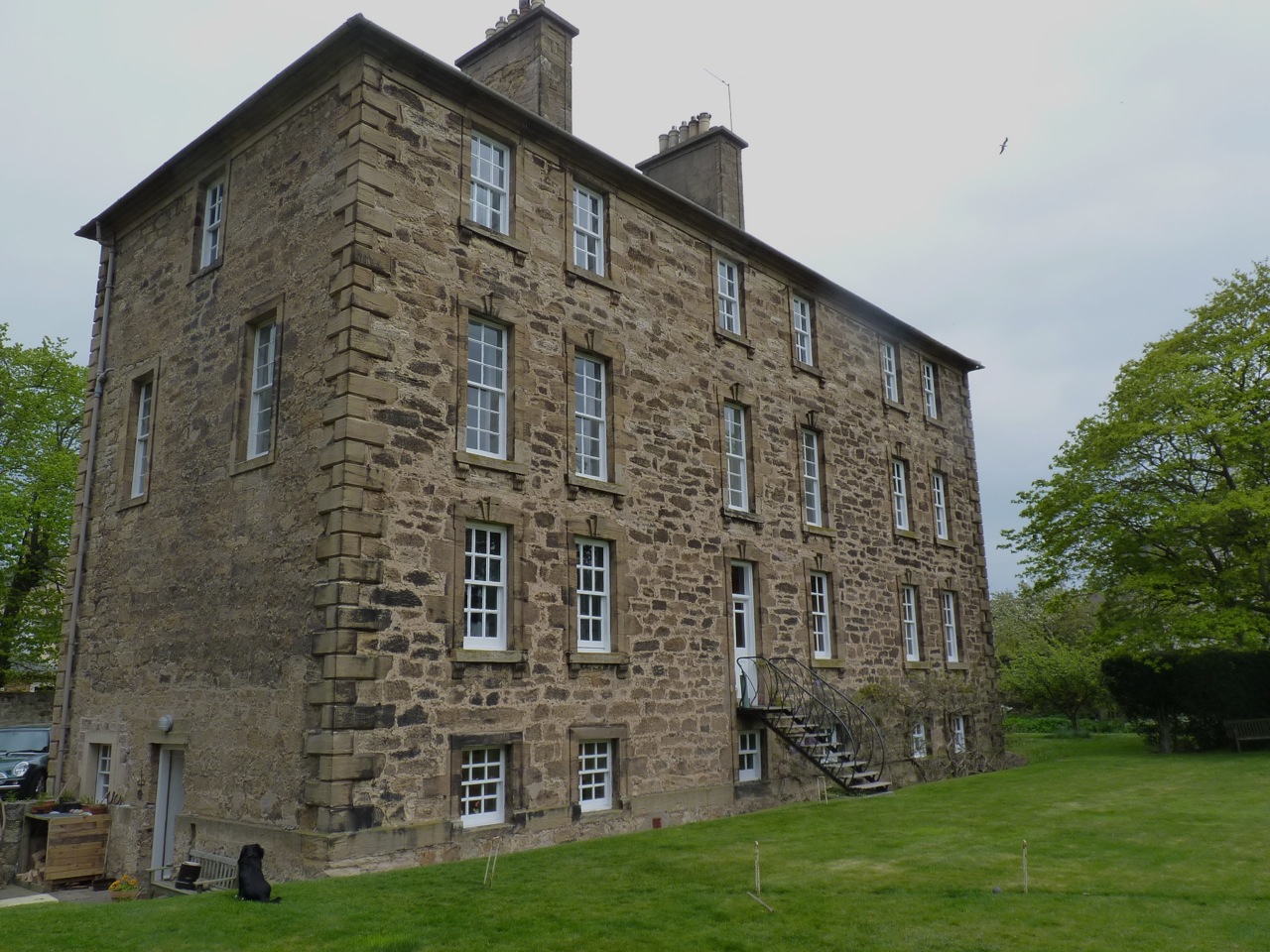
And the back, with dog, semi-couchant.
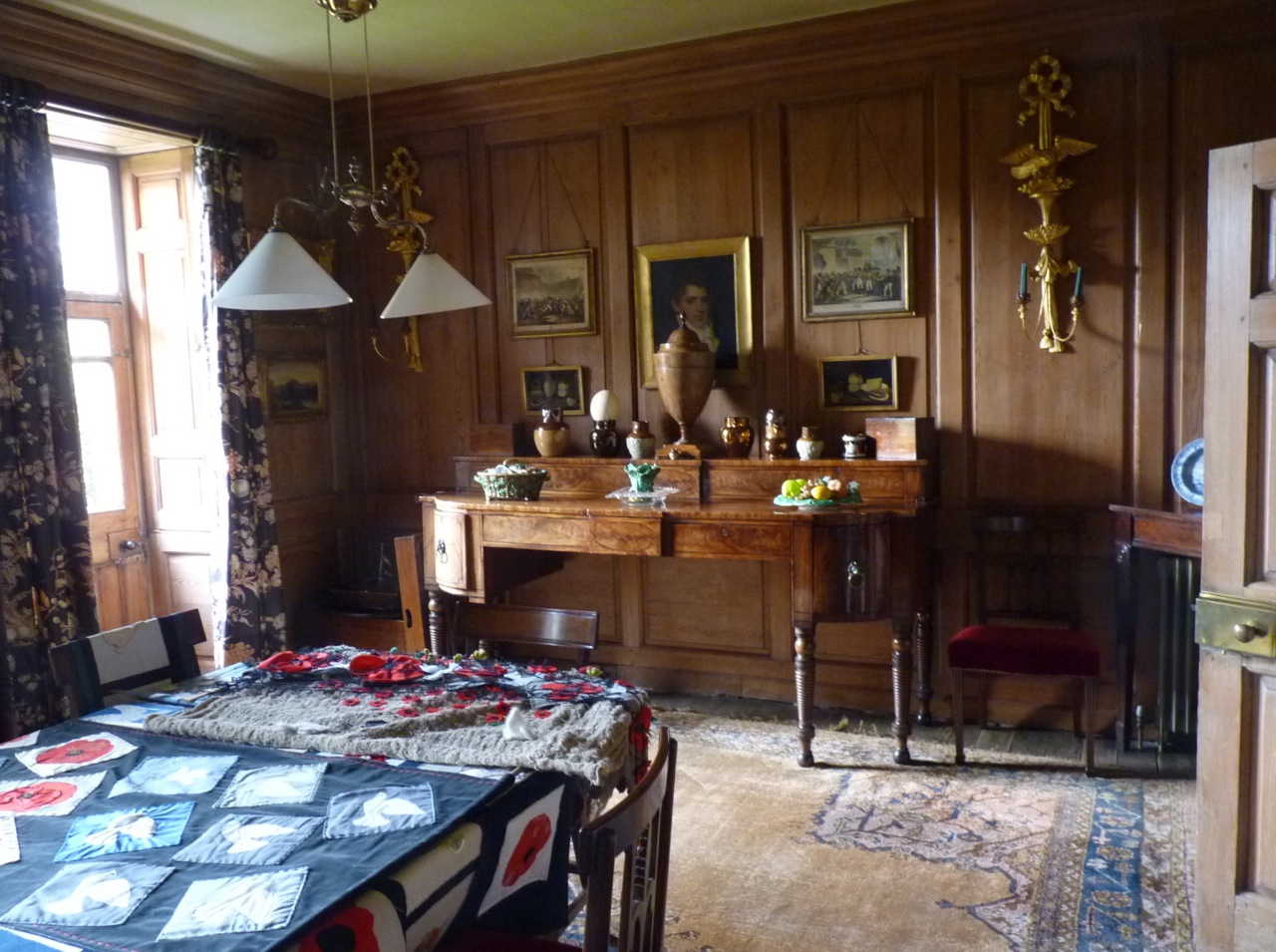
Dining Room. Marianne More Gordon's textile hangings made with a local community sewing group for Remembrance Sunday 2015 appliqued with doves and poppies, the work in progress on the table.
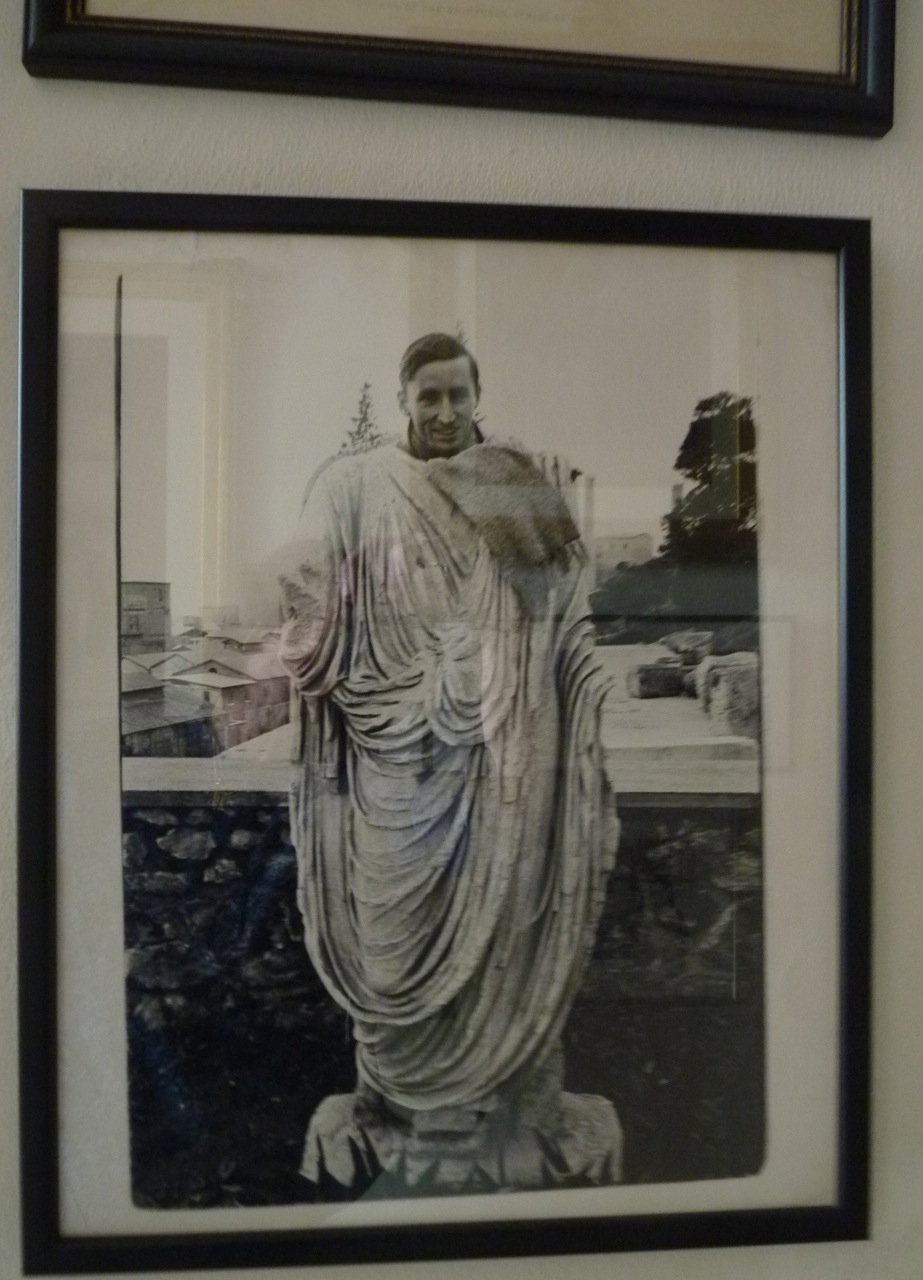
Harry More Gordon, lively, outspoken, 'the best dancer ever, and unlike most fathers, never embarrassing', one time picture and layout editor at Vogue.
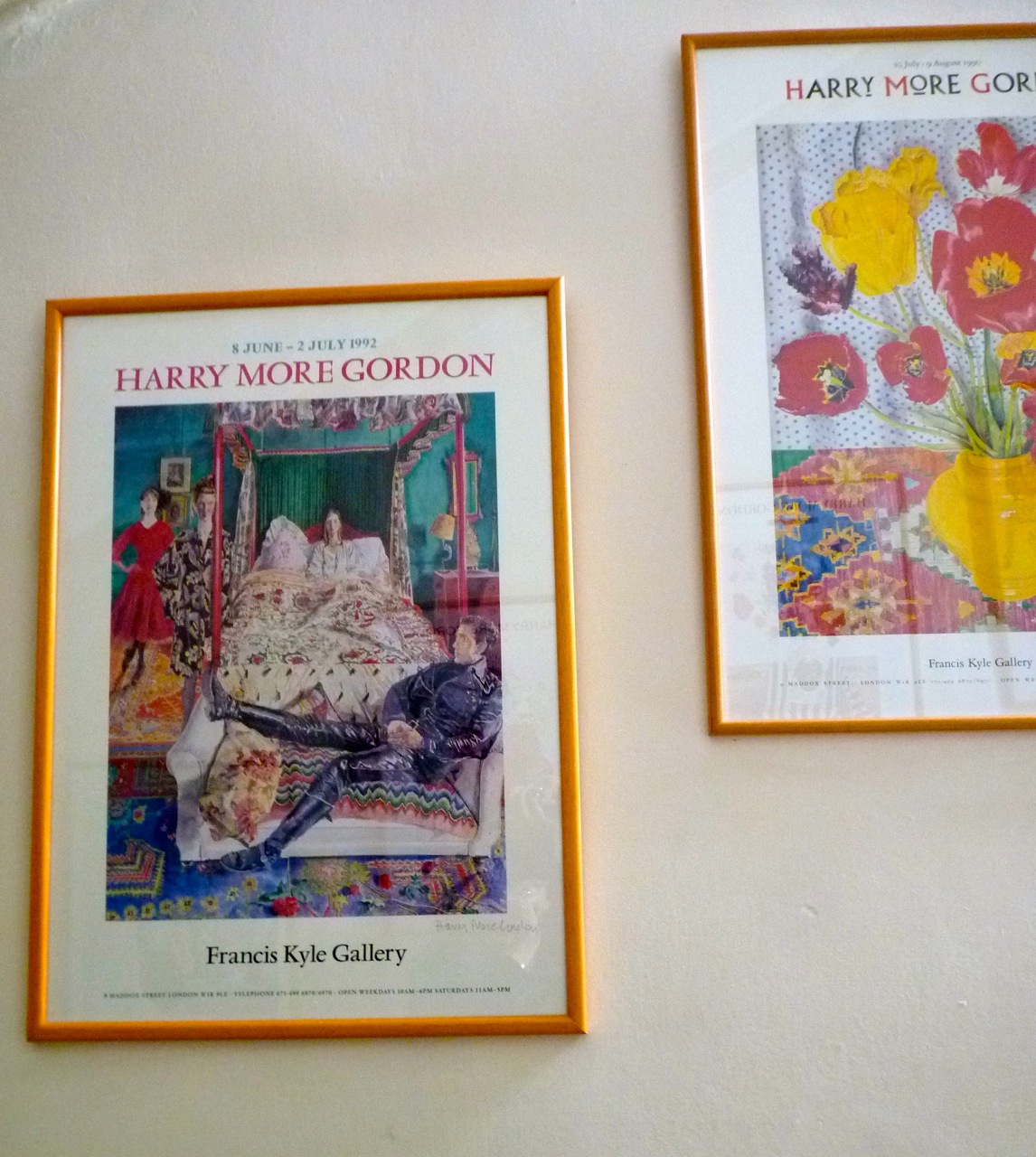
Francis Kyle exhibition poster, another family portrait. Domenica in bed and James Holloway, director of the Scottish Portrait Gallery at the time and a keen biker, on the sofa.Watch out for this four poster bed later on.
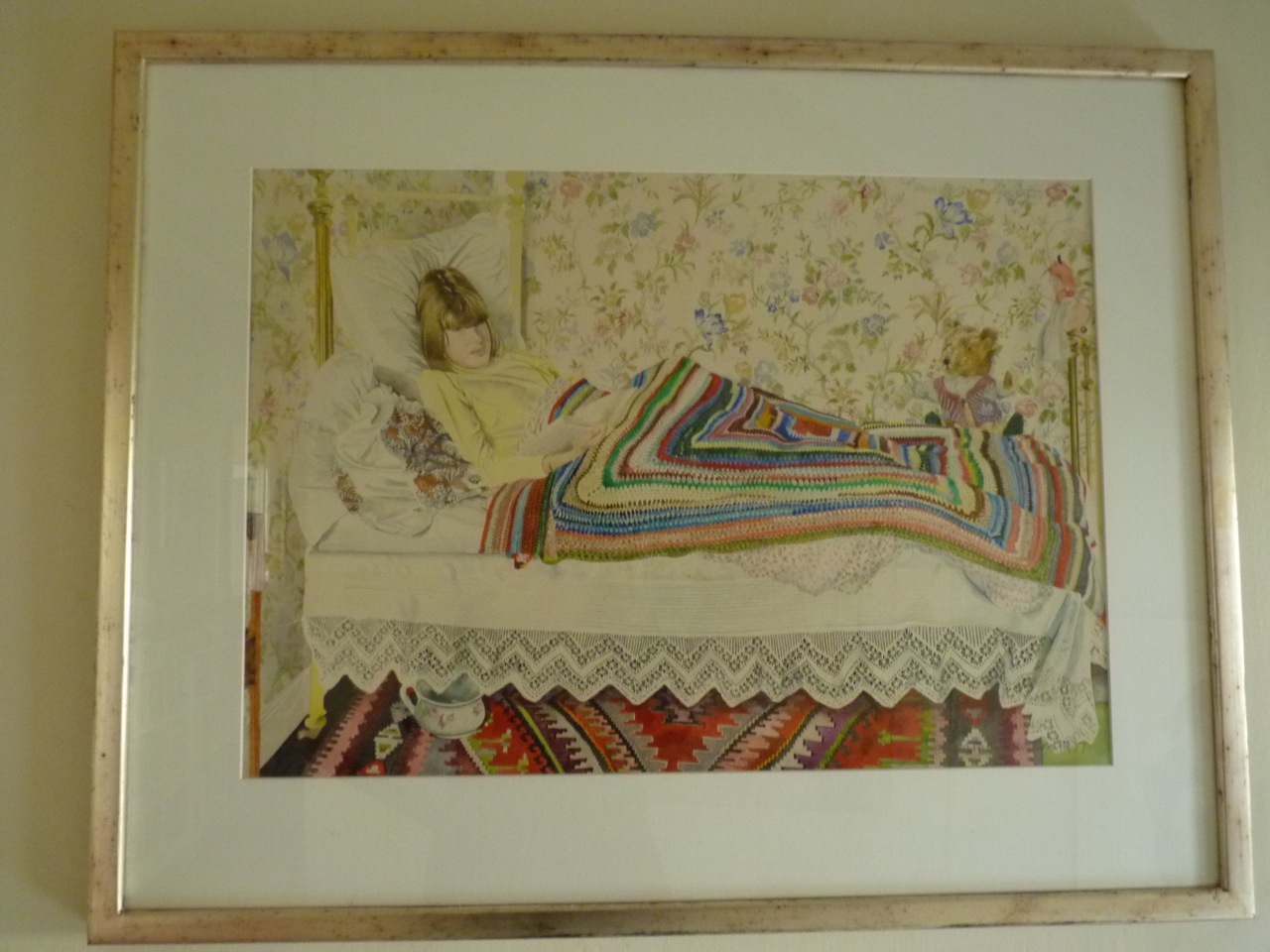
Domenica's younger sister Zillah, ill in bed. Harry More Gordon loved painting pattern and oriental fabric.
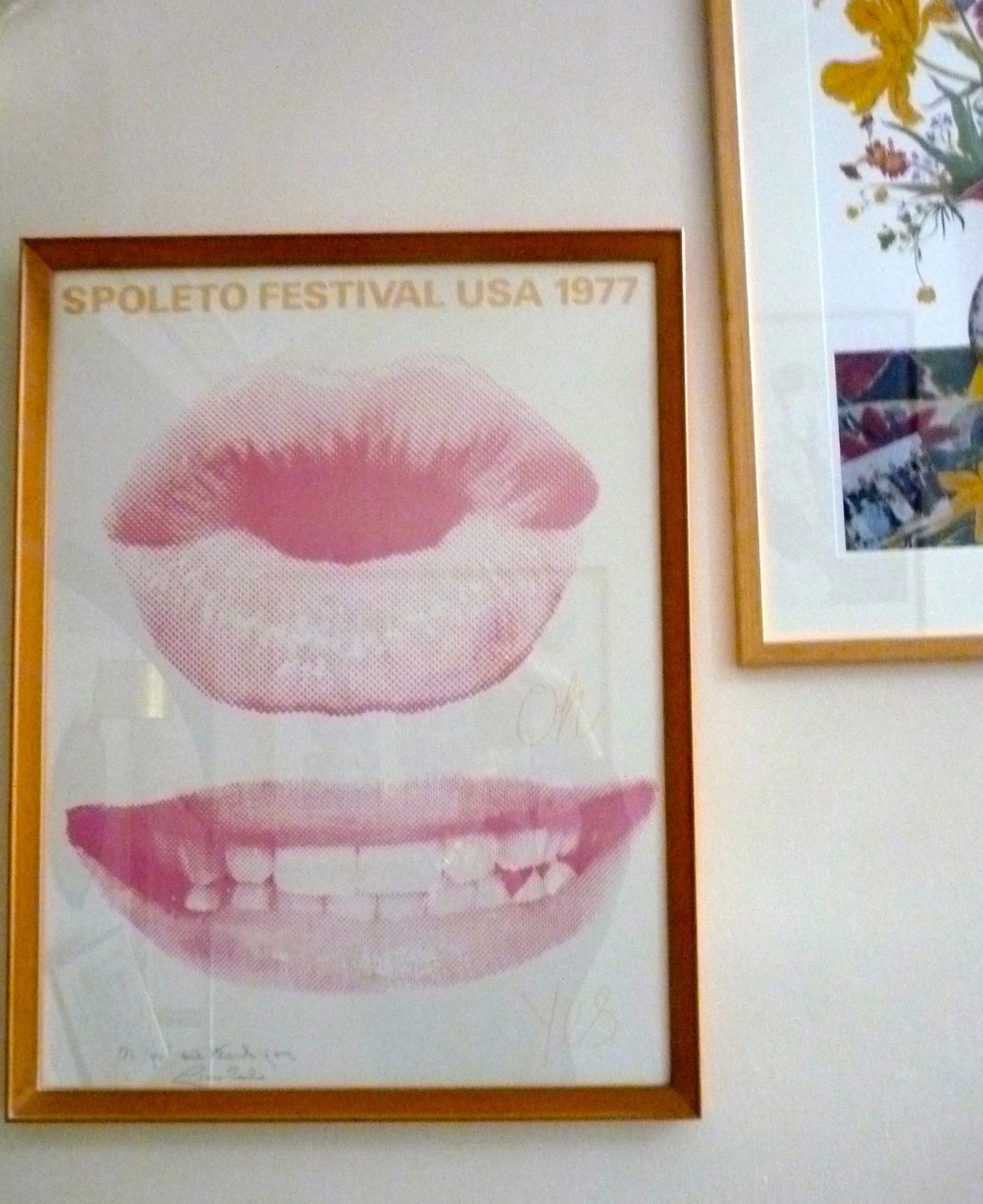
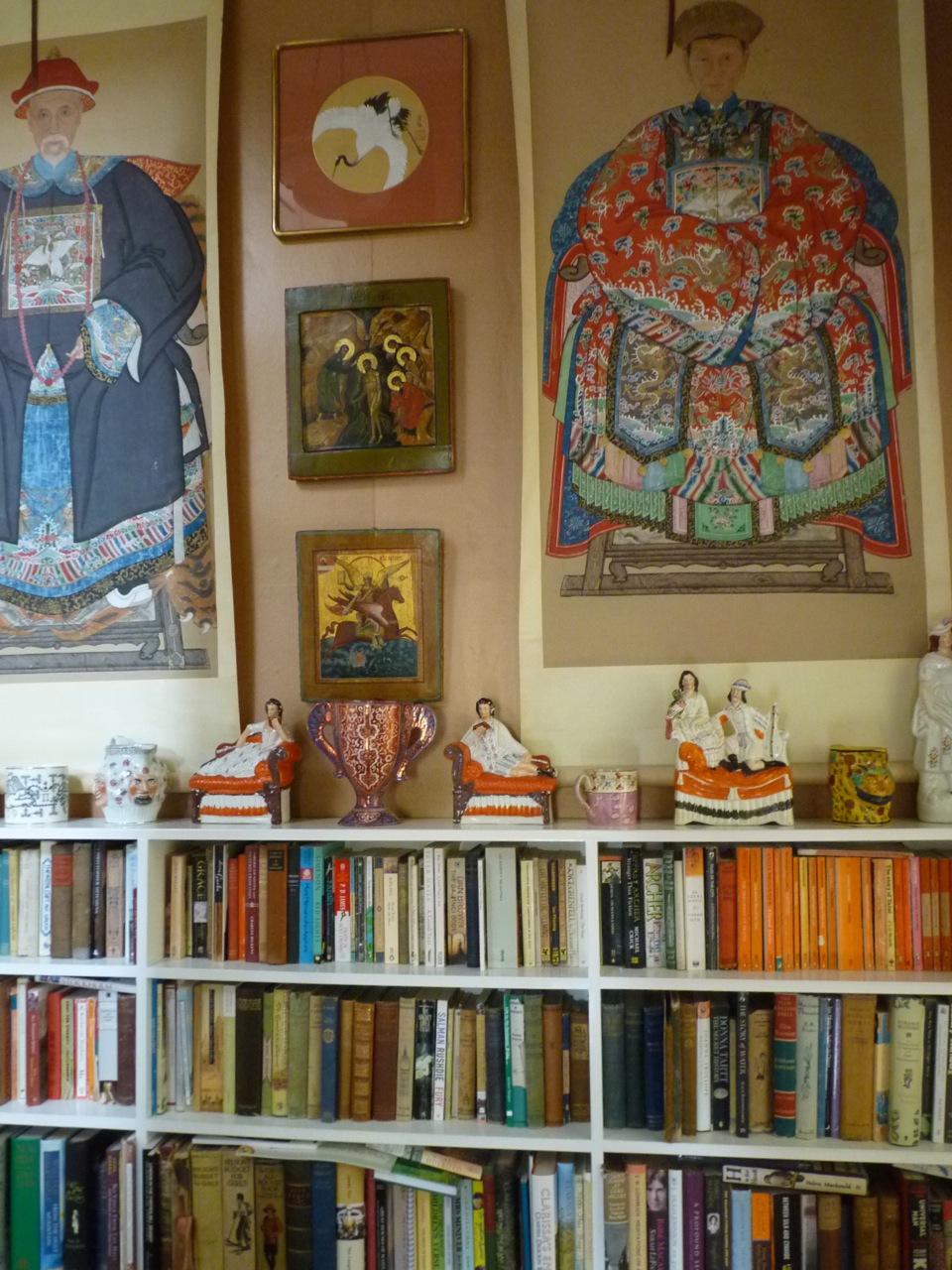
The first floor spine corridor, icons, Staffordshire porcelain and two Chinese portraits that Zillah gave to her parents.
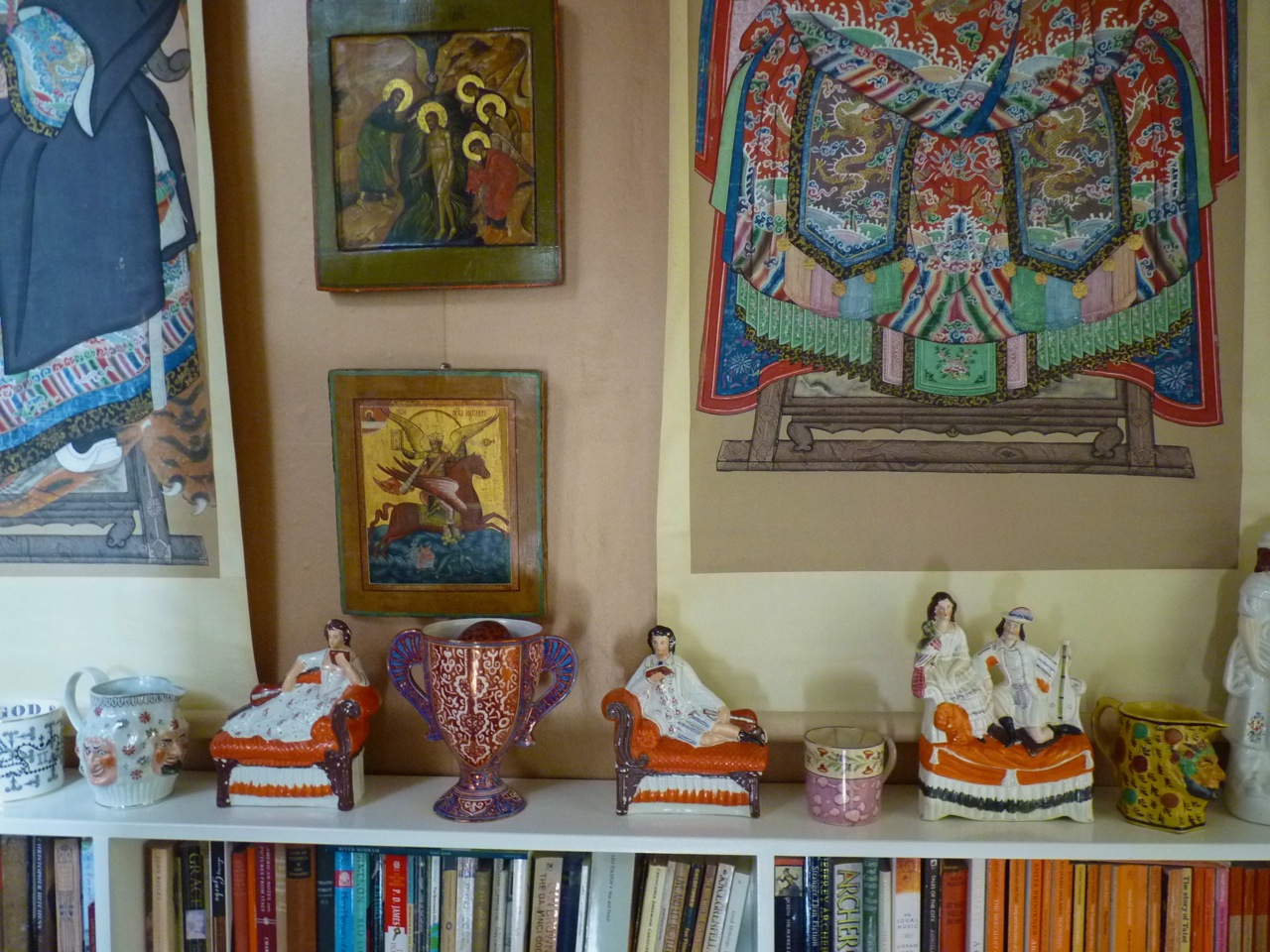
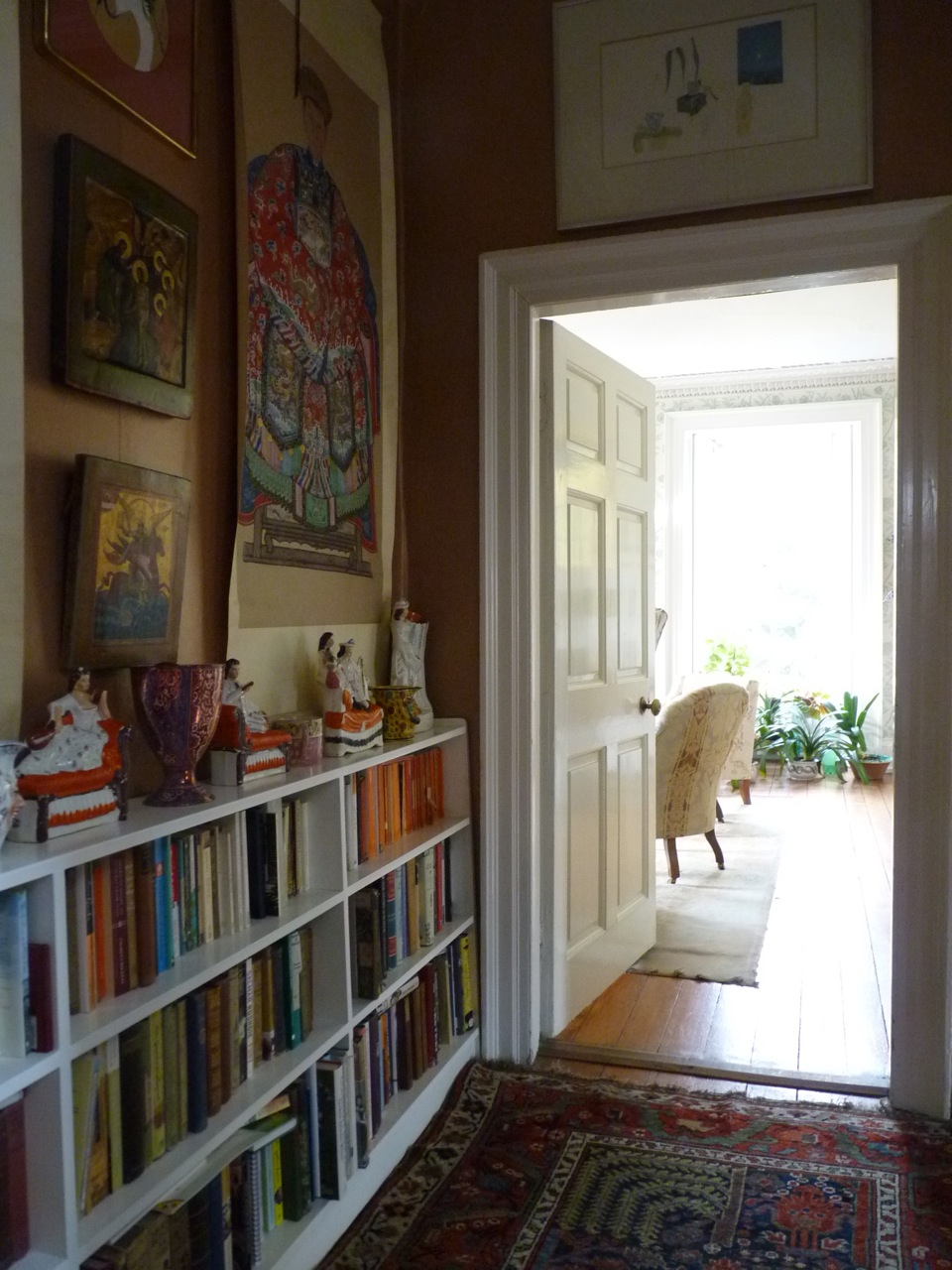
View into the Drawing Room.'Dad's taste was much more flamboyant, more twentieth century, whereas Mum would be much more eighteenth century, most of what is here is Mum's. This house is all about Mum and family and roots'.
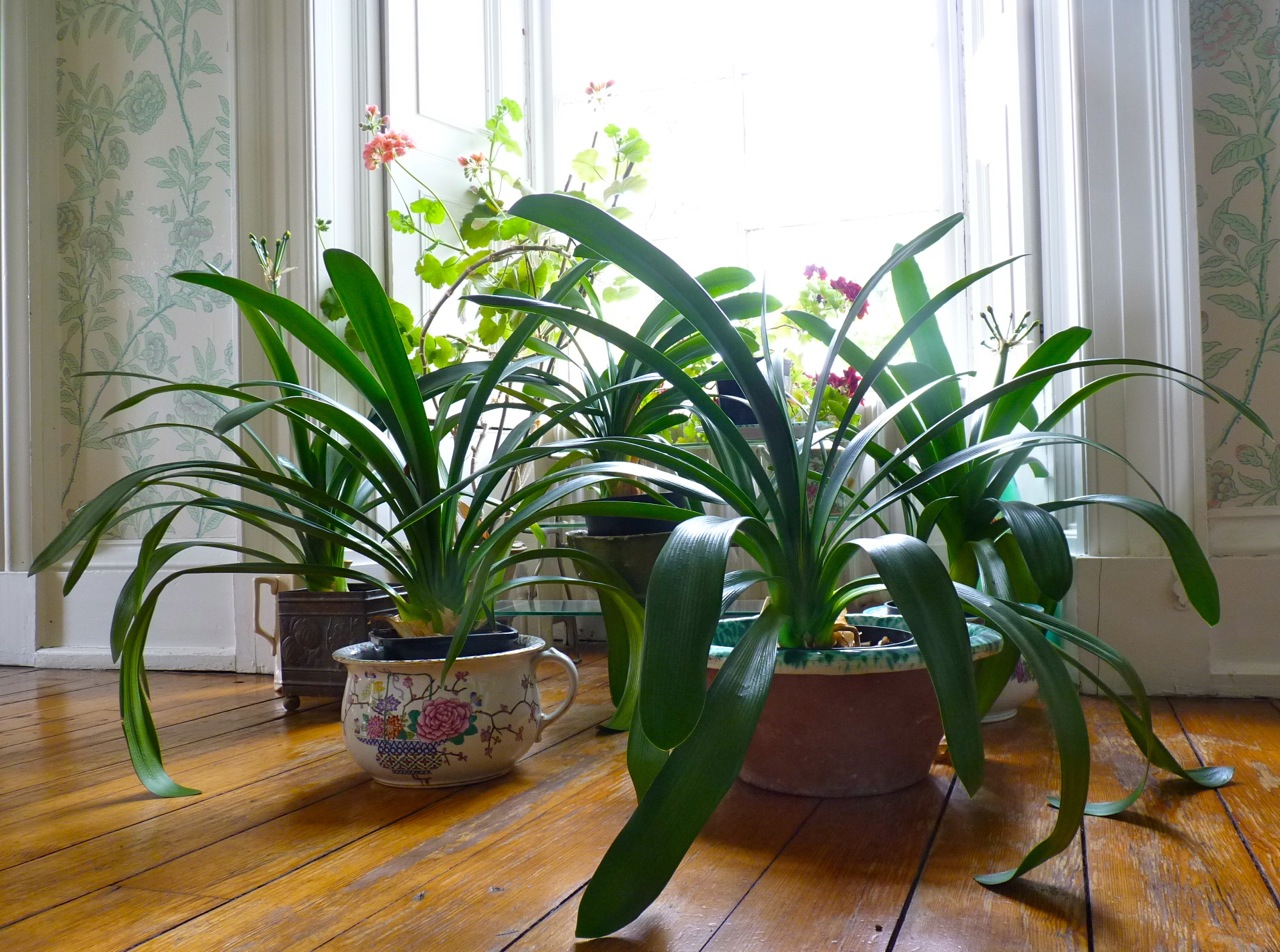
House plants, one in a chamber pot planter.
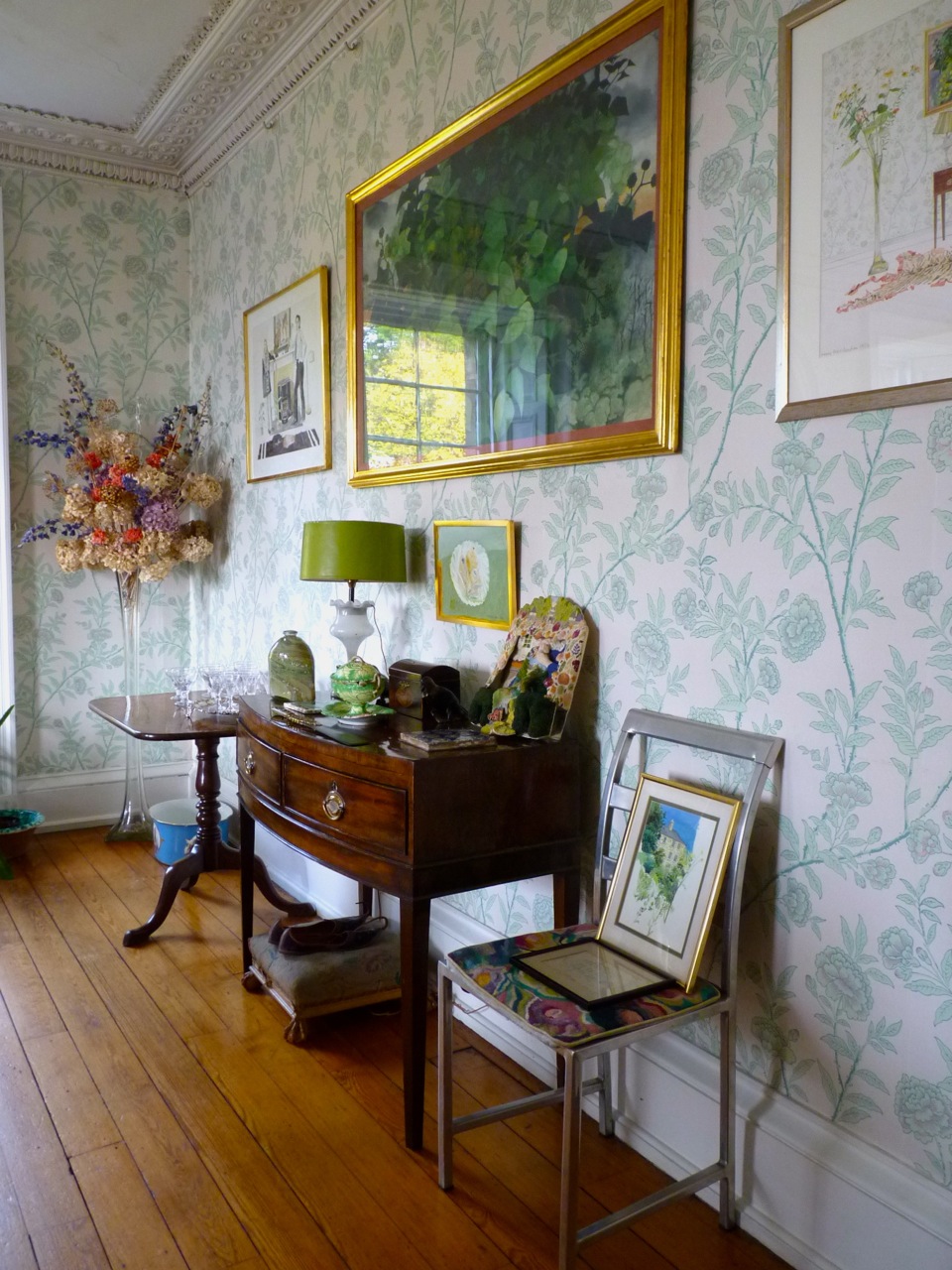
End wall of the Drawing Room, the next photograph is a detail of the watercolour by Harry More Gordon hanging on the right.
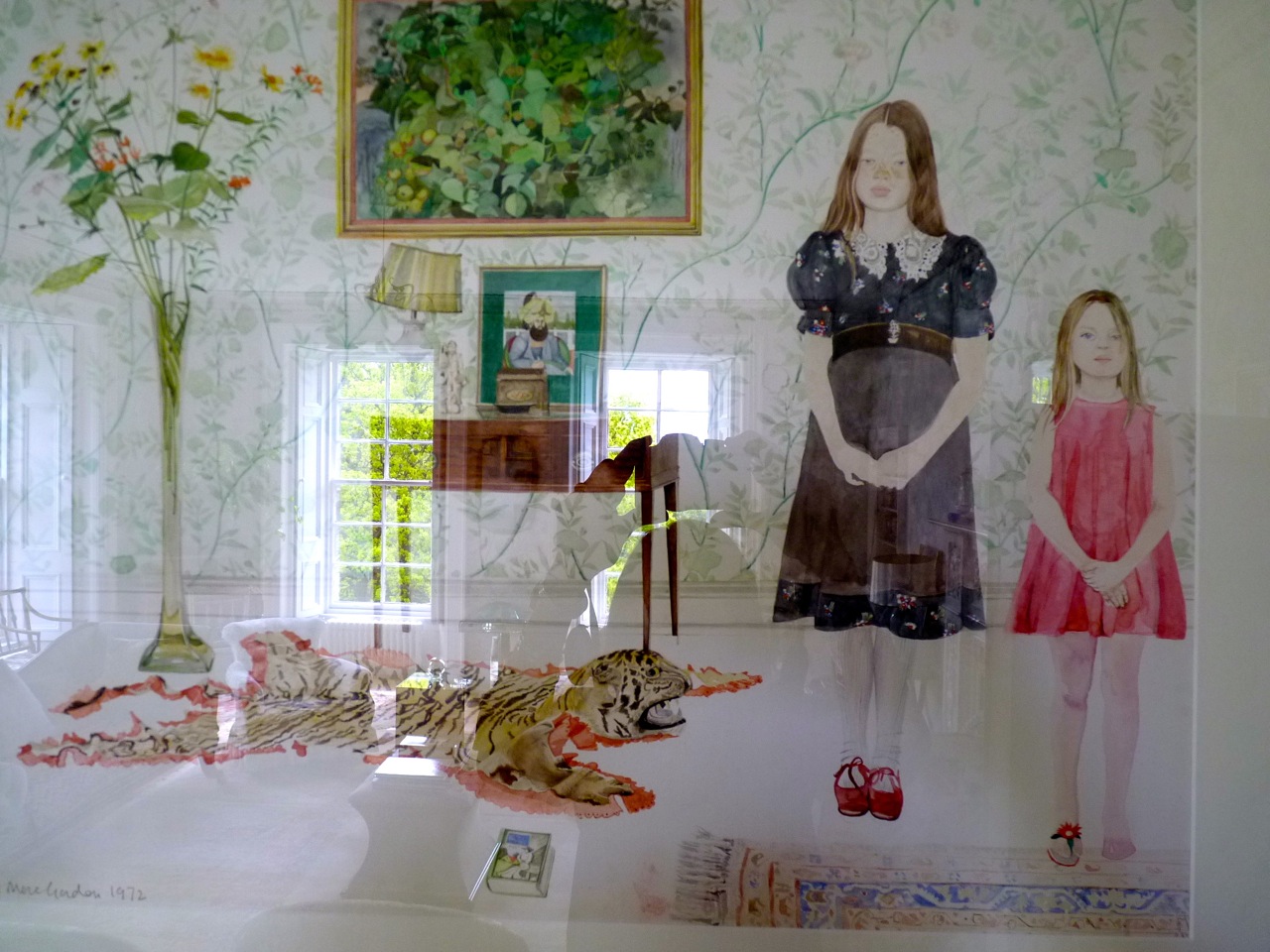
Domenica, Zillah and tigerskin rug painted on the same spot.
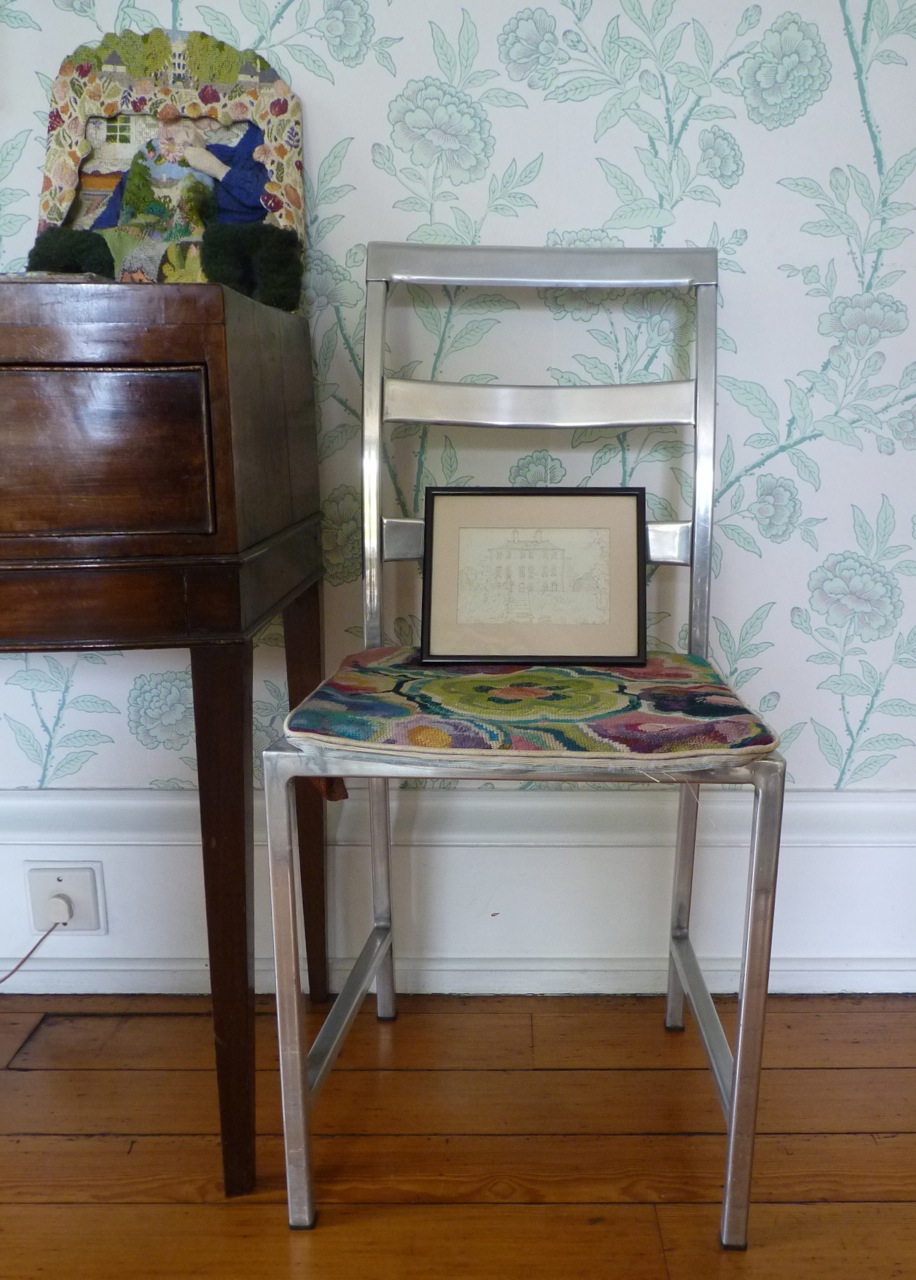
Seat cushion and 3D textile (detail below) by Marianne More Gordon [nee Thompson-McCauseland], who trained at the Central School of Art. This house with its aqueous colour and pattern is another of her works of art.
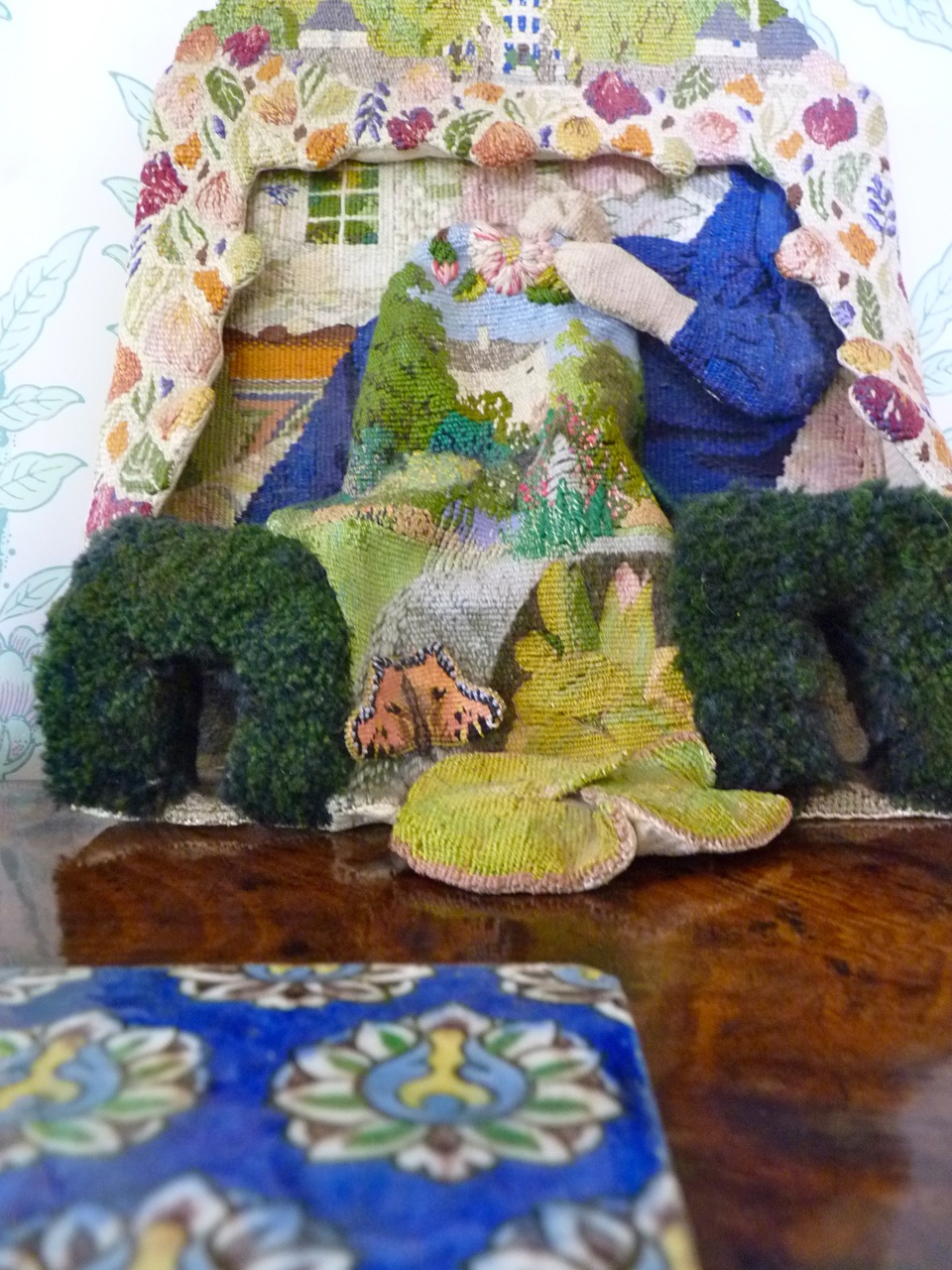
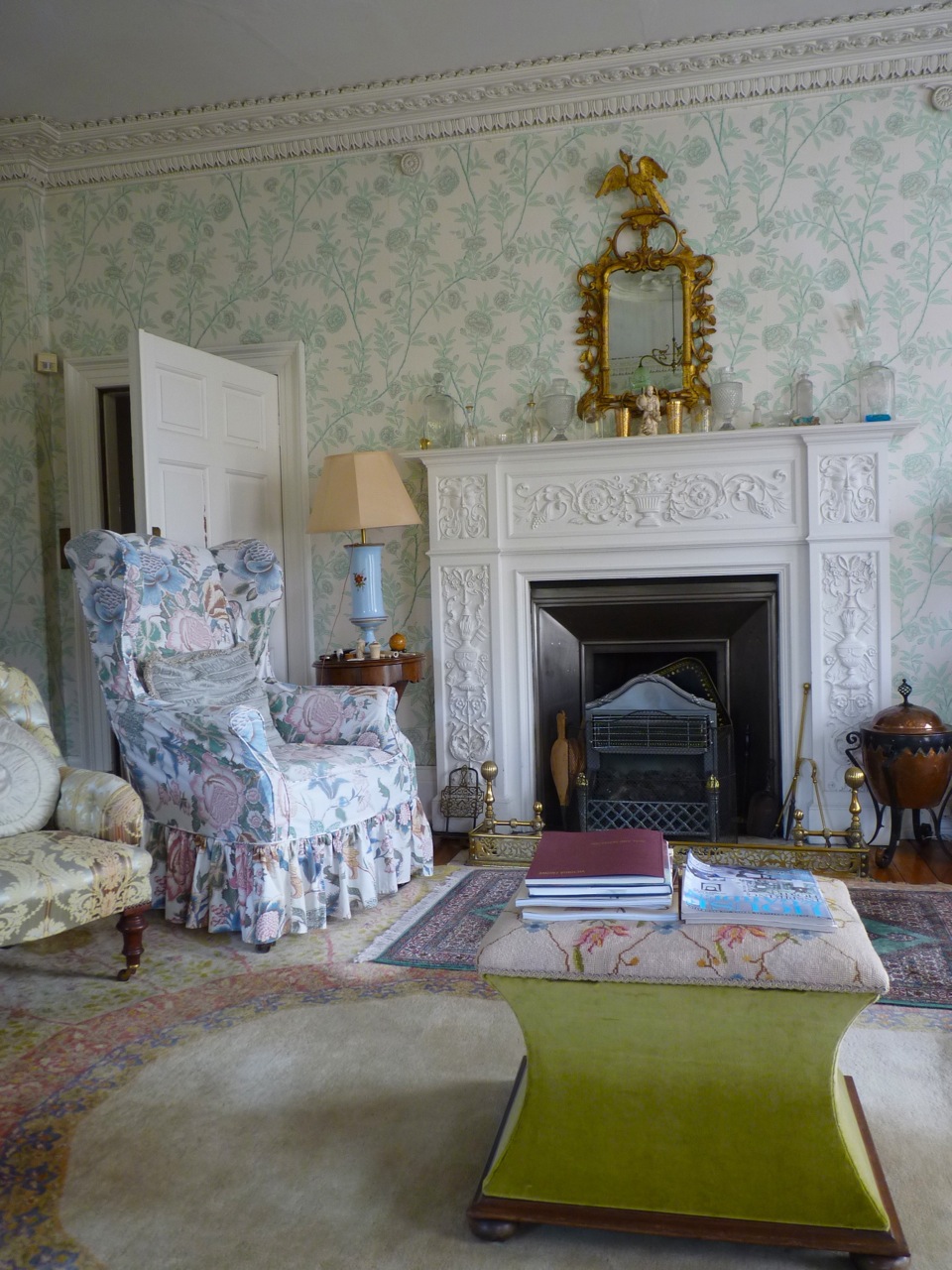
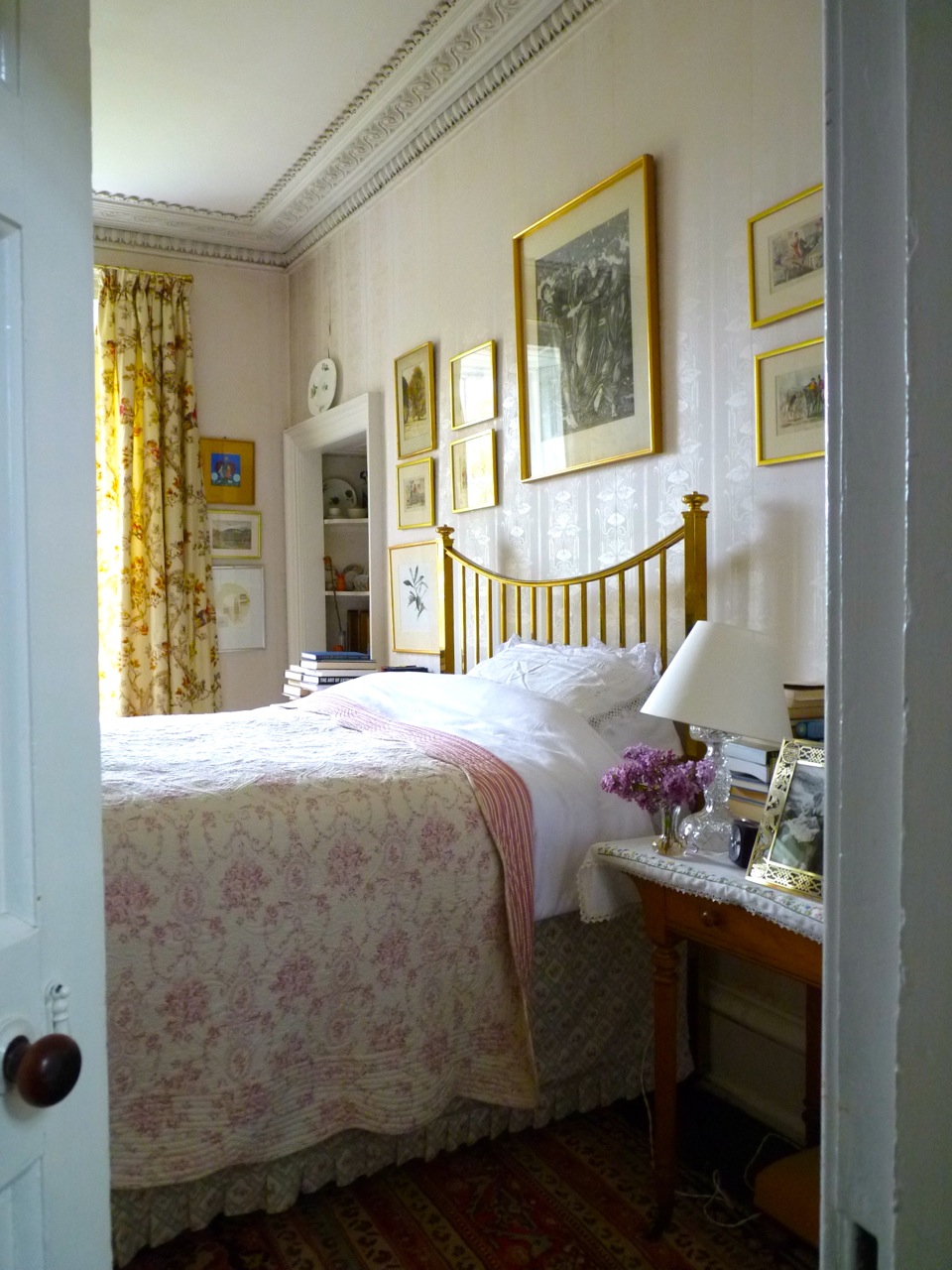
Marianne's bedroom.
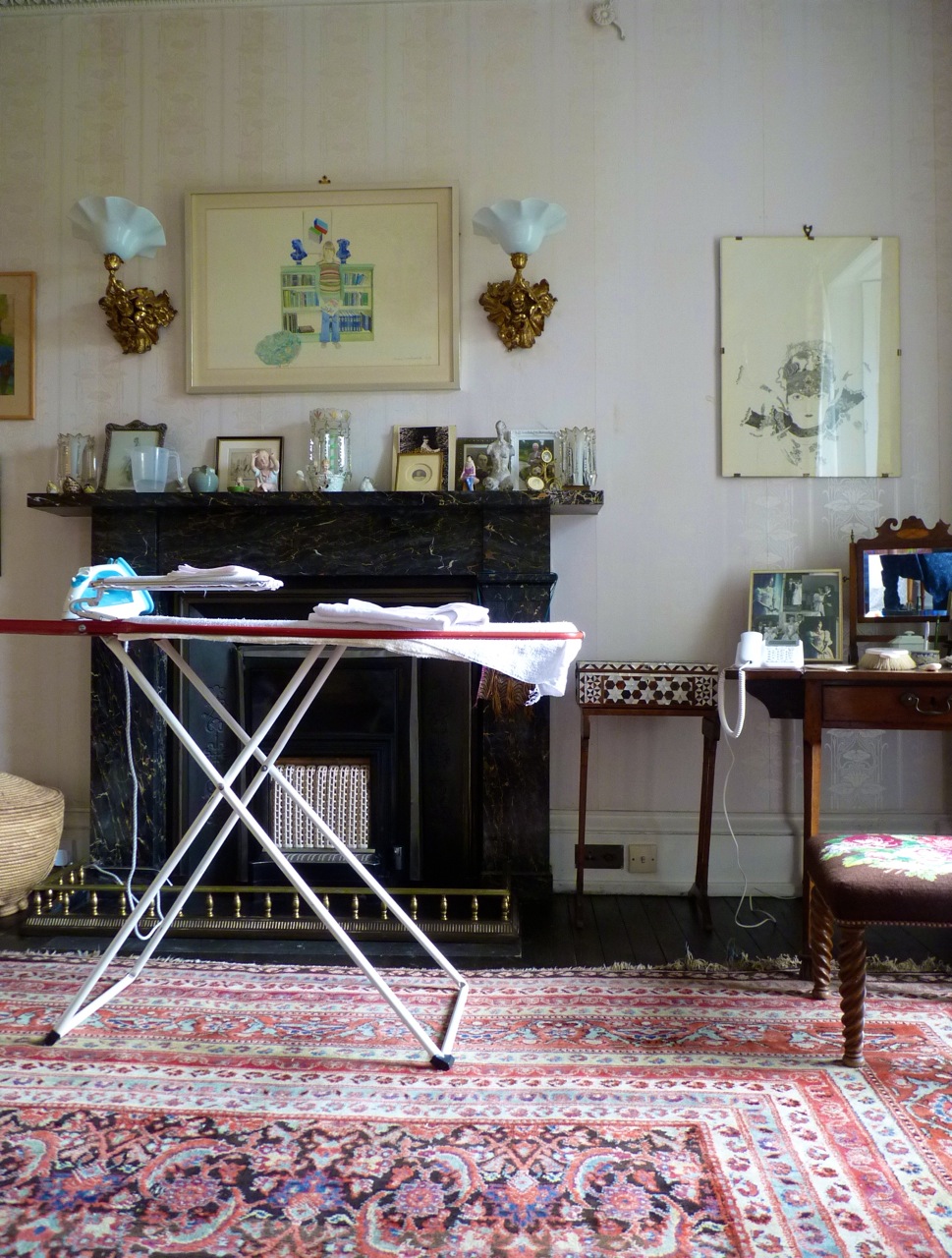
Ditto, with ironing board.
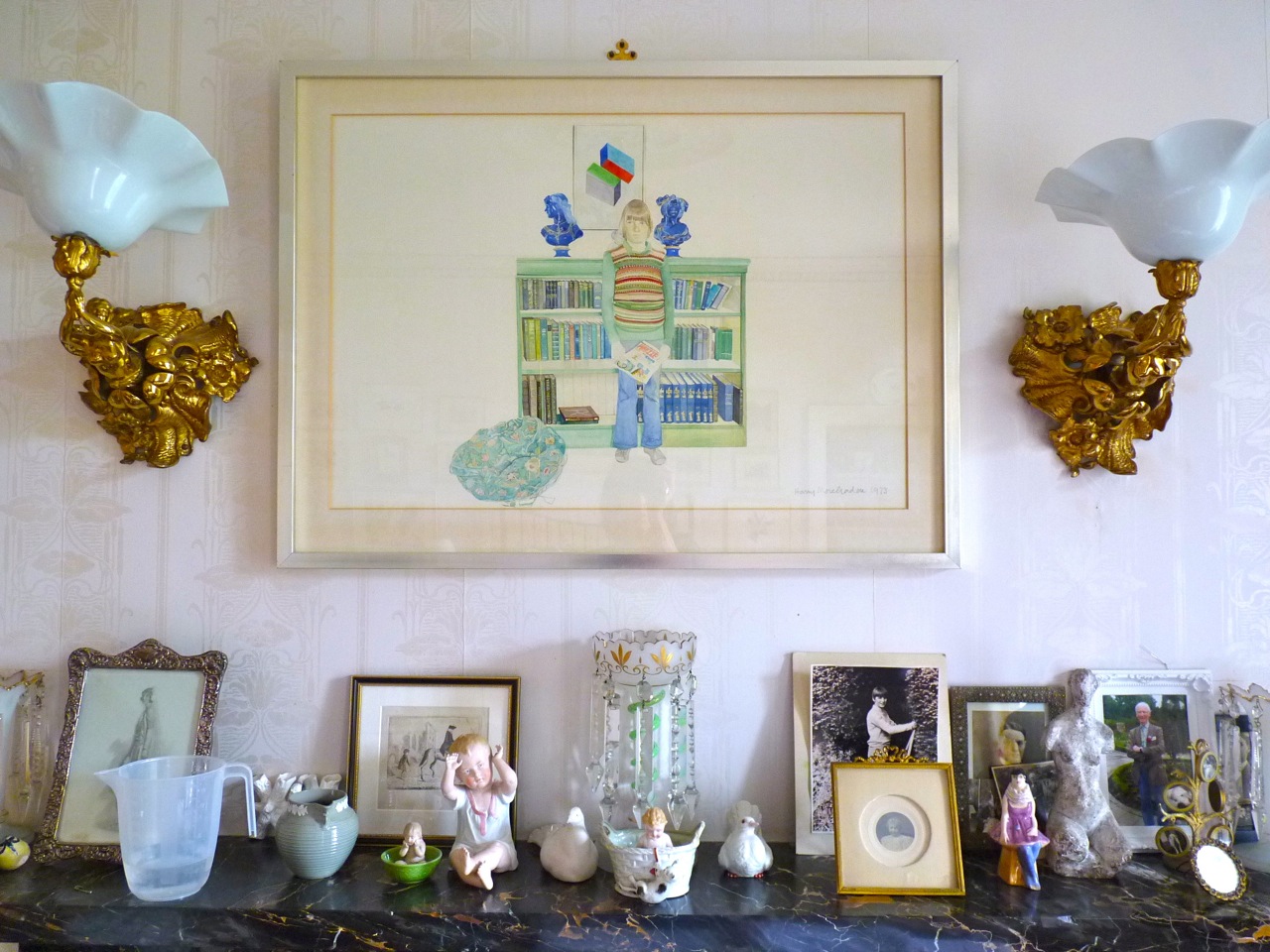
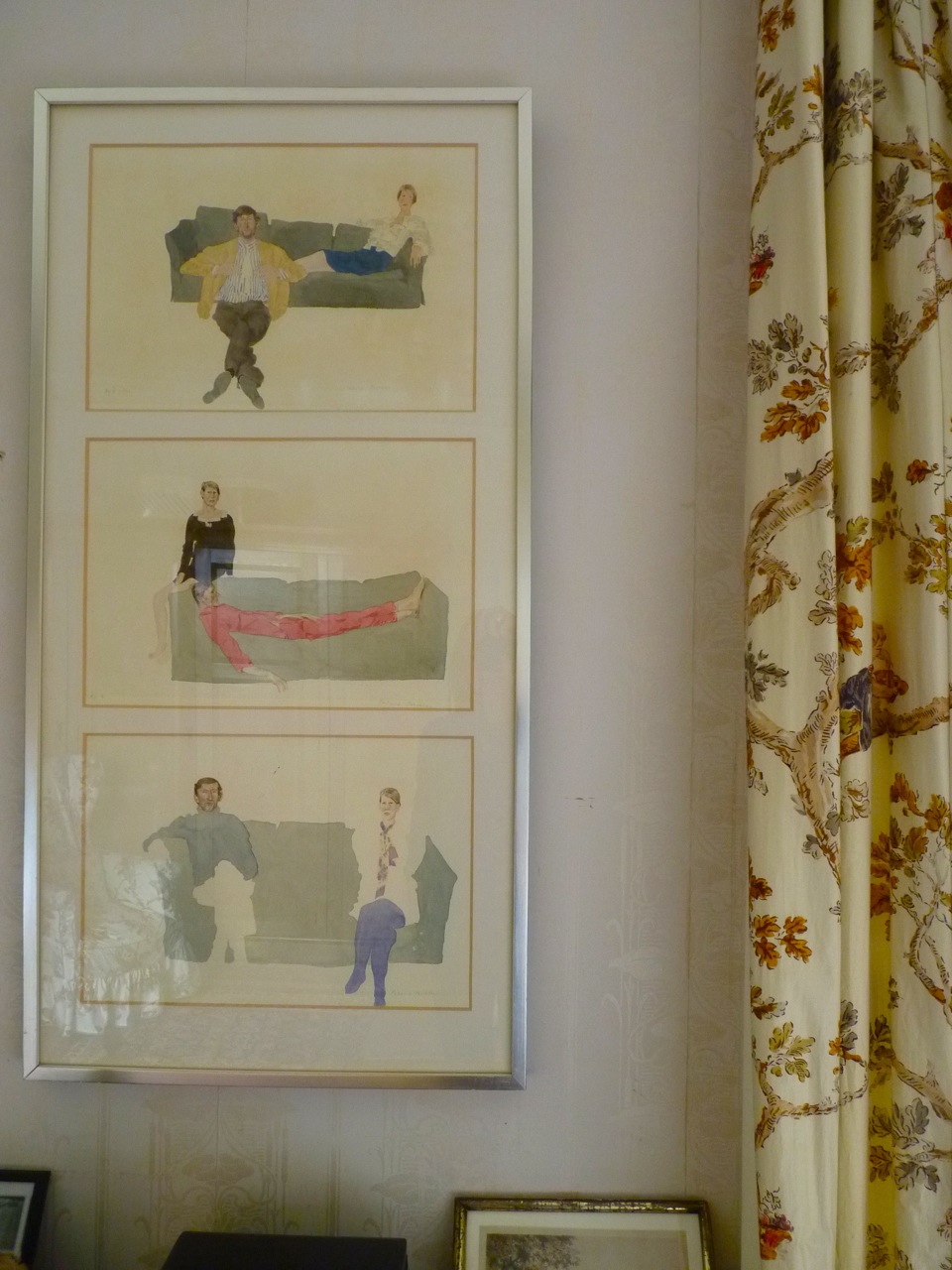
Harry and Marianne painted in 3 poses by their friend, Patrick Procktor, who inspired Harry to use watercolour without any preliminary pencil drawing thereafter.
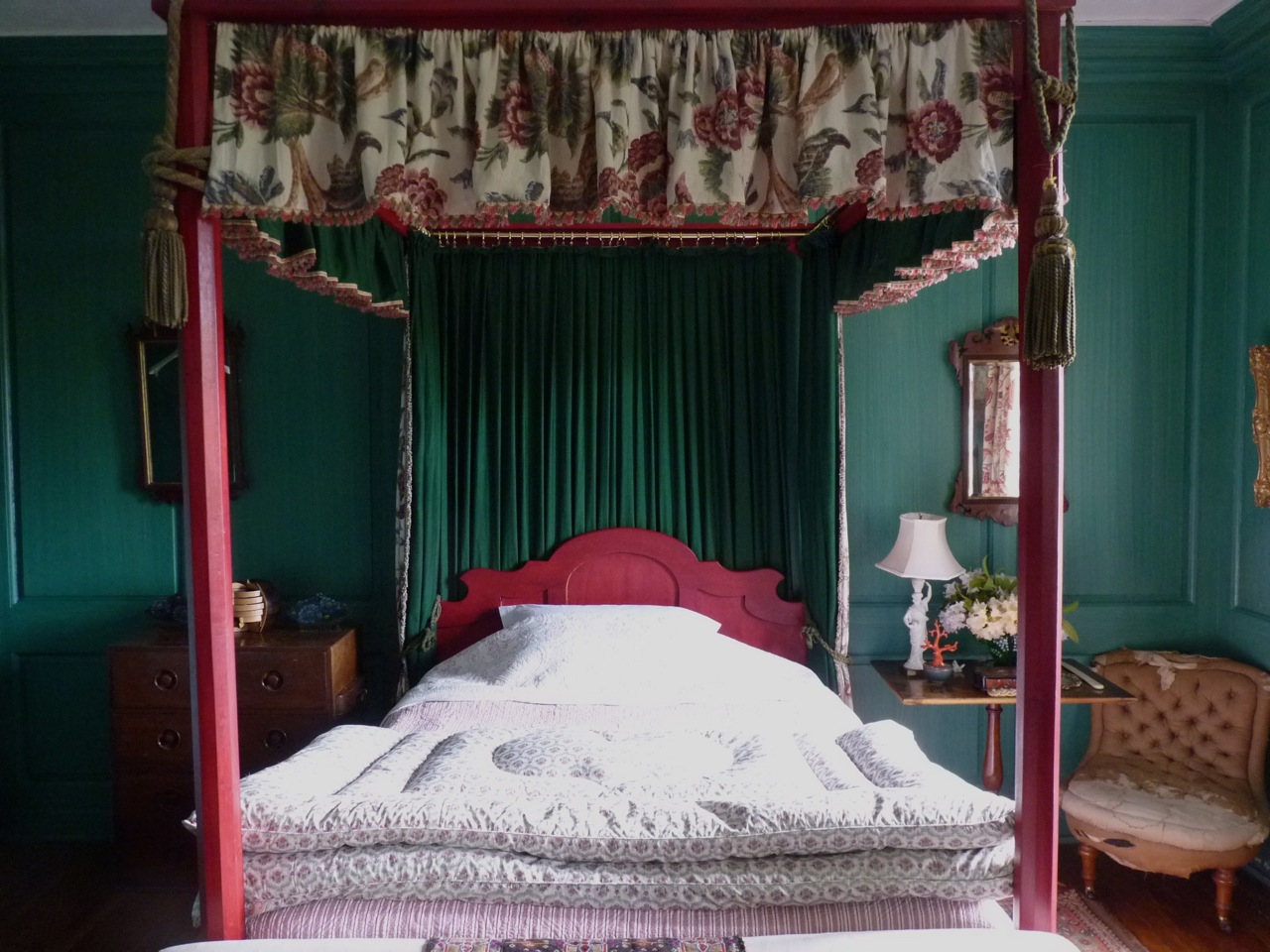
The crimson bed in that poster, hung by Marianne with a document linen bought at a local junk yard that she painstakingly washed and restored.
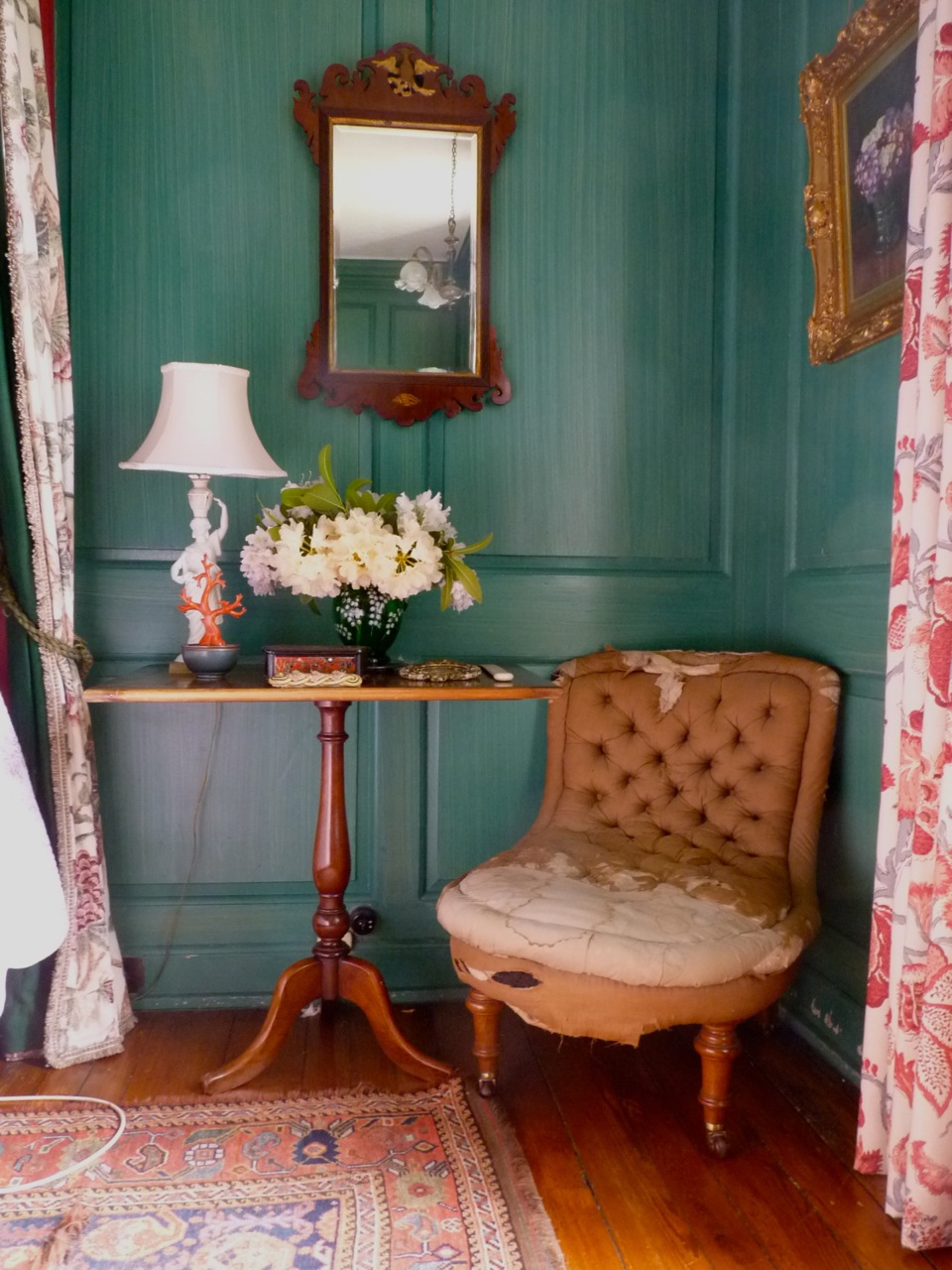
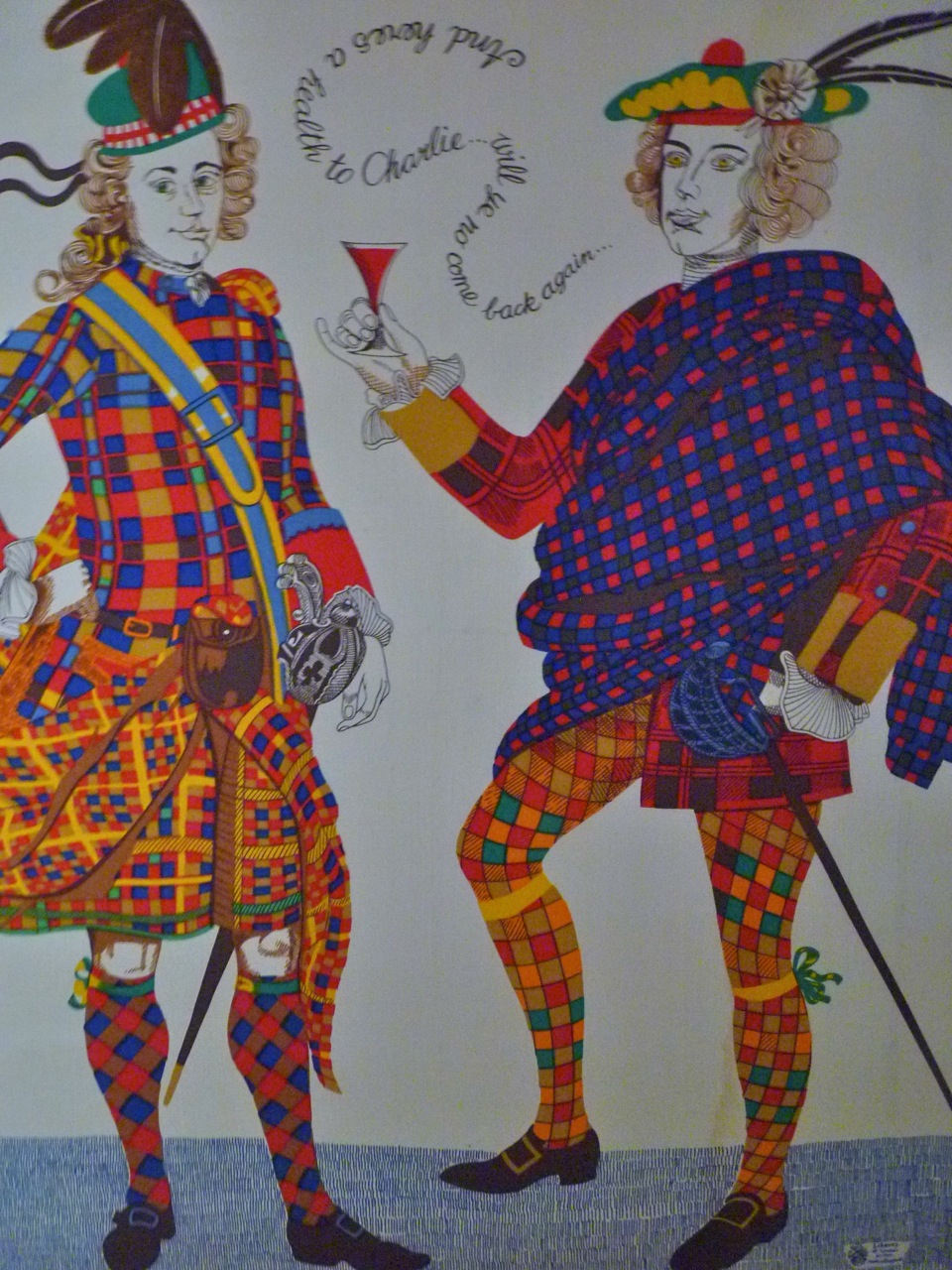
Harry More Gordon designed textiles and scarves for Libertys, this is one of his designs, hung in an upper corridor above the jugs that were often props in his paintings.
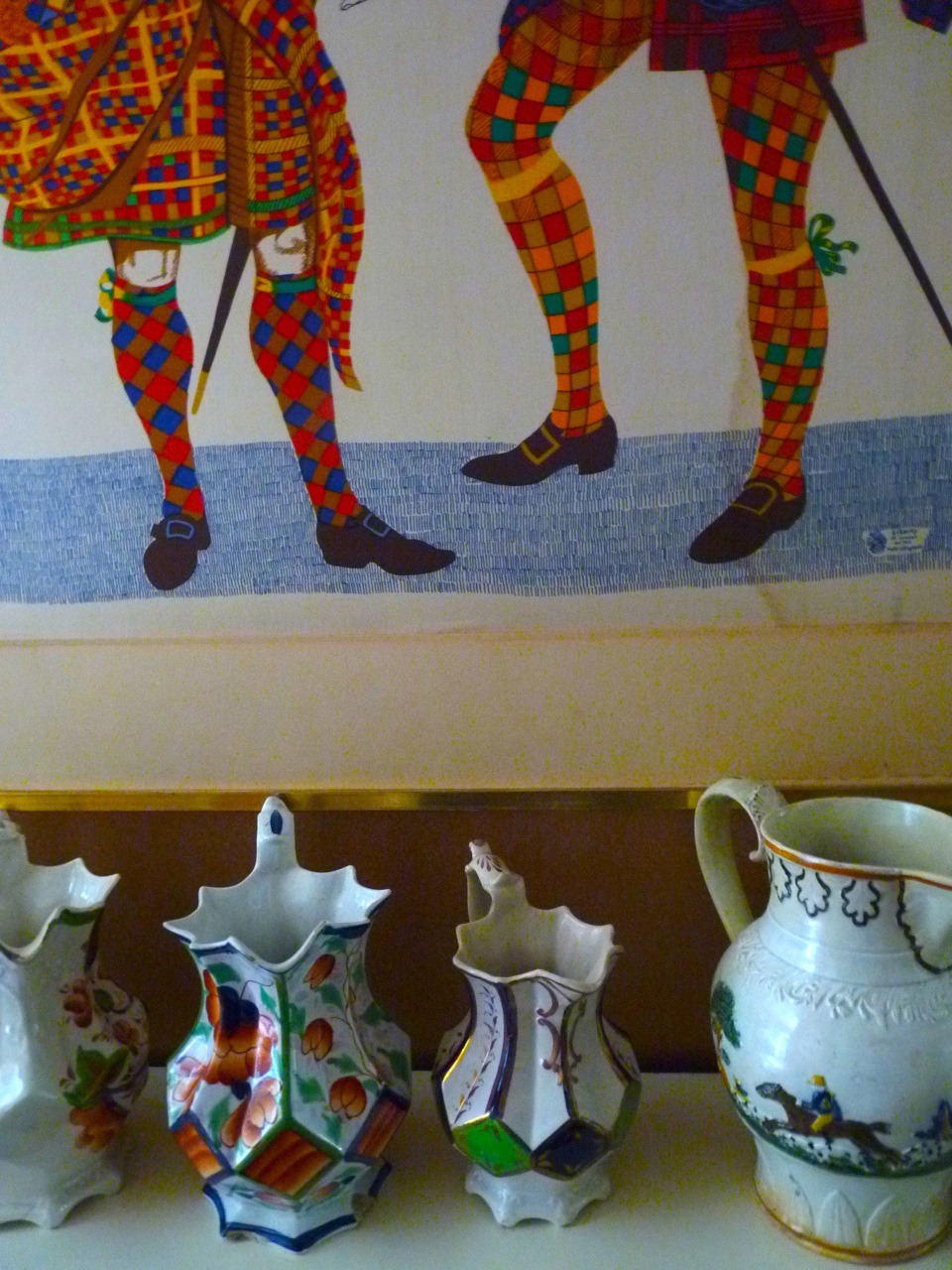
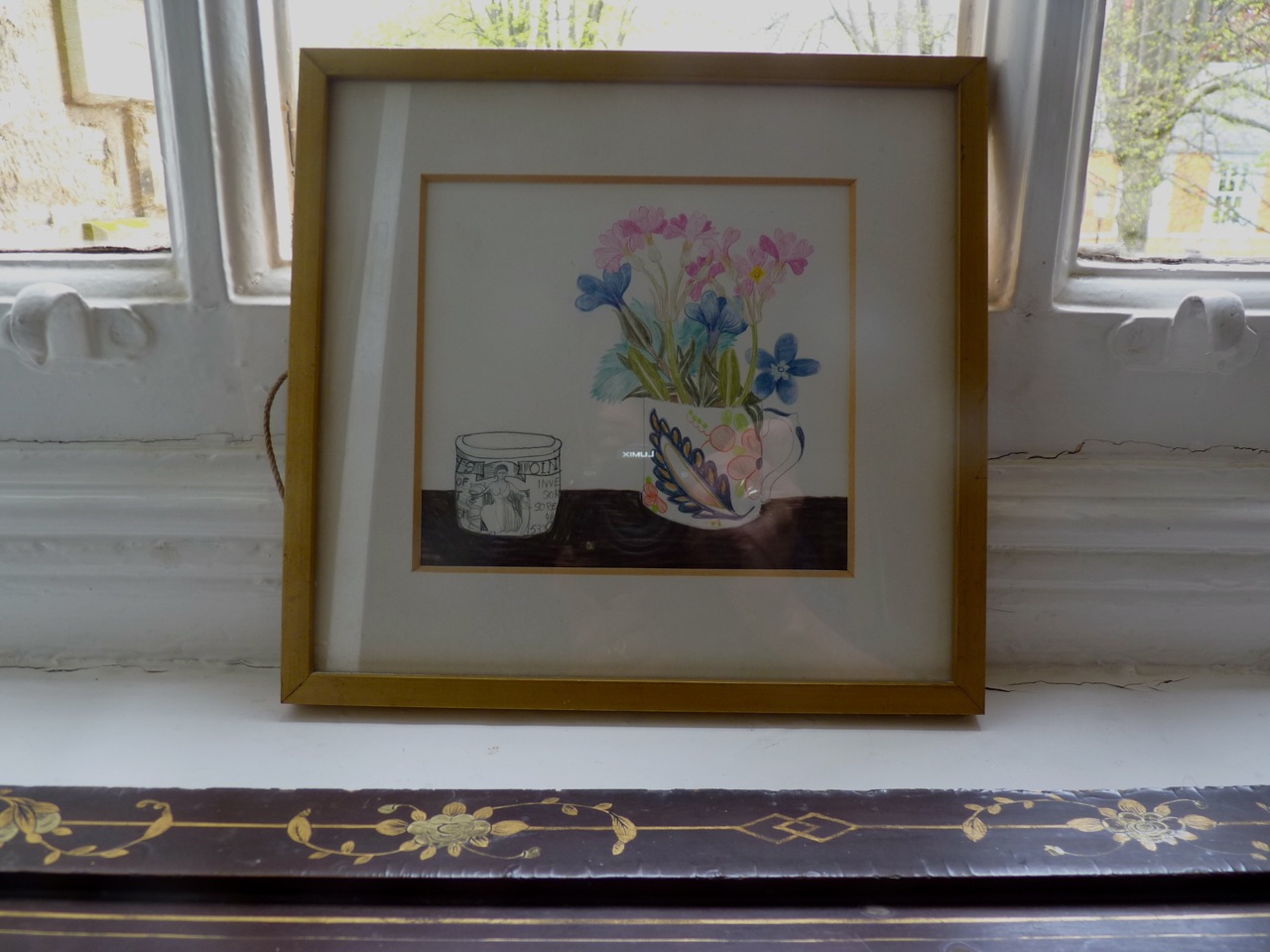
Top floor lavatory painting, the gift of one of his students.
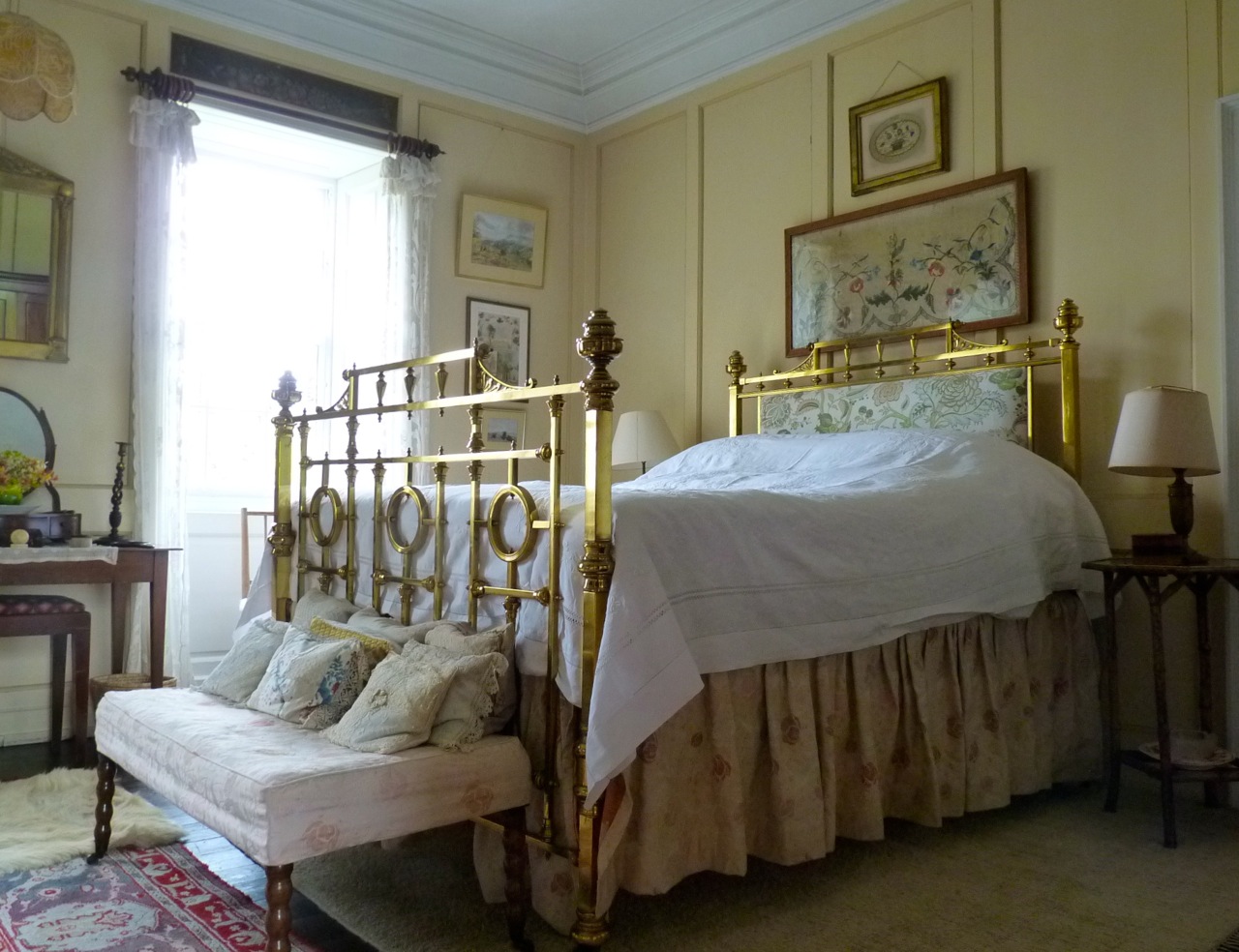
[My] guest bedroom.
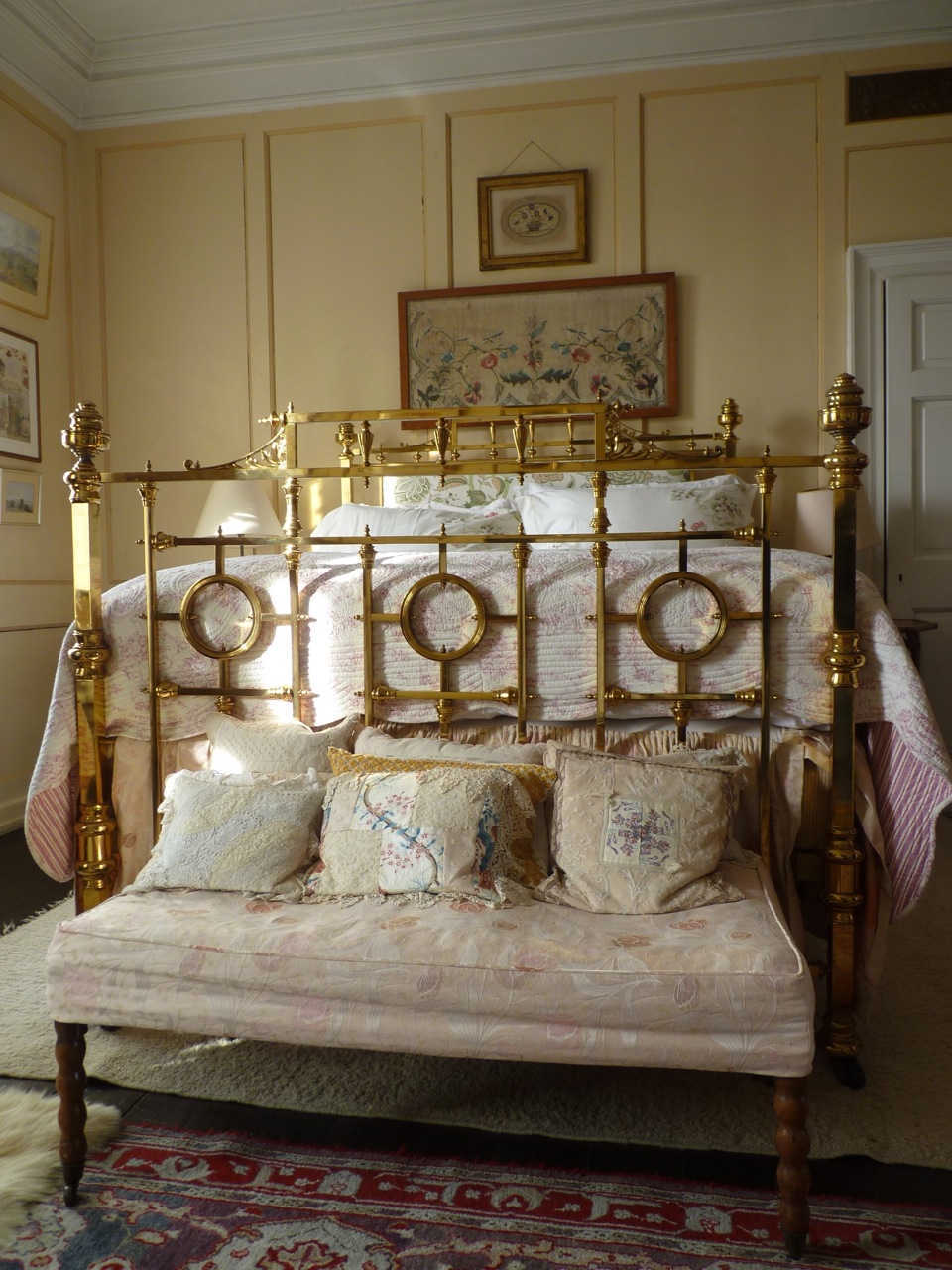
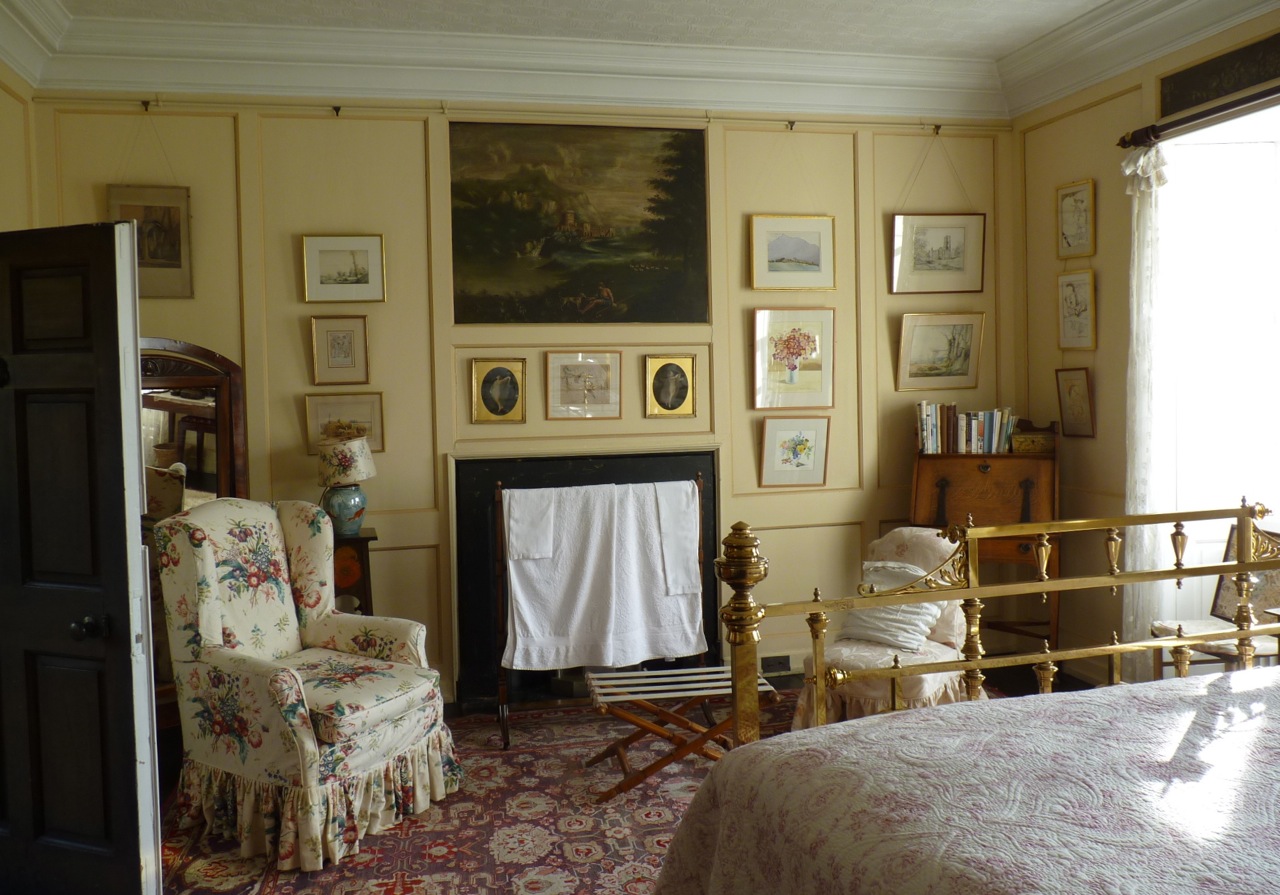
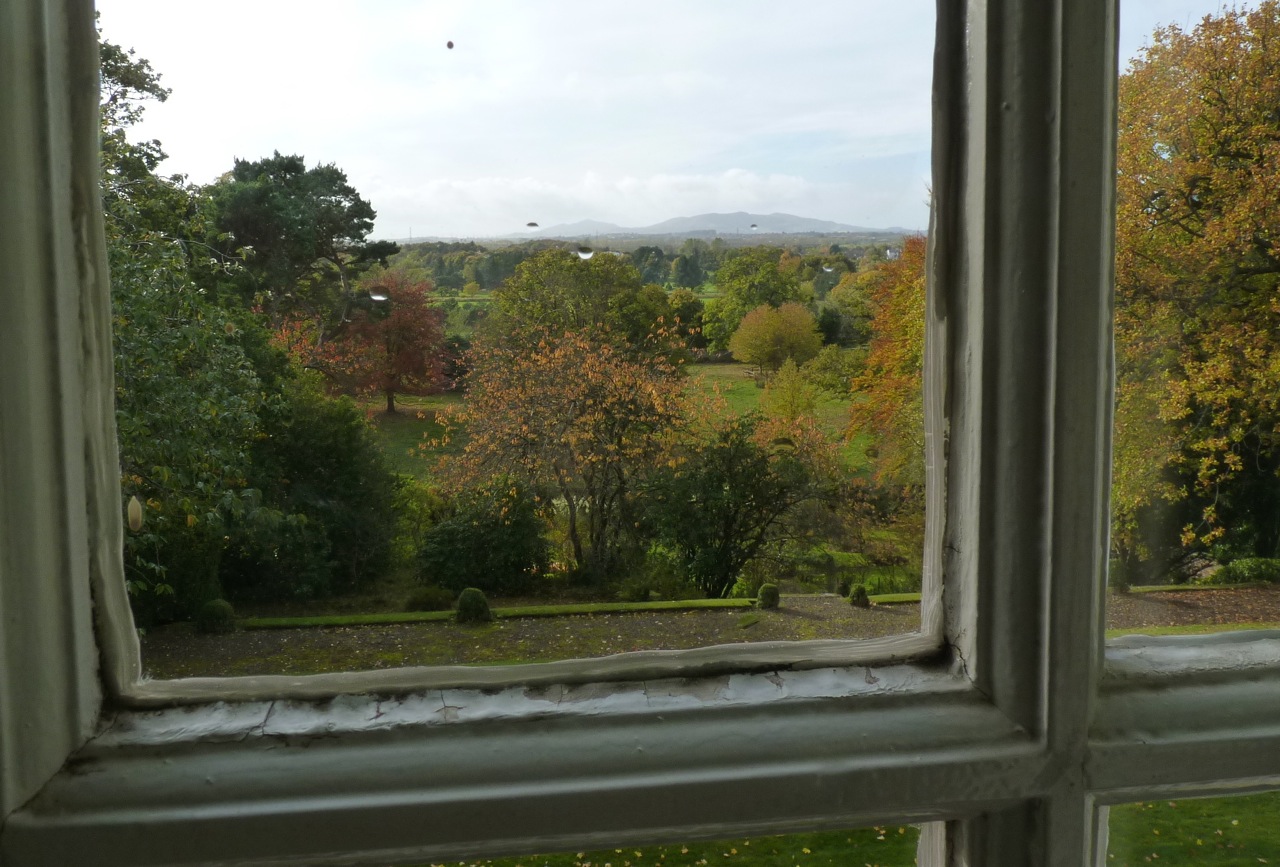
View from the back of the house across open fields, a scattering of wee raindrops.
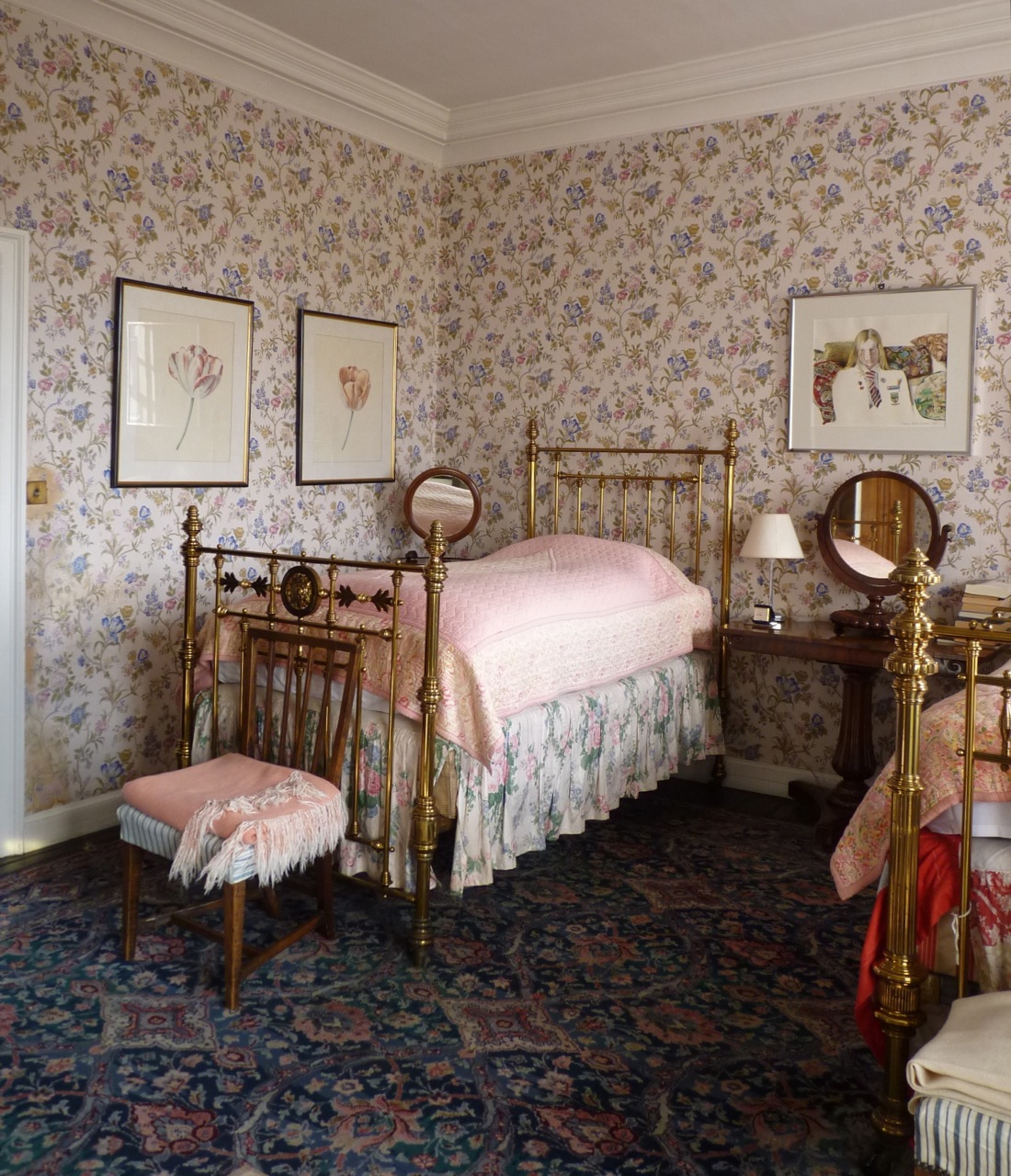
Another guest bedroom.
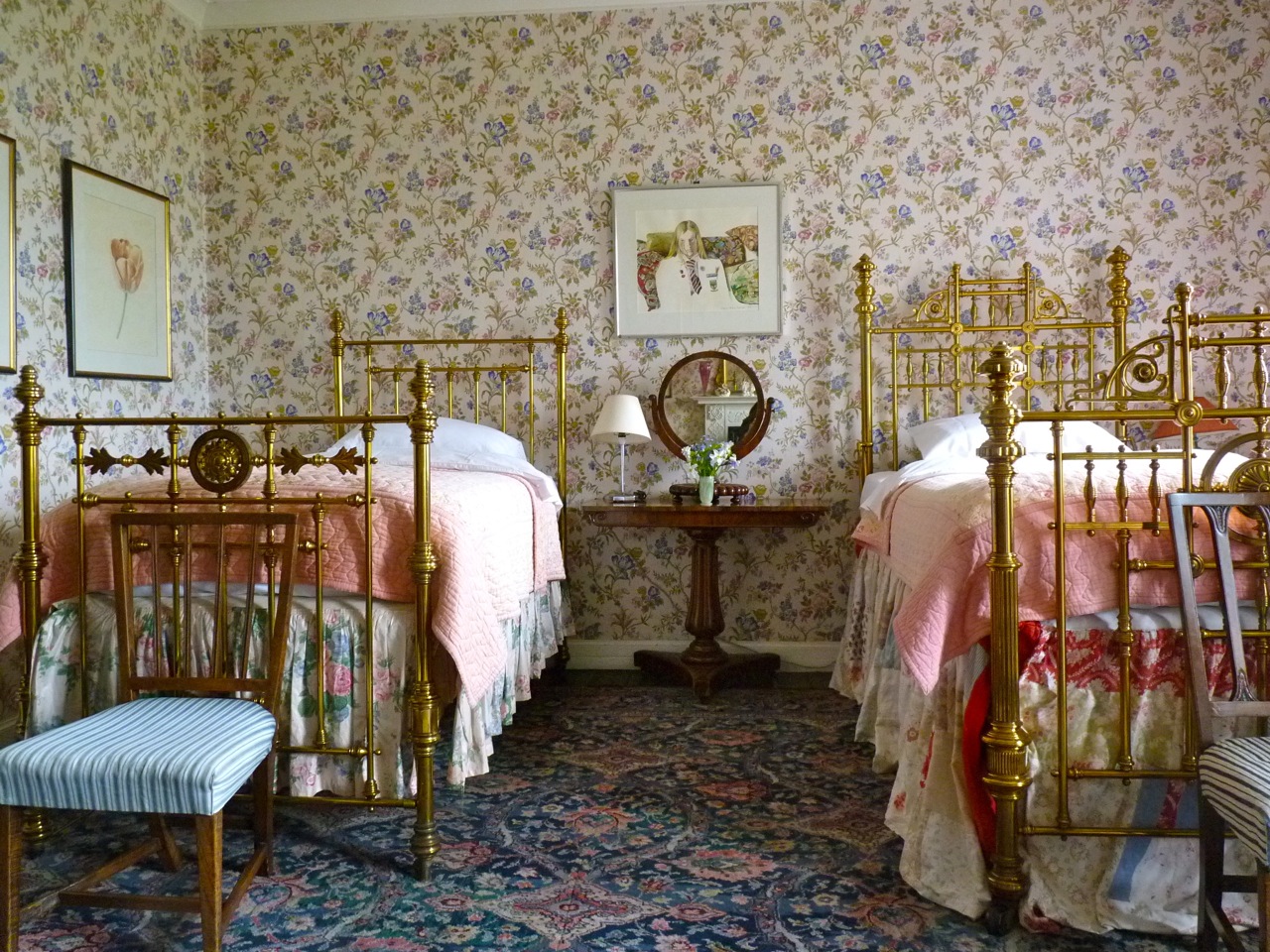
Exquisite antique textiles and linens collected by Marianne, who was responsible for decorating and arranging the house's many rooms.Tulip paintings by Rory McEwan.
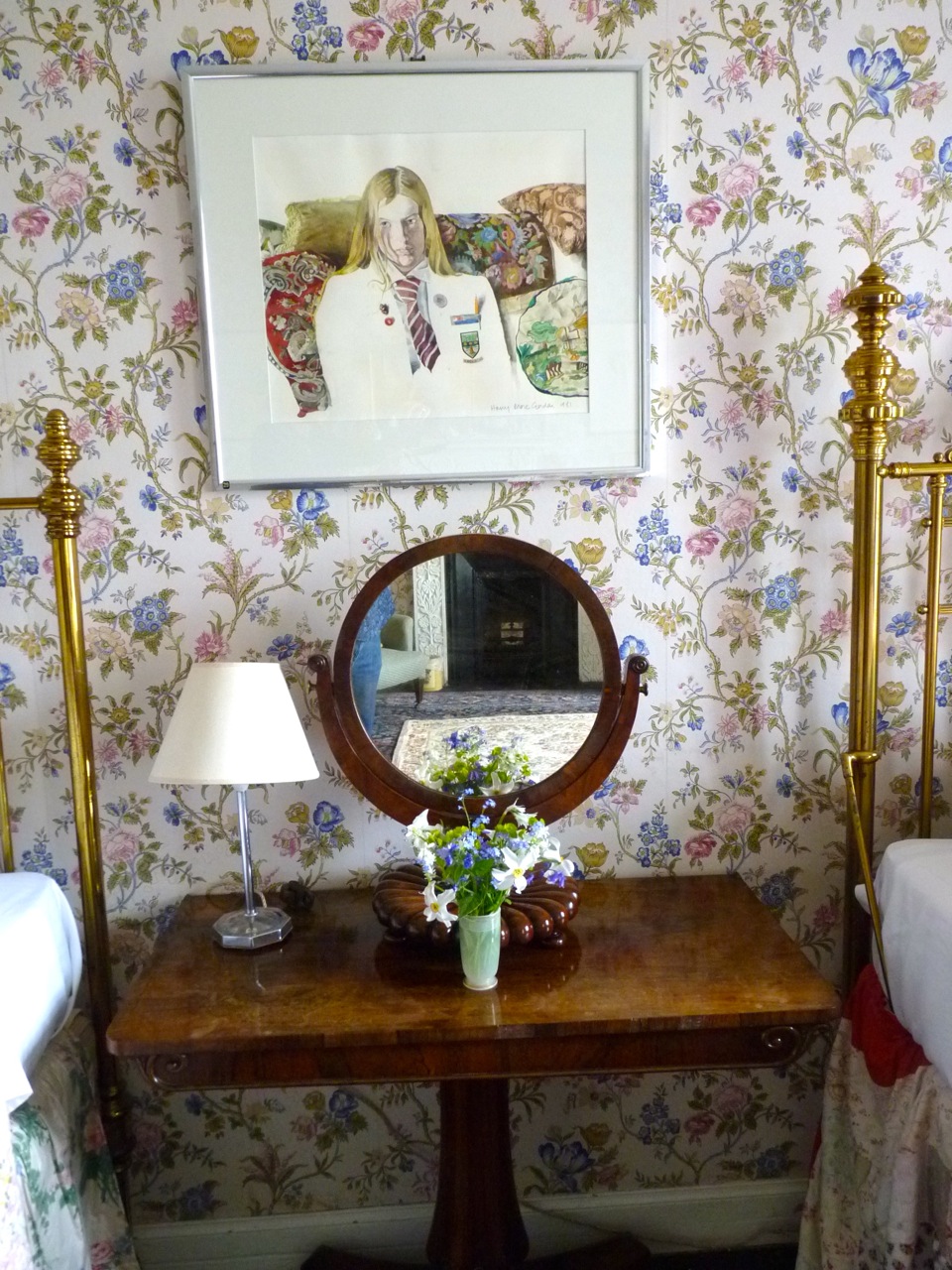
My favourite portrait.
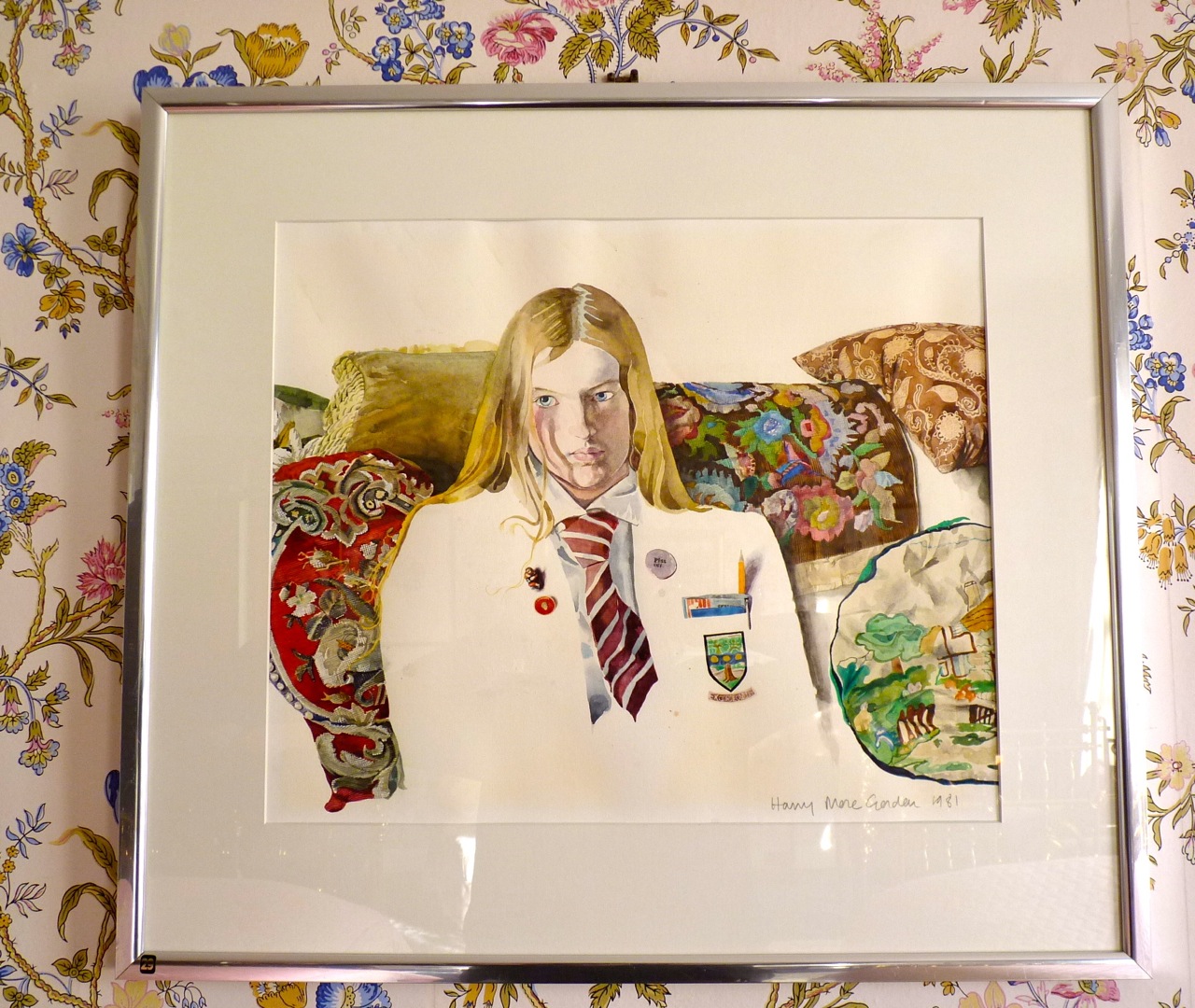
Zillah by Harry More Gordon, post-school, with home made badge, 'Piss Off.'
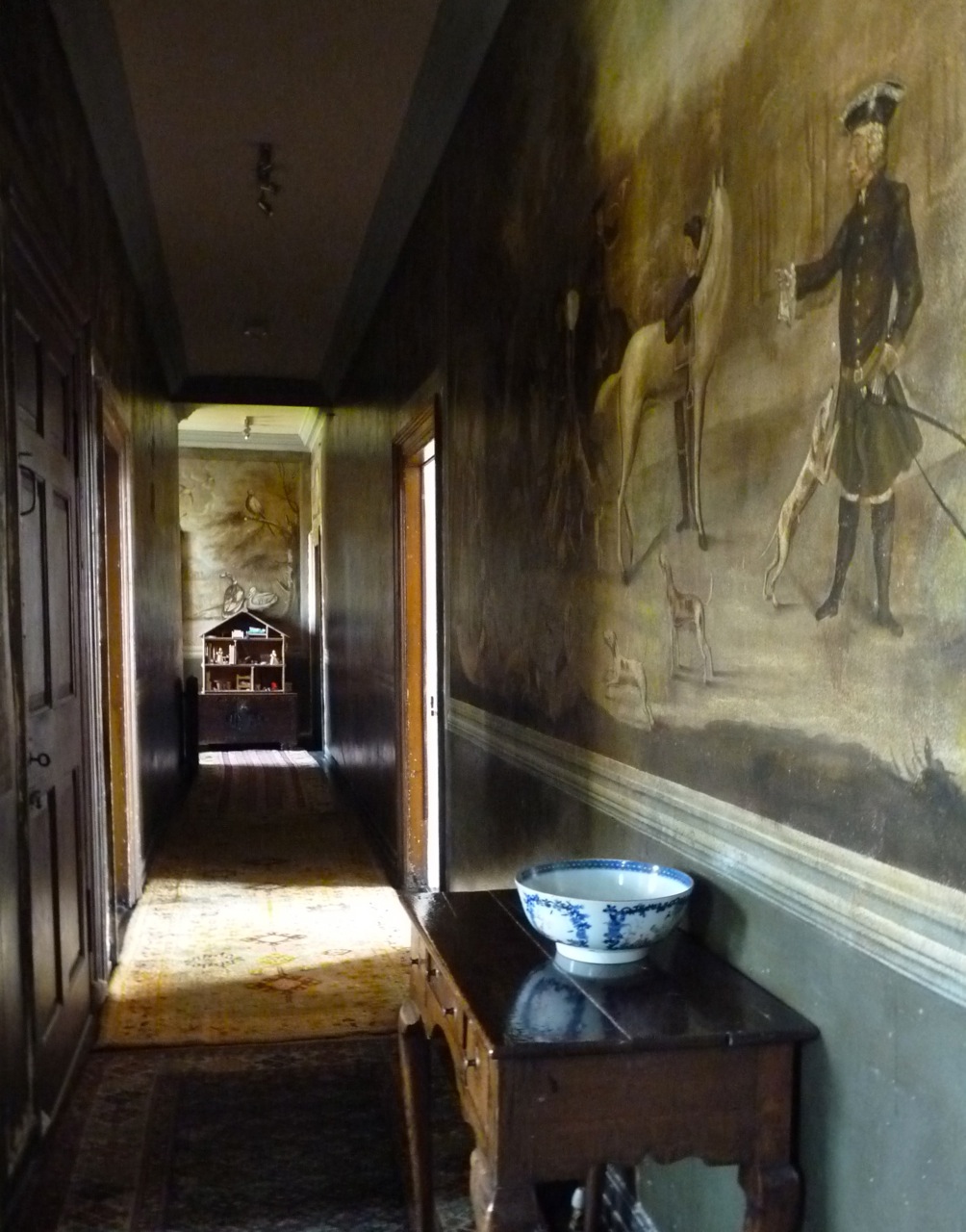
The top floor spine corridor, with eighteenth century mural of country pursuits, commissioned by the house's builder and first owner, Mr. Shiells. Dolls house at the end of the enfilade, outside Charlie's writing room.
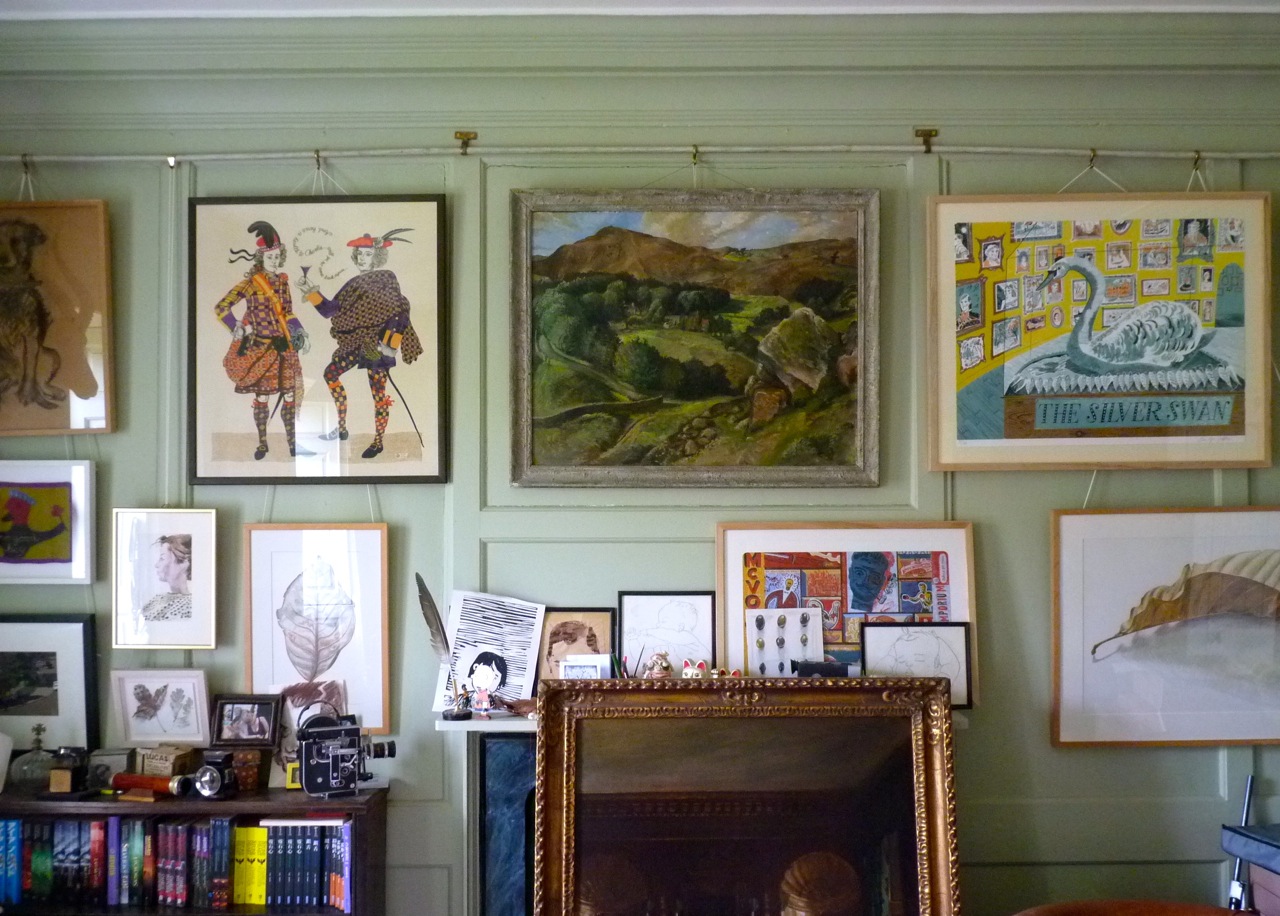
Charlie's writing room, with another of Harry More Gordon's designs for Libertys, and a landscape oil painted by an illustrator for the 'Ladybird' book series, bought for £5 in the fabled local junk yard. Here he wrote his compelling stories of British folklore and the supernatural, the mesmerising Stoneheart trilogy for children and now The Oversight, his darkly atmospheric adult novels set in Victorian London.
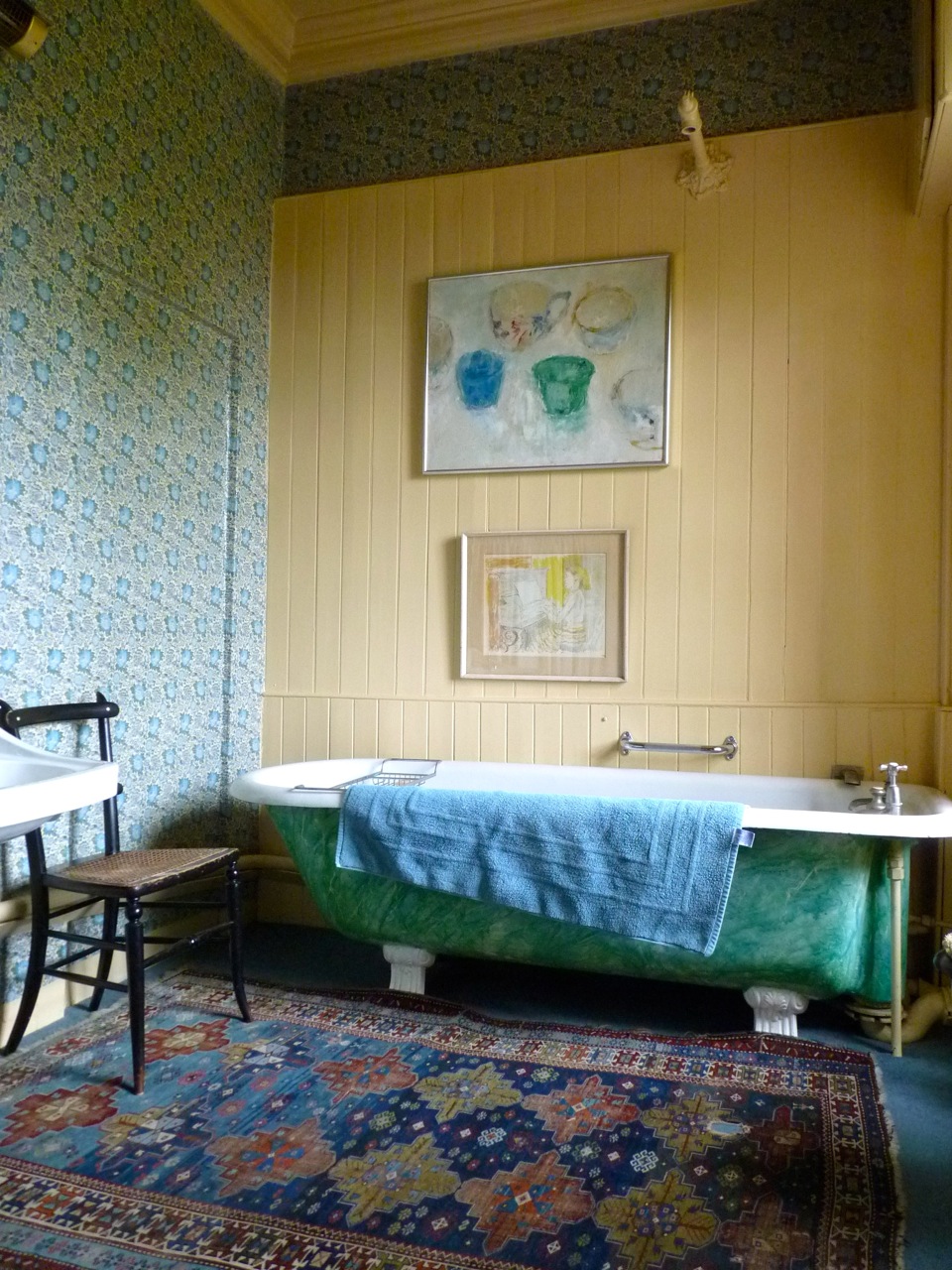
How to decorate a bathroom.
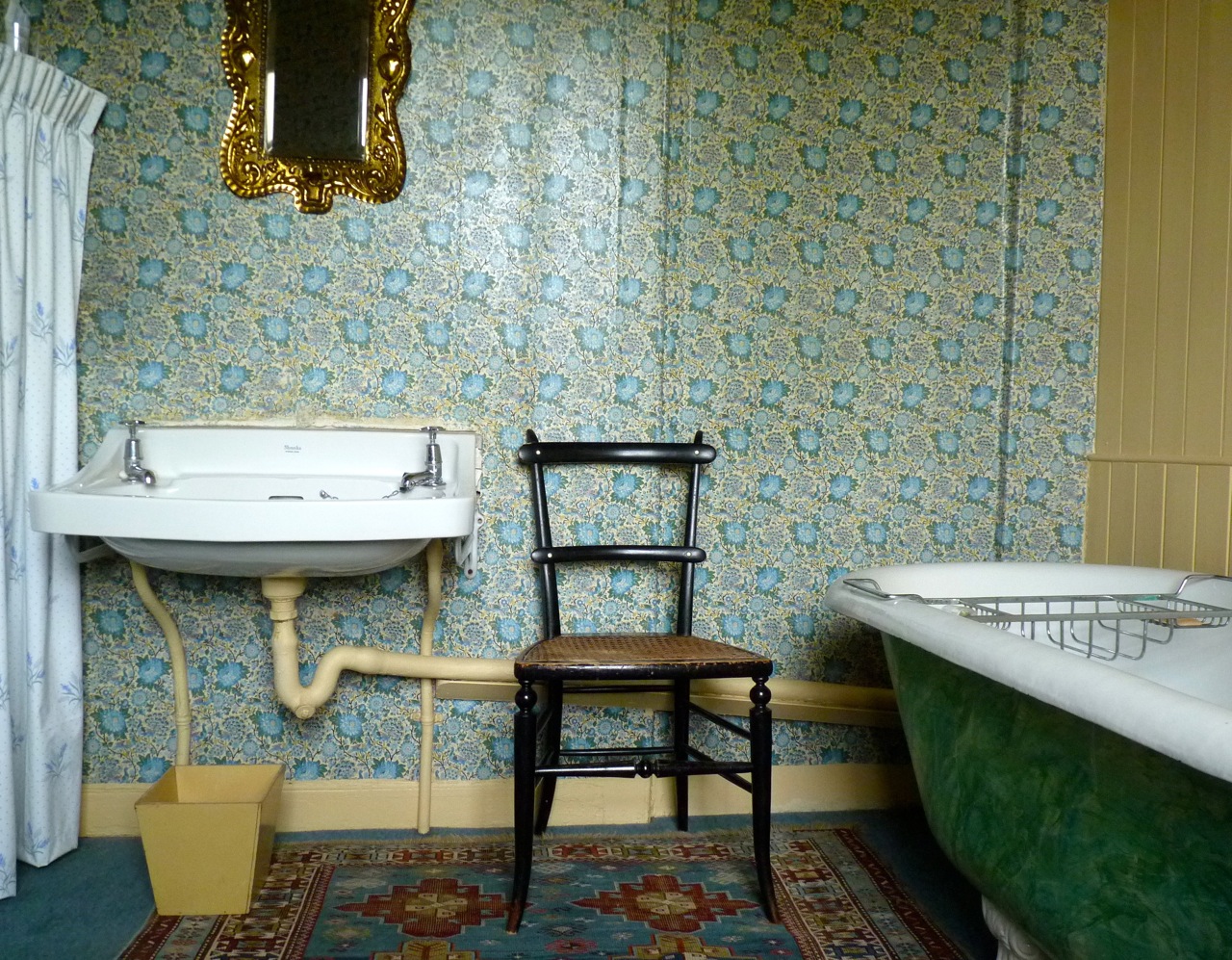
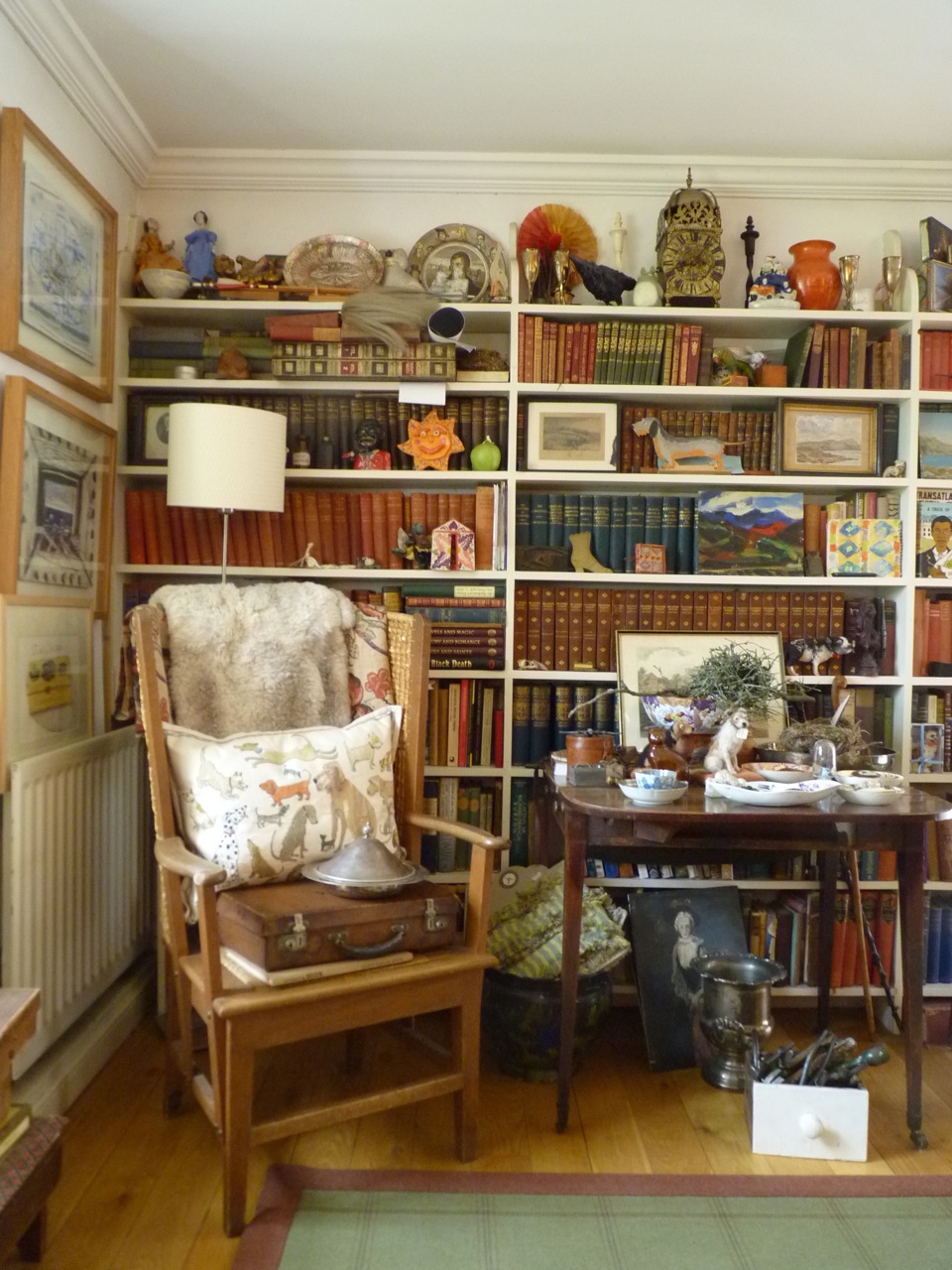
When Charlie, Domenica and their two children came back from living in LA, they moved into the house's generously proportioned raised basement. This is one corner of their long room, both sitting room and kitchen. Orkney chair with one of Domenica's dog cushions designed for Chelsea Textiles.
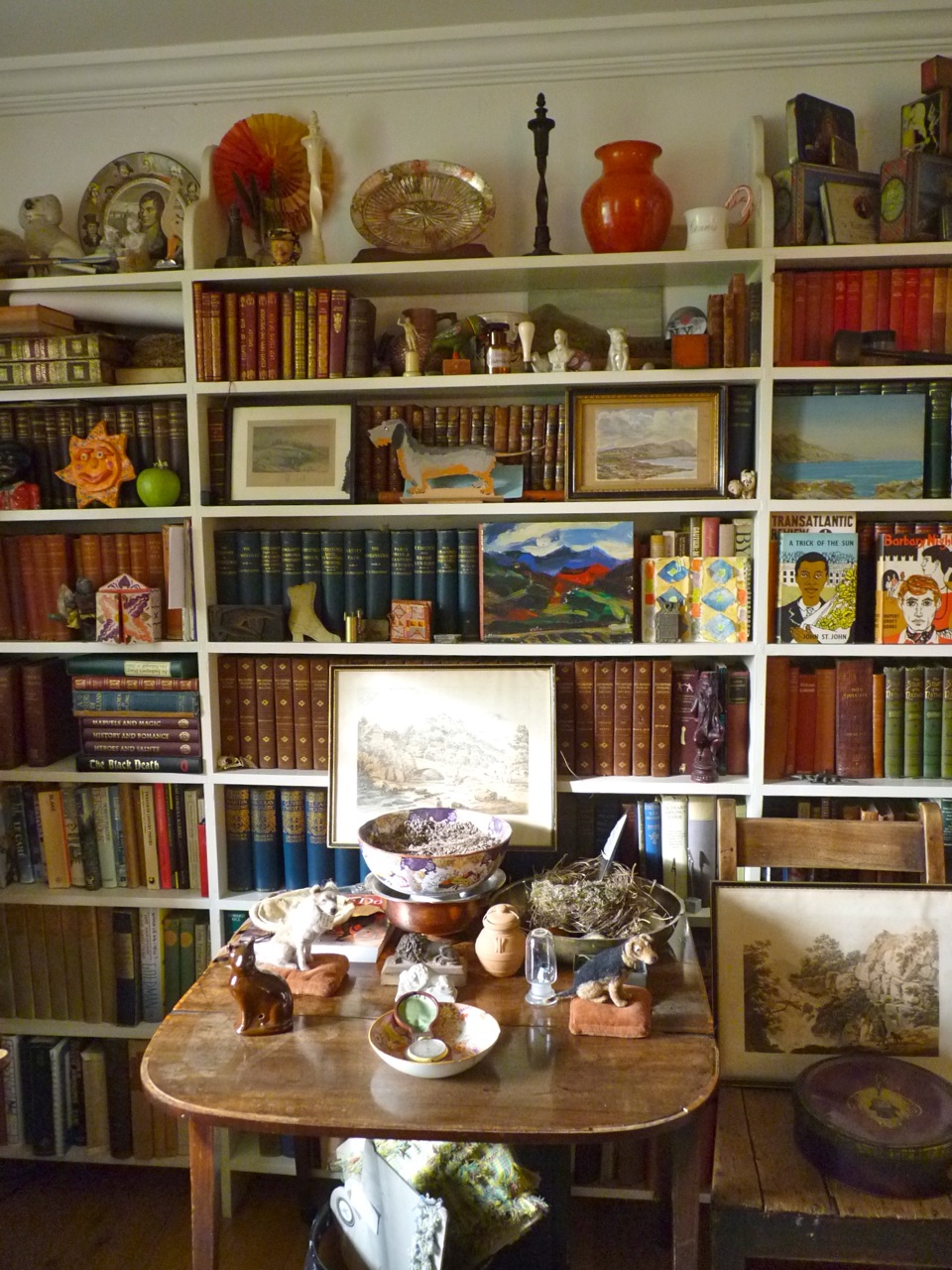
Tablescape.

Window-seat.
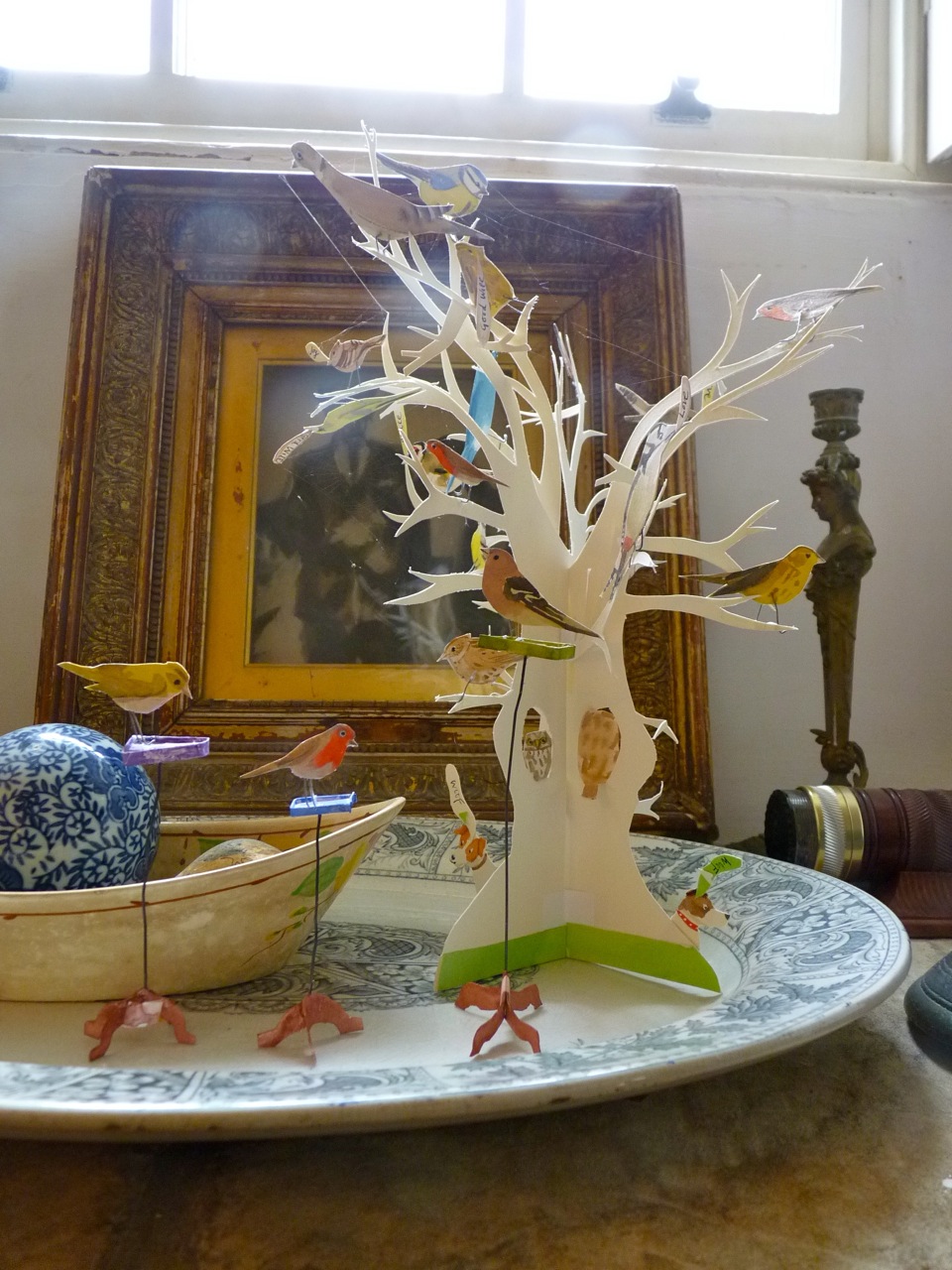
Paper tree birthday card made by Domenica.
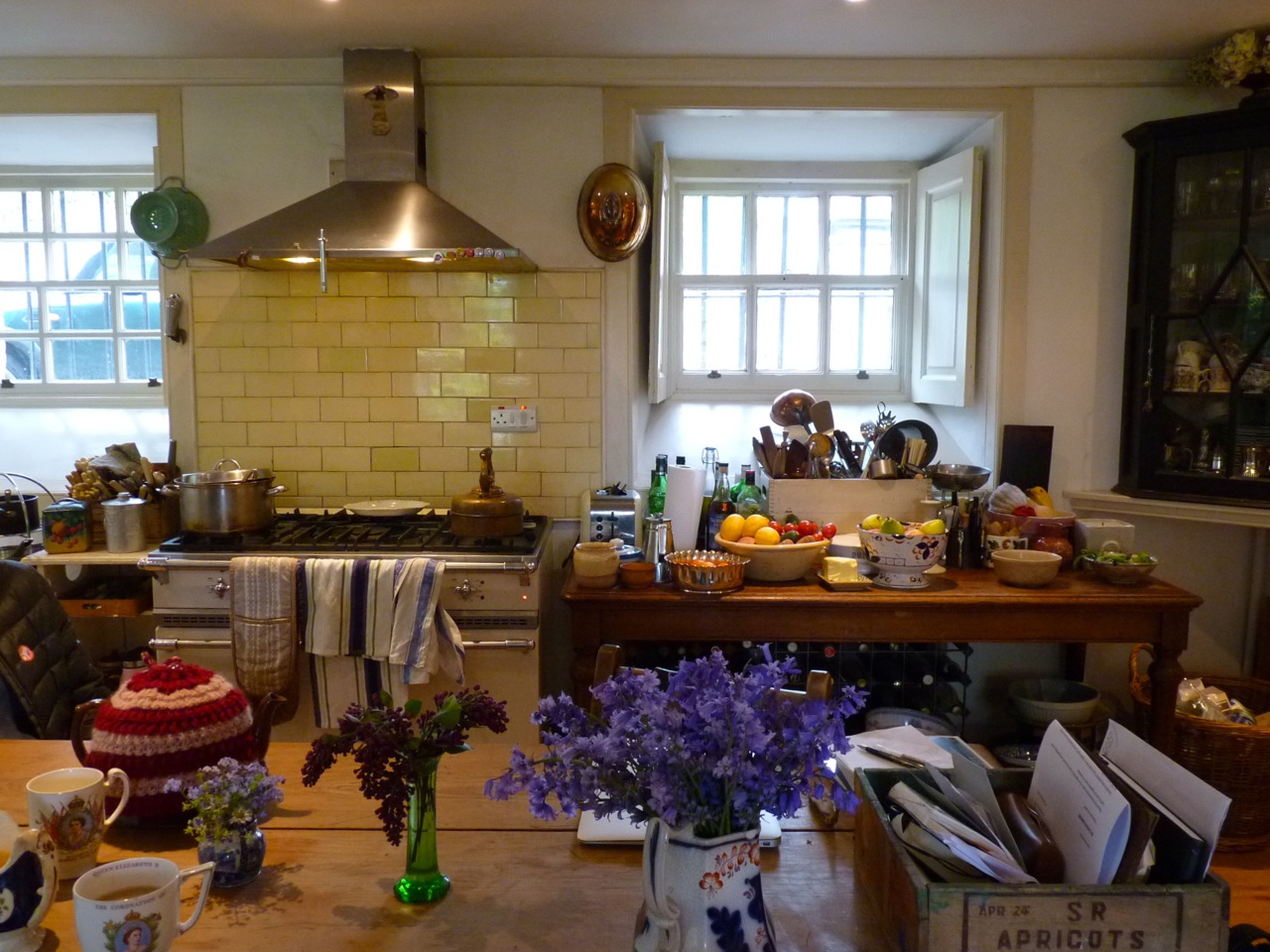
Lunch and garden flowers in the little vase that Domenica found on our trip to the mythical junk yard.
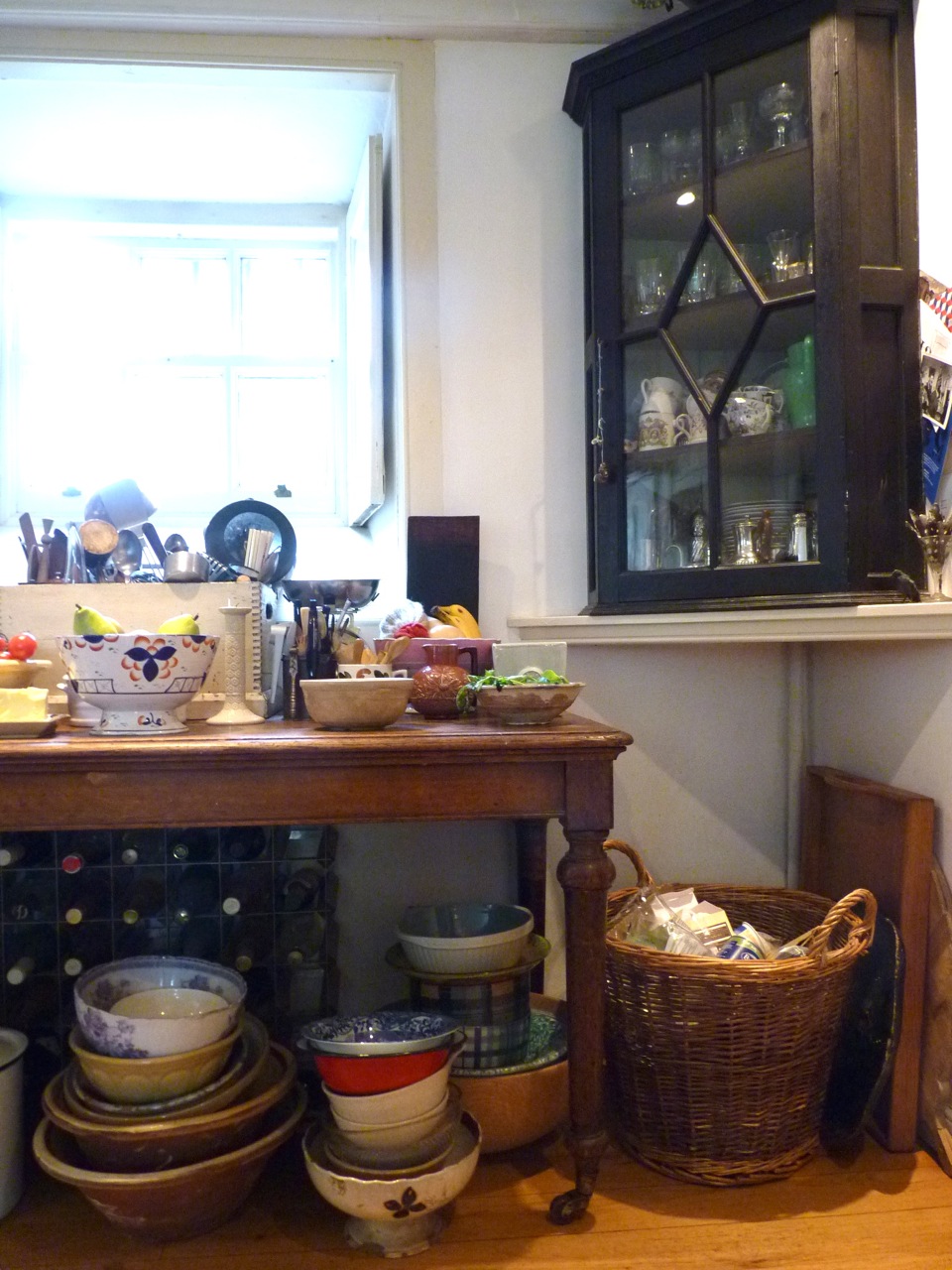
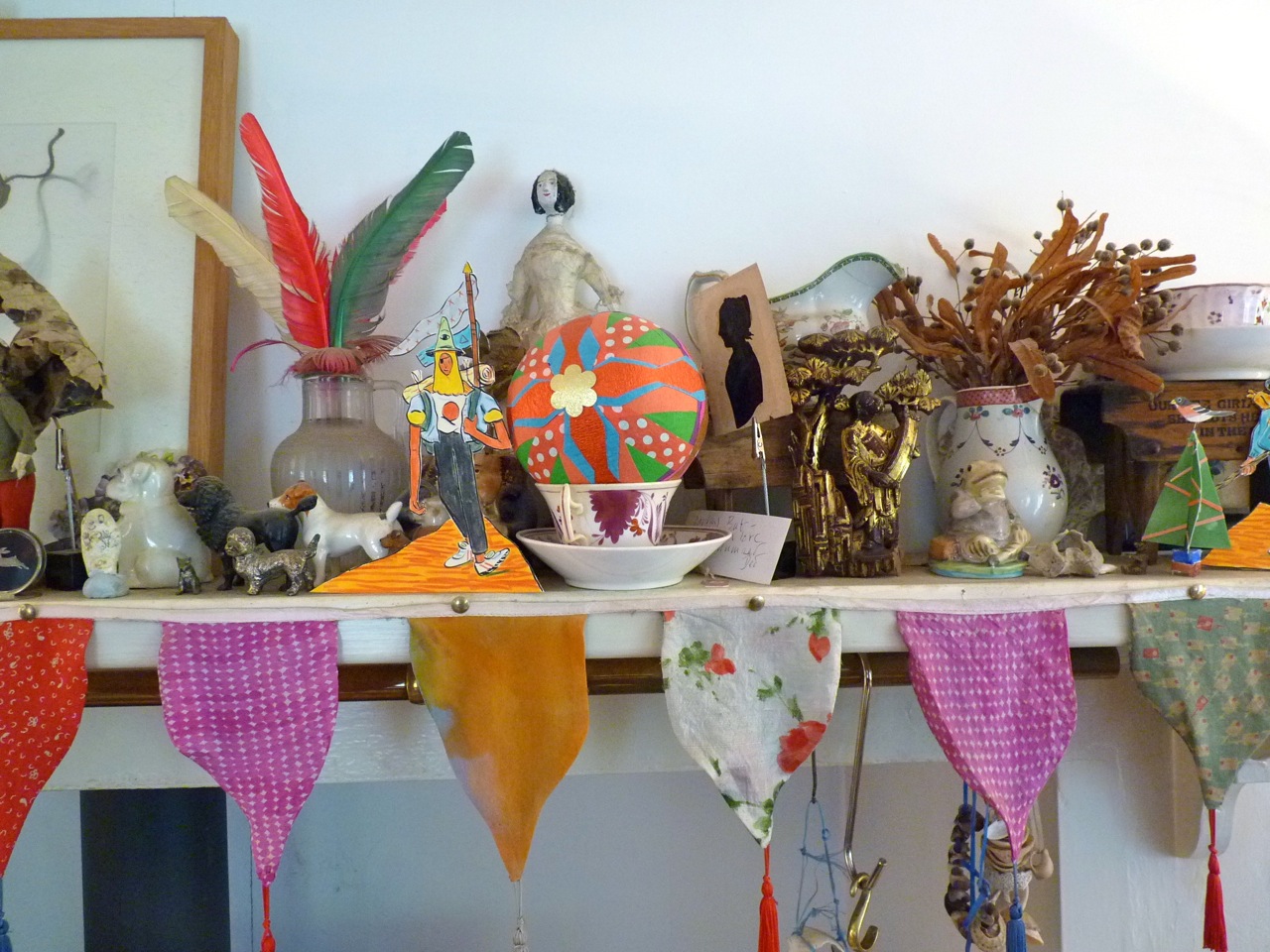
Sitting room overmantle.
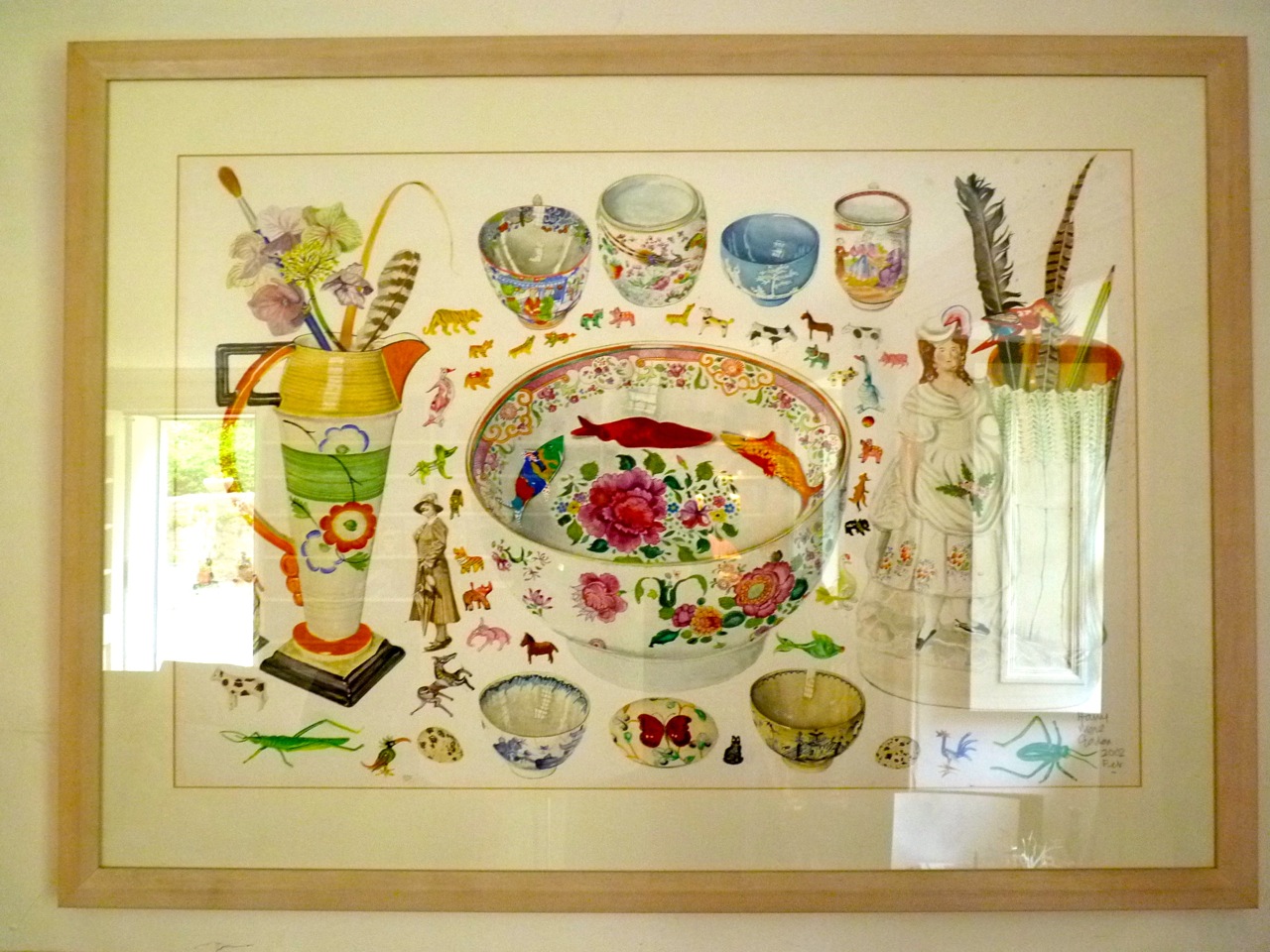
Late still life by Harry More Gordon. Objets trouves, the ceramics, feathers and the things picked up around the house that habitually made up his compositions.
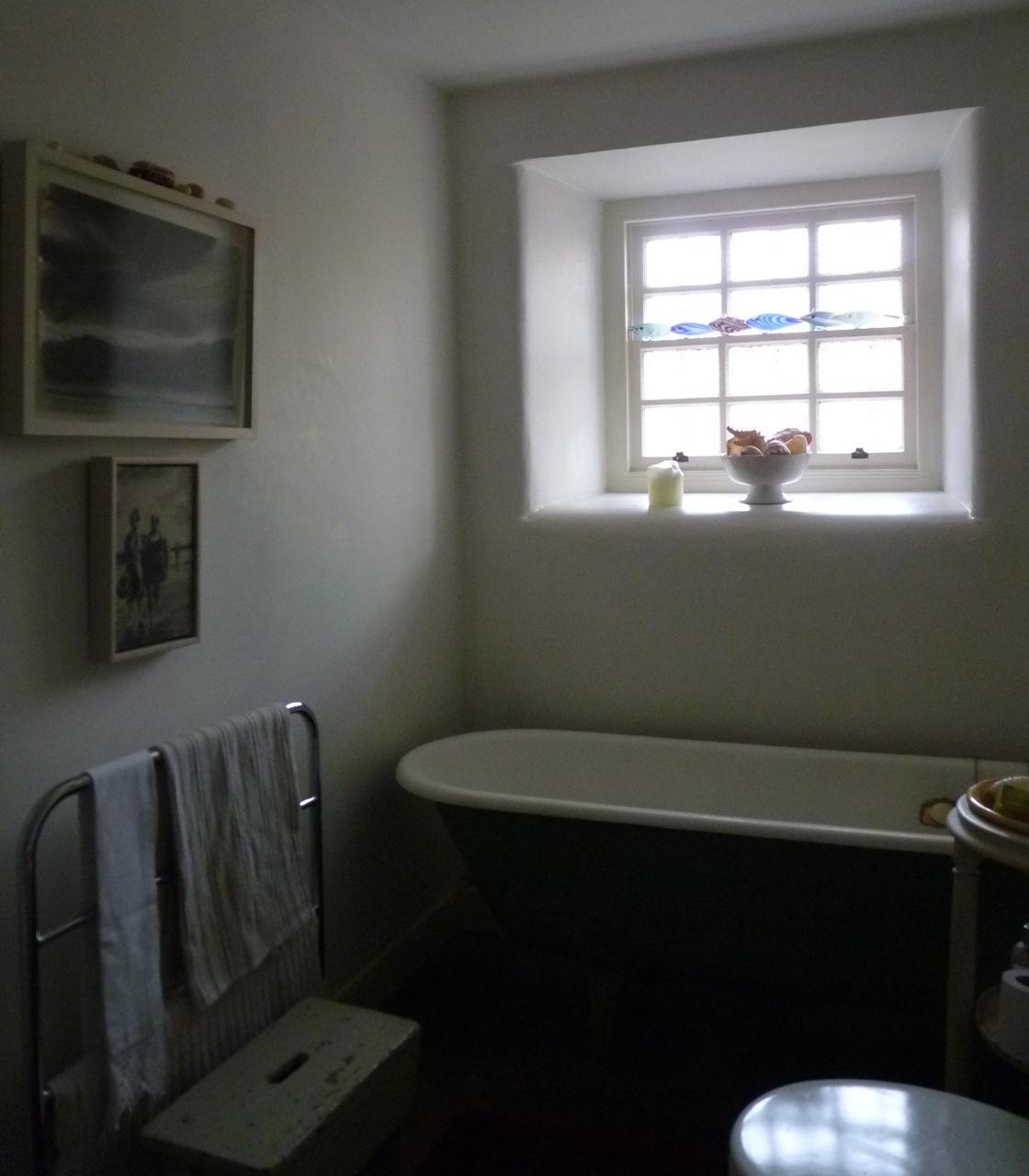
A jolly nice bath.
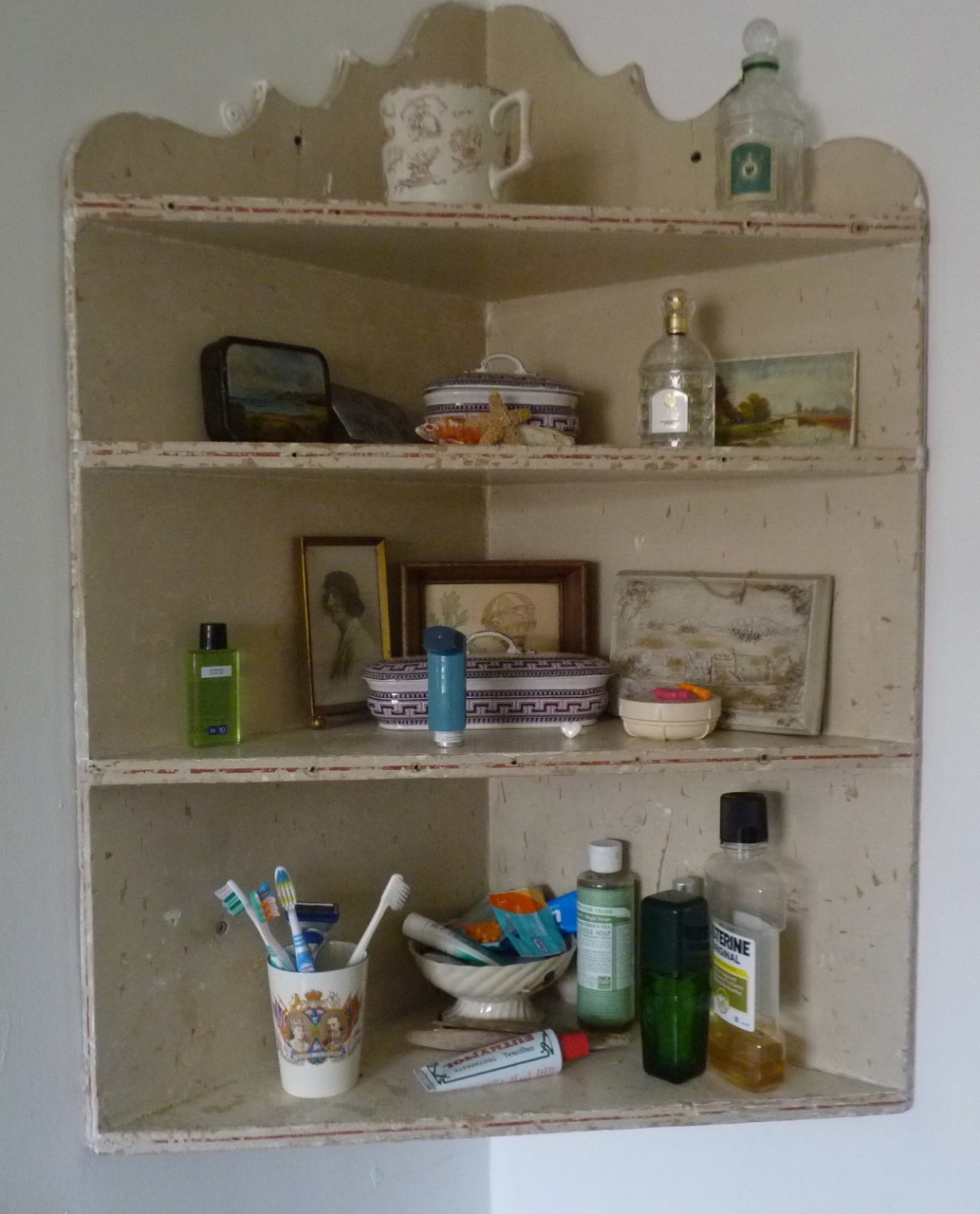
And the bathroom corner cupboard. Euthymol toothpaste.
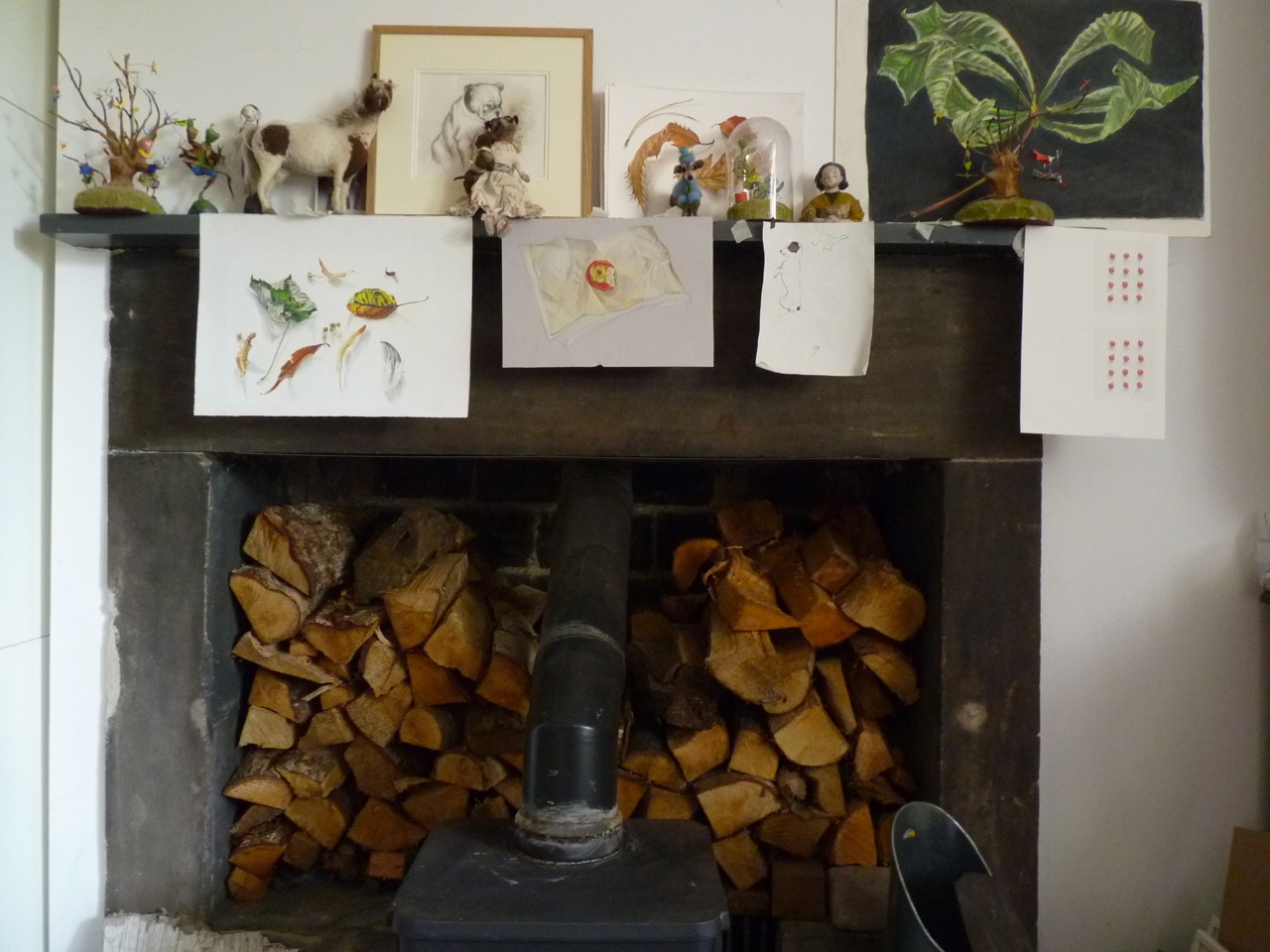
Domenica's studio in an old stone pavilion building in a corner of the courtyard.
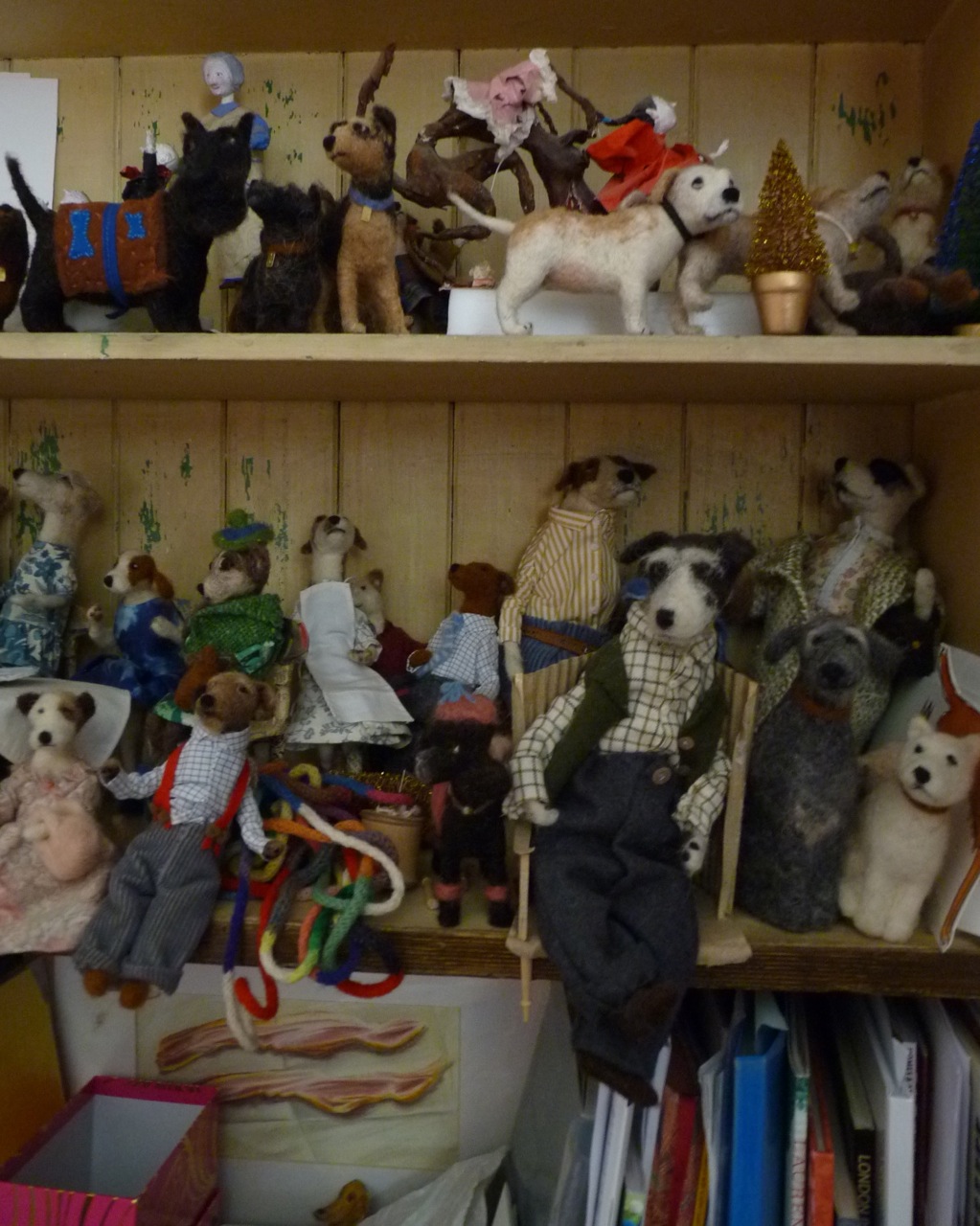
At last! The dogs. Sculpted from felted wool, conceived and hand made by Domenica.
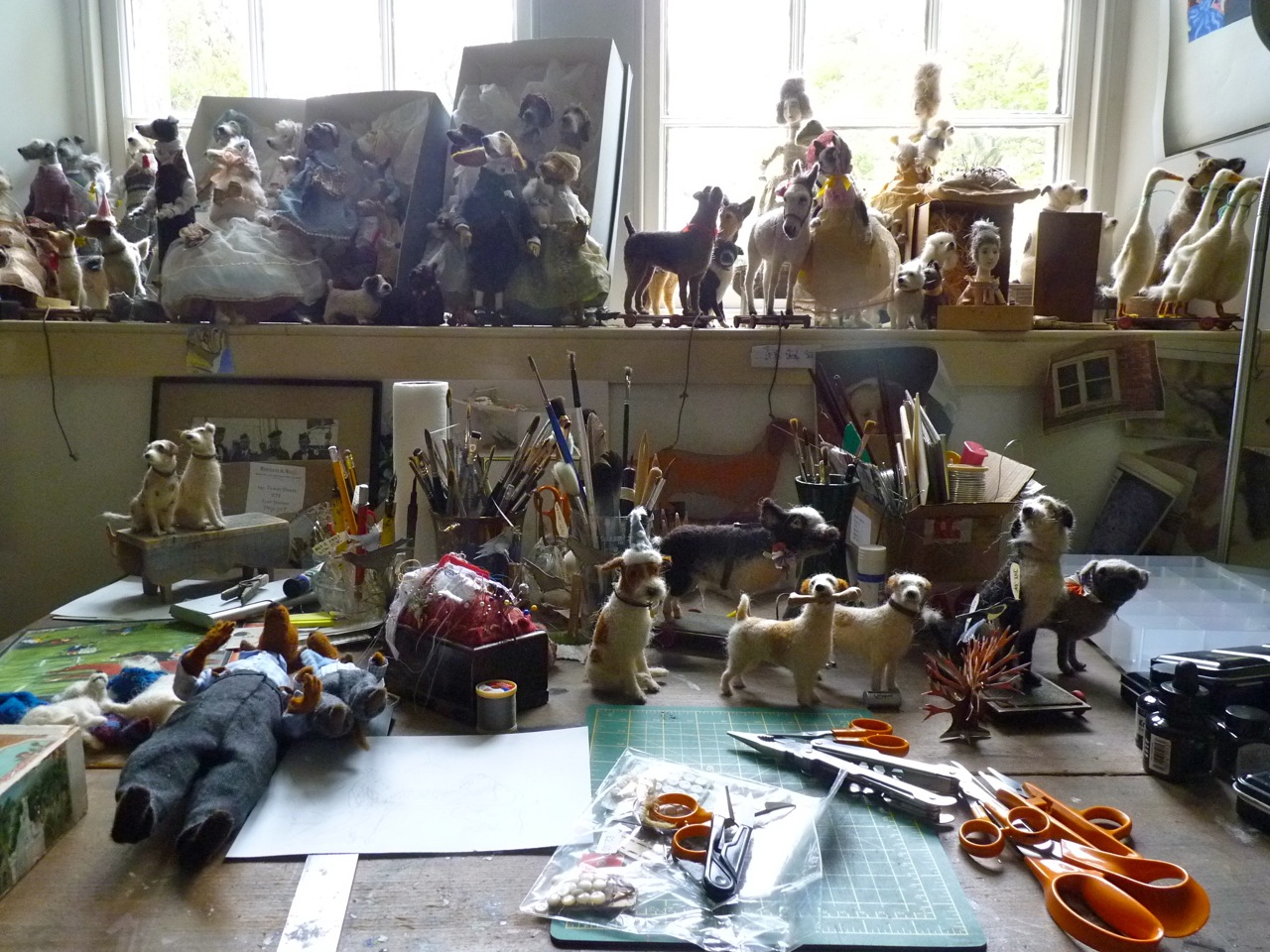
Domenica's worktable. If you see the same things in two different places it is because these pictures were taken on two visits made about seven months apart.
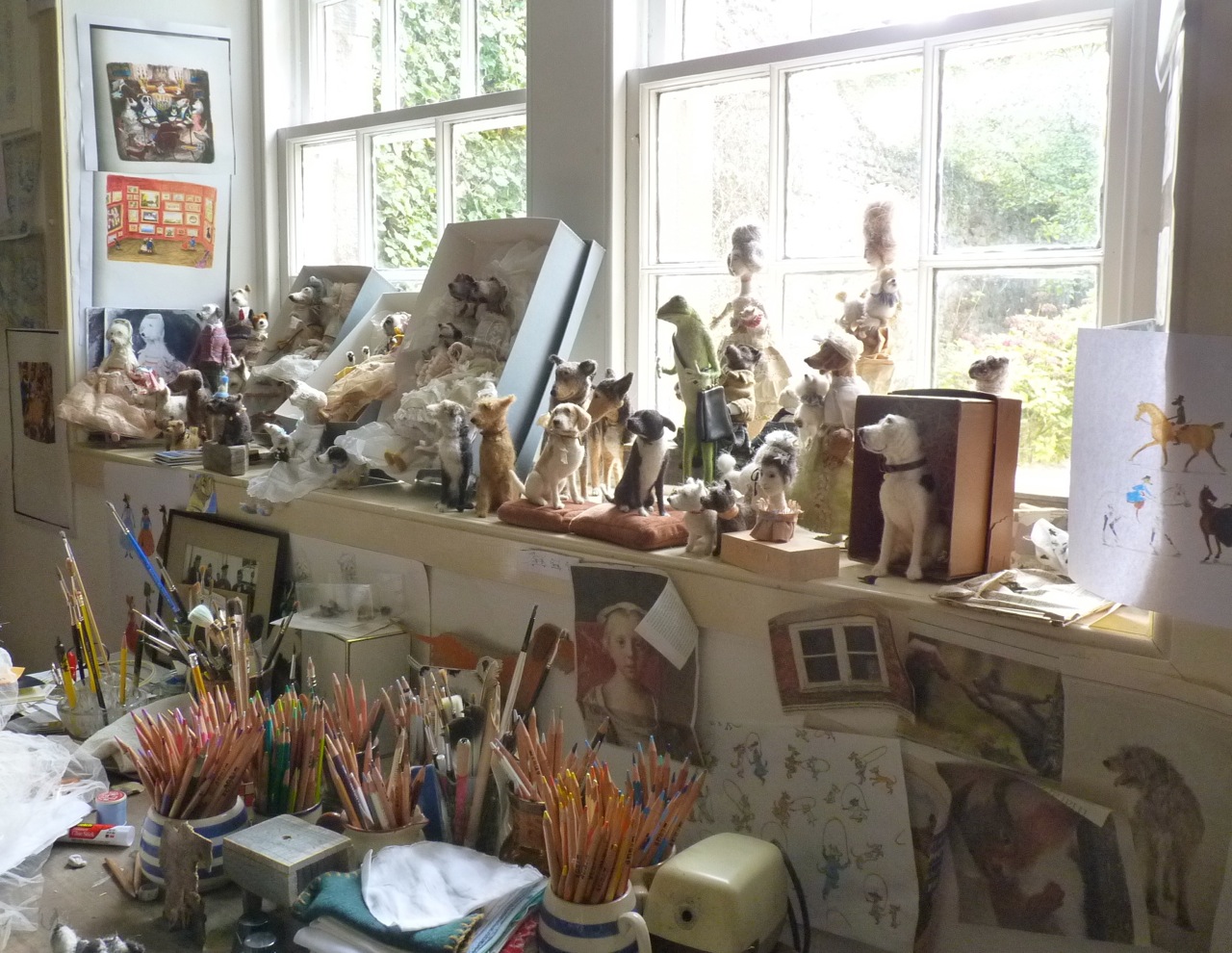
Sharp pencils.
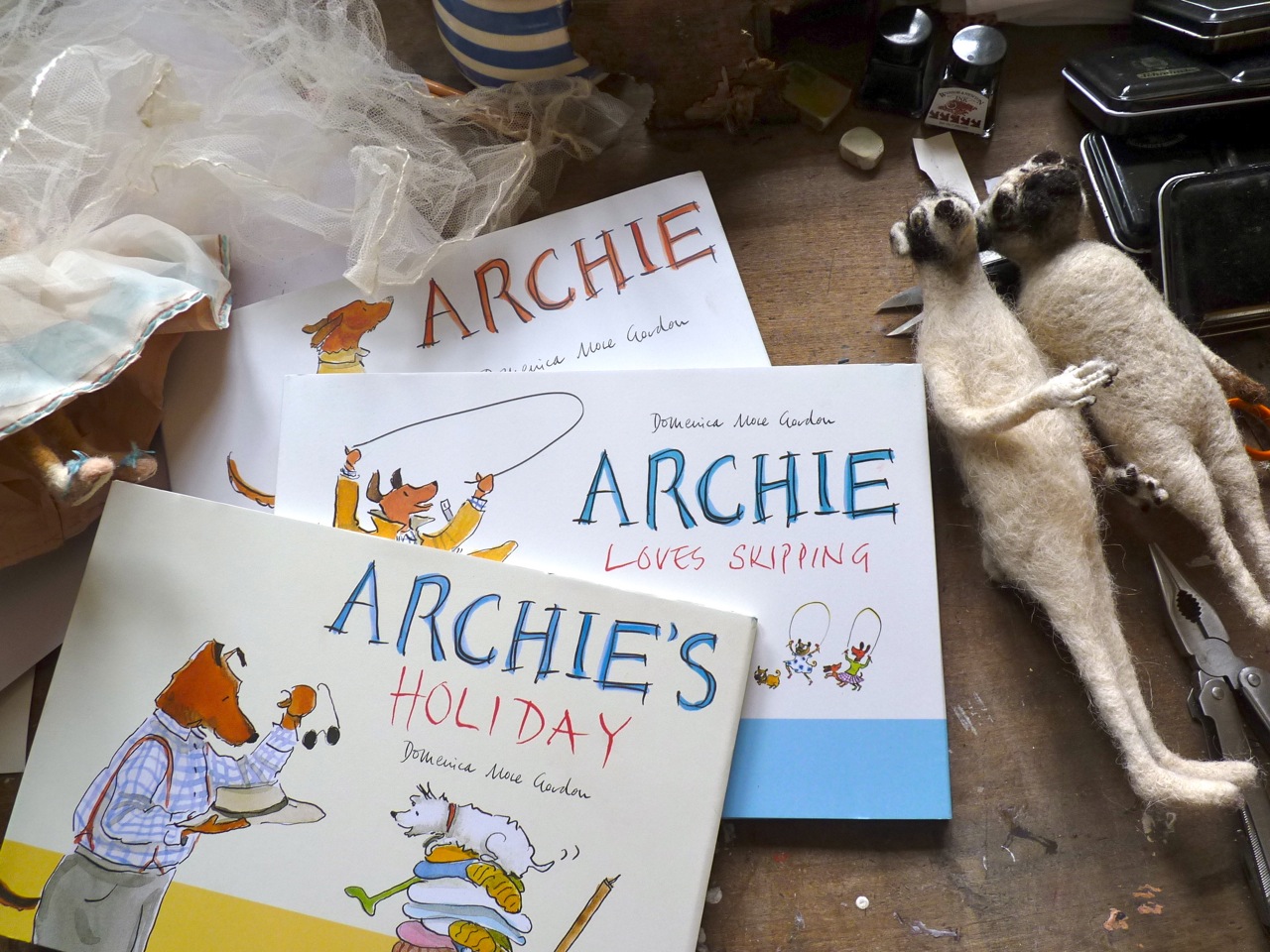
Archie is a beloved, elderly black and tan Lakeland Fell terrier, the family pet for many years now. He was Domenica's principal muse and model, and then became the hero of her books written and illustrated for children.

Hand knits, tartan, Fair Isle and roller skates. Note the minute elastic striped belt.
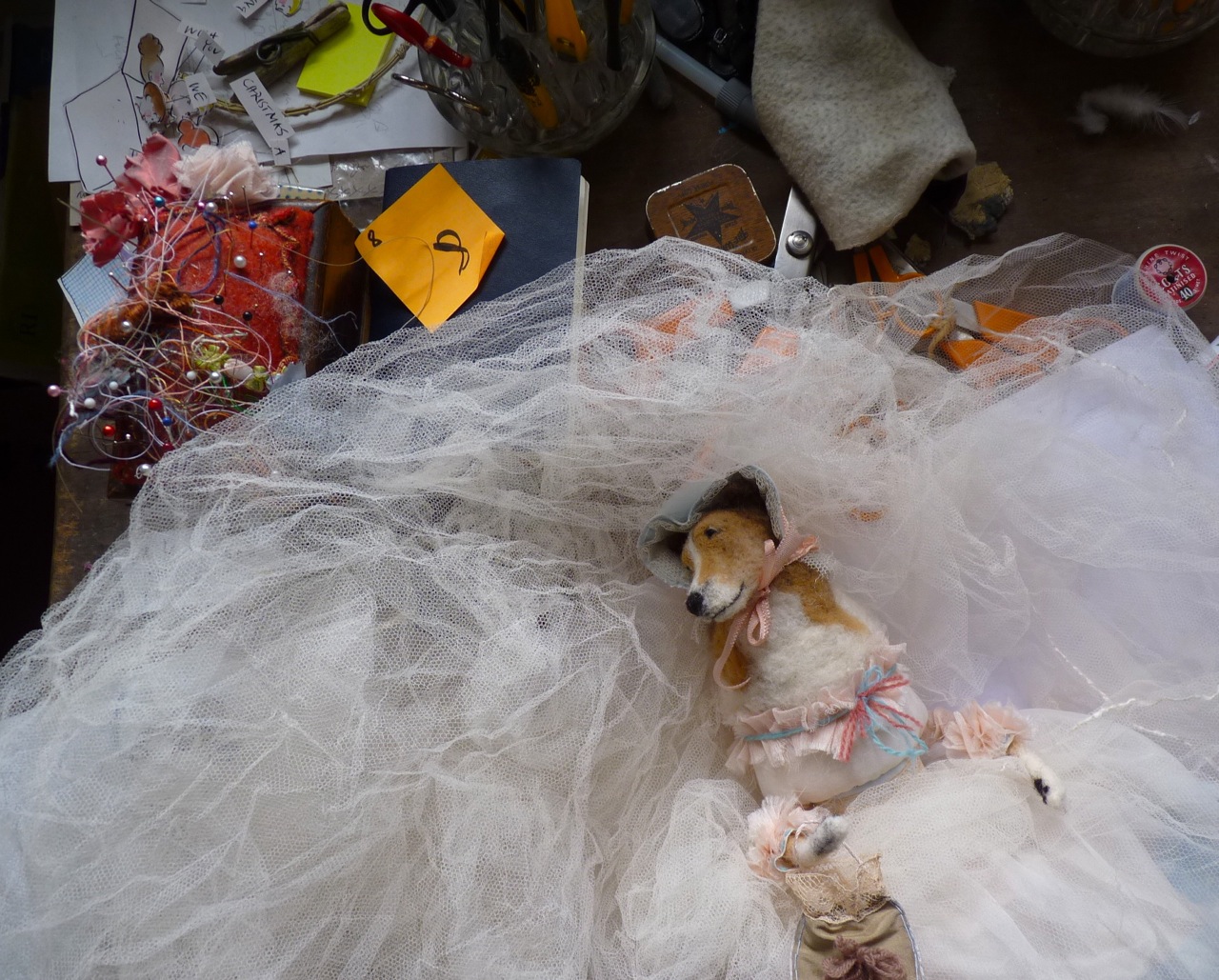
Bride dog, work in progress, seen in autumn 2015.
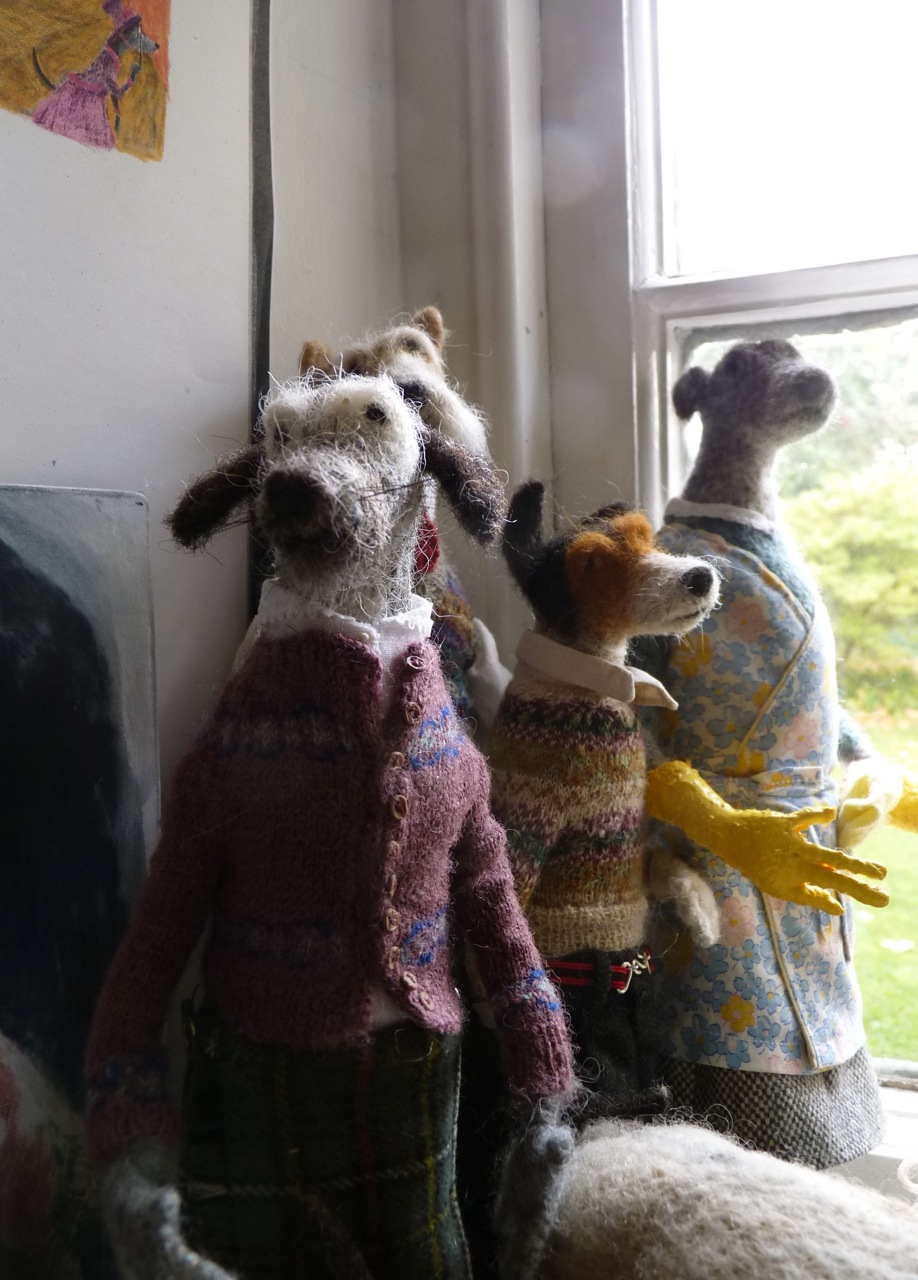
Domenica's eye for costume detail is immaculate, She cuts and tailors and sources everything herself. Back on the Hebrides one summer we took 2 Calmac ferries to the island of Barra, where in the local history museum she pored over old photographs of crofters and their children in homespun jumpers, hand -me-downs and Harris tweed. All this knowledge percolates through.
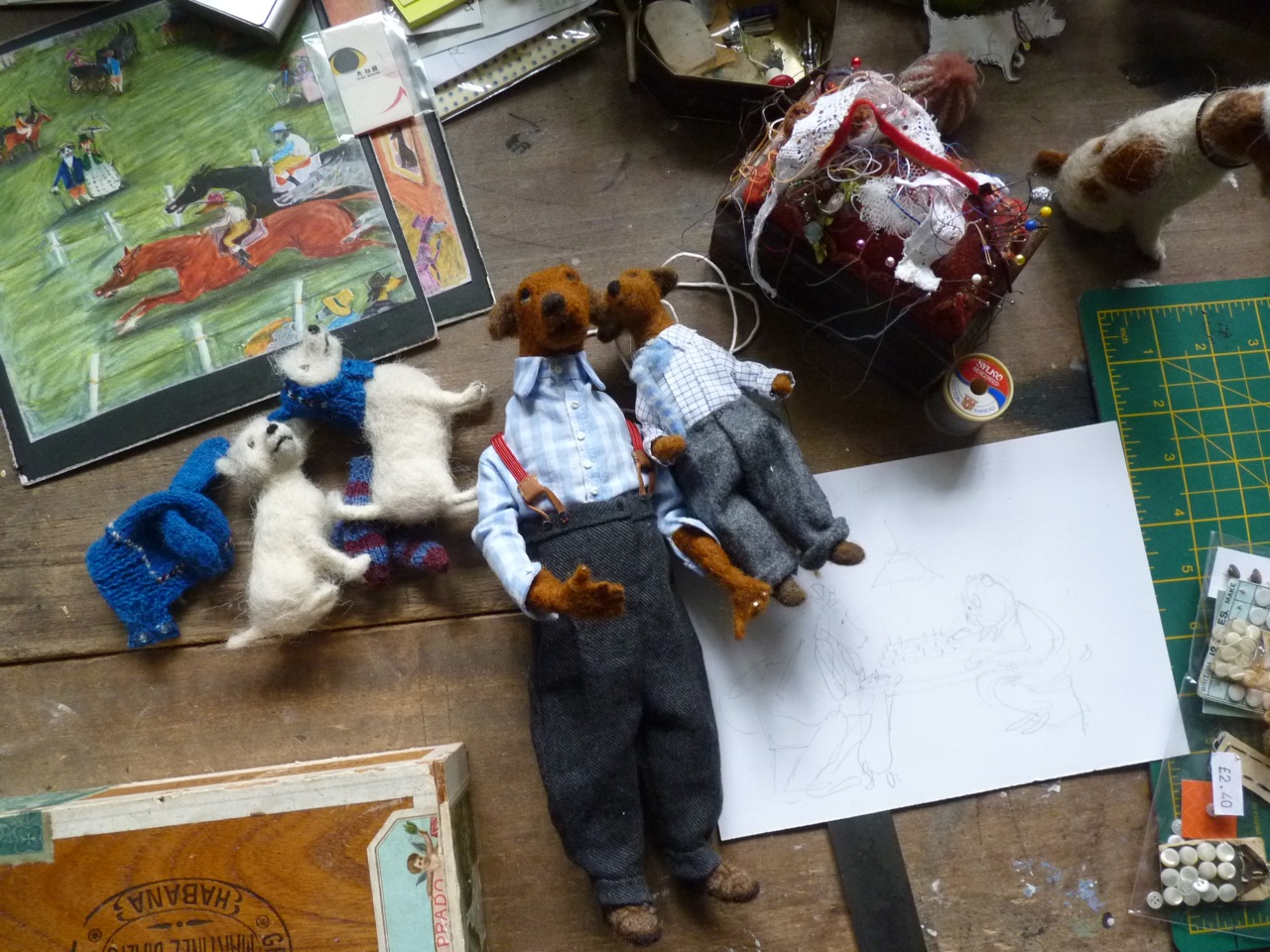
Braces.
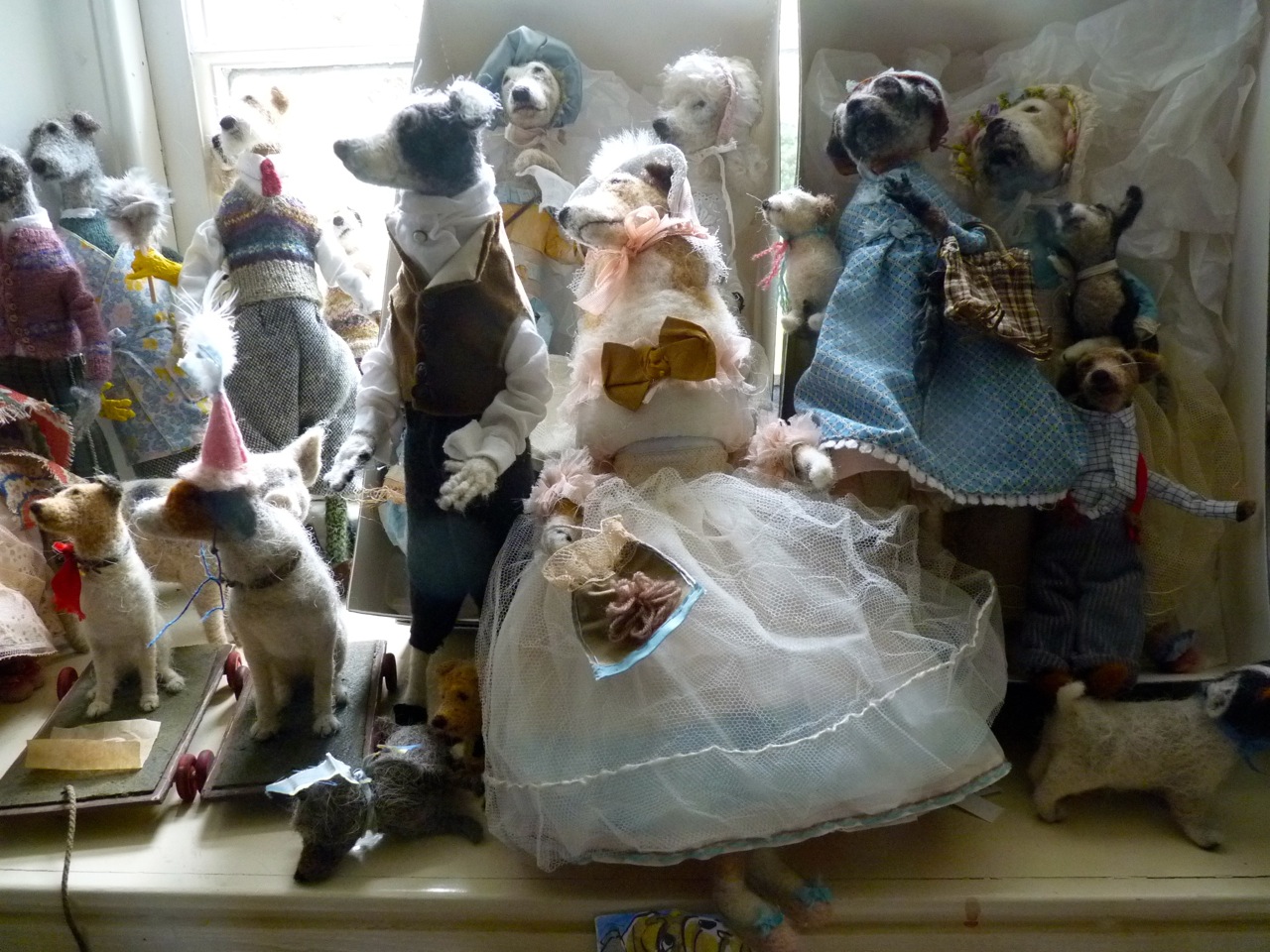
Bride dog resplendent.
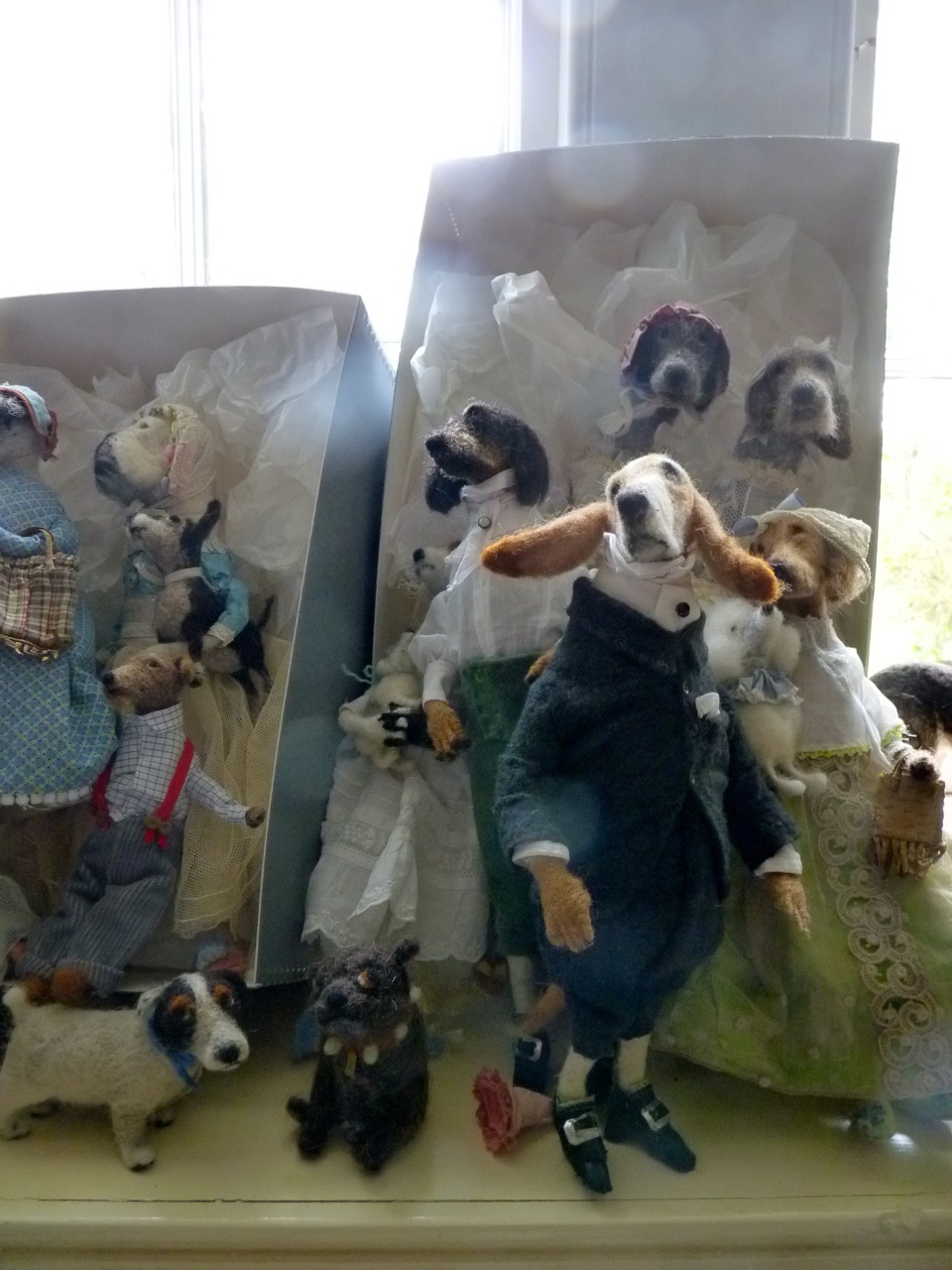
Now Domenica has taken her menagerie much further back in history, creating a troupe of characters who enact the narrative of eighteenth century Grand Tourists, and writing and illustrating the story of their travels in watercolour. You can see some of her work on her instagram feed here.
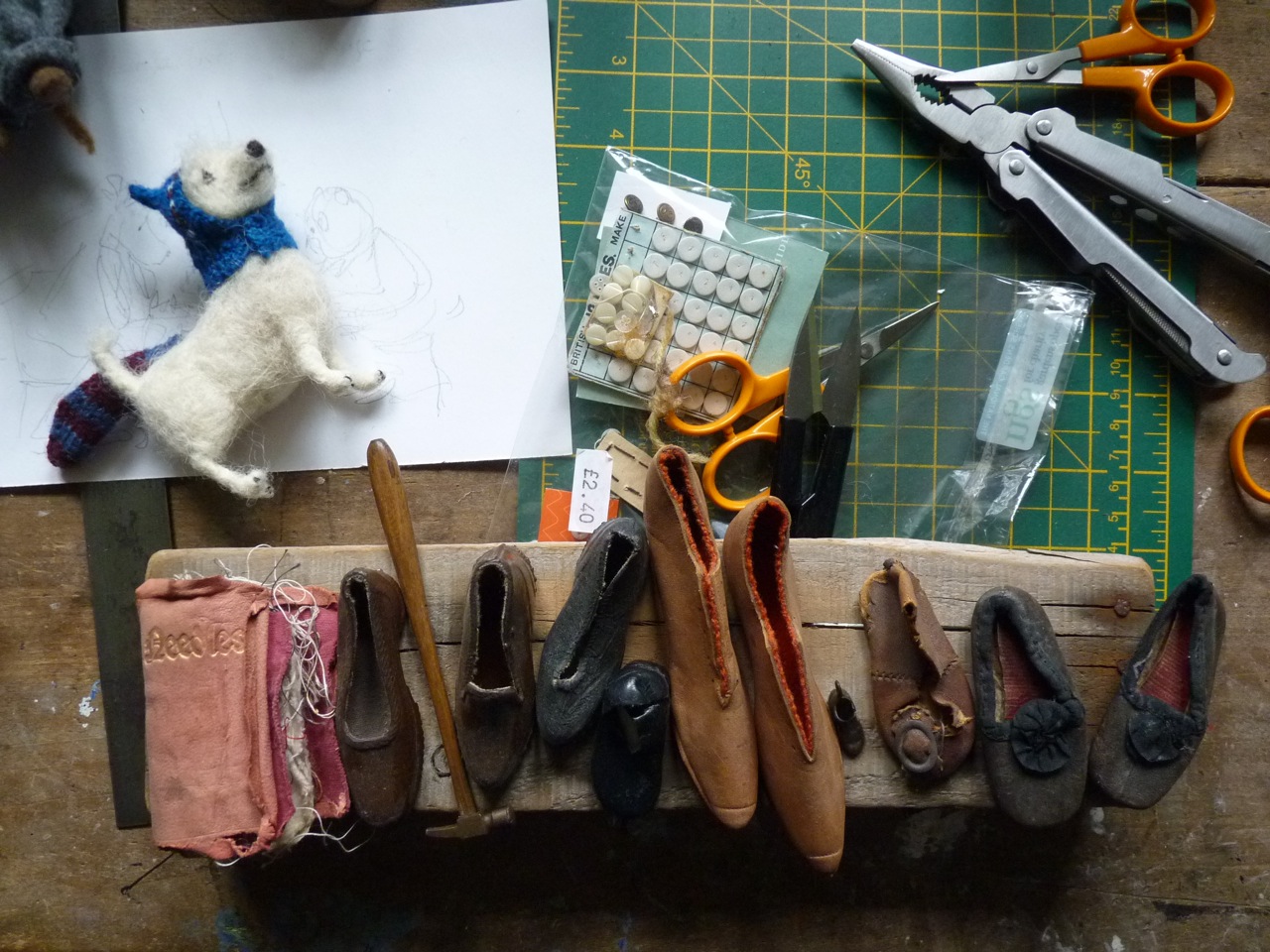
Cobblers workbench with minute eighteenth-century shoes being made in all sizes.
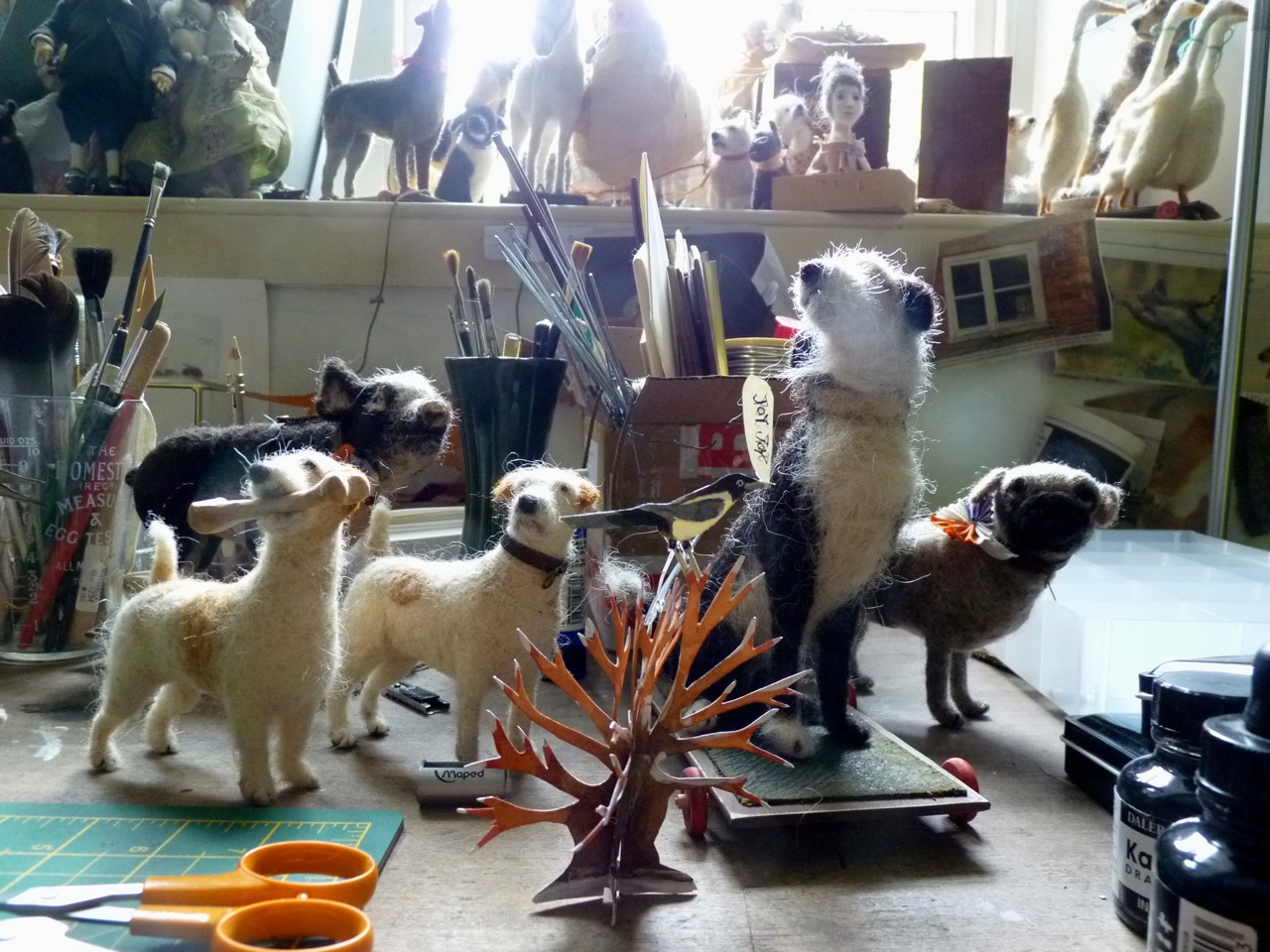
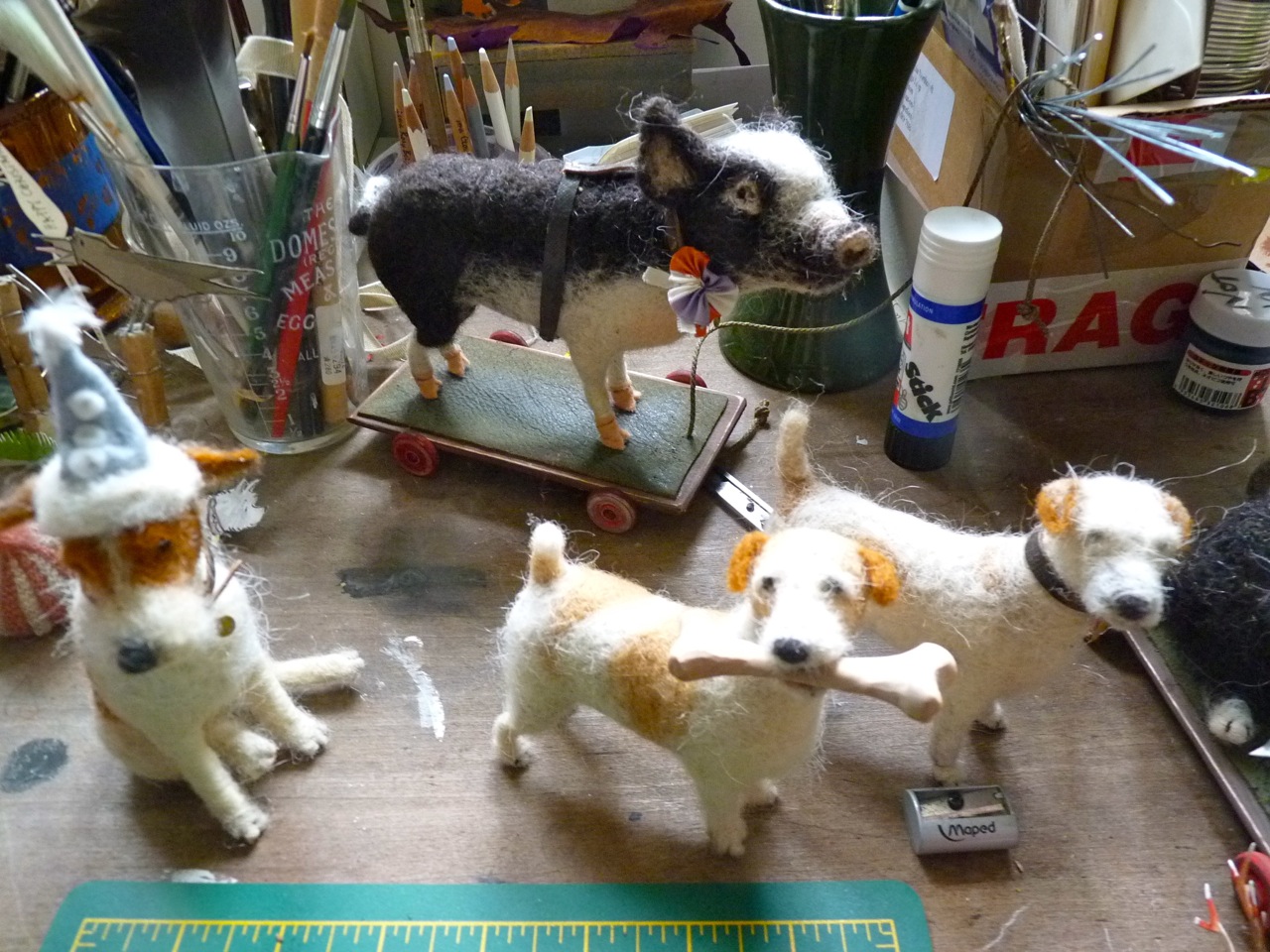
'I chose dogs because they are such good channels of emotion, ideal for capturing that childhood intense connection with an object . [They] are usually with me in my studio and I have to be careful to keep my work out of their reach as I have found some of my wool dogs in a fairly battered state in their dog baskets. I take it as a compliment and feel that I have achieved a certain level of intense connection… Actually, I think it's the smell of the wool…'
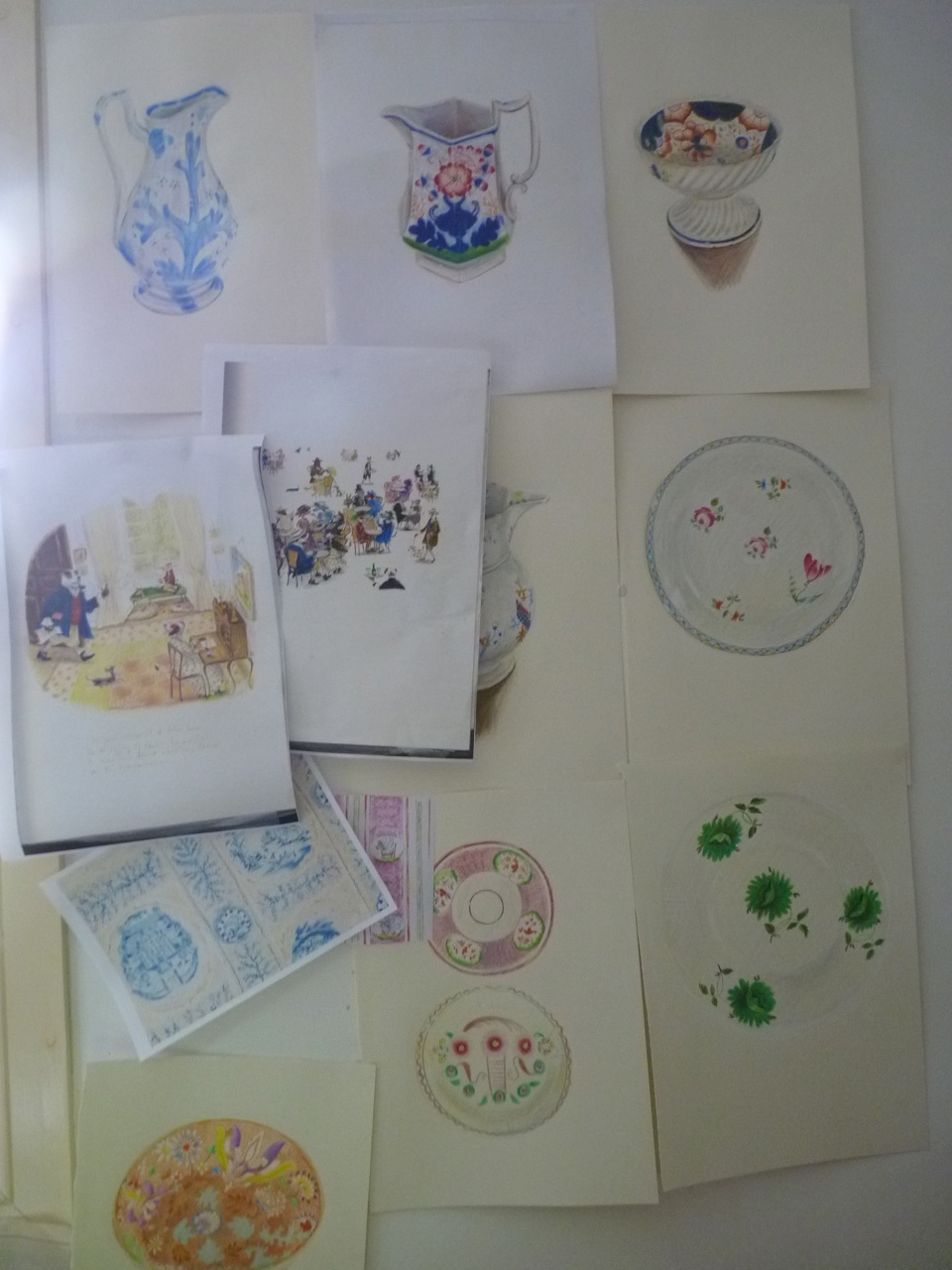
Studies of ceramics.
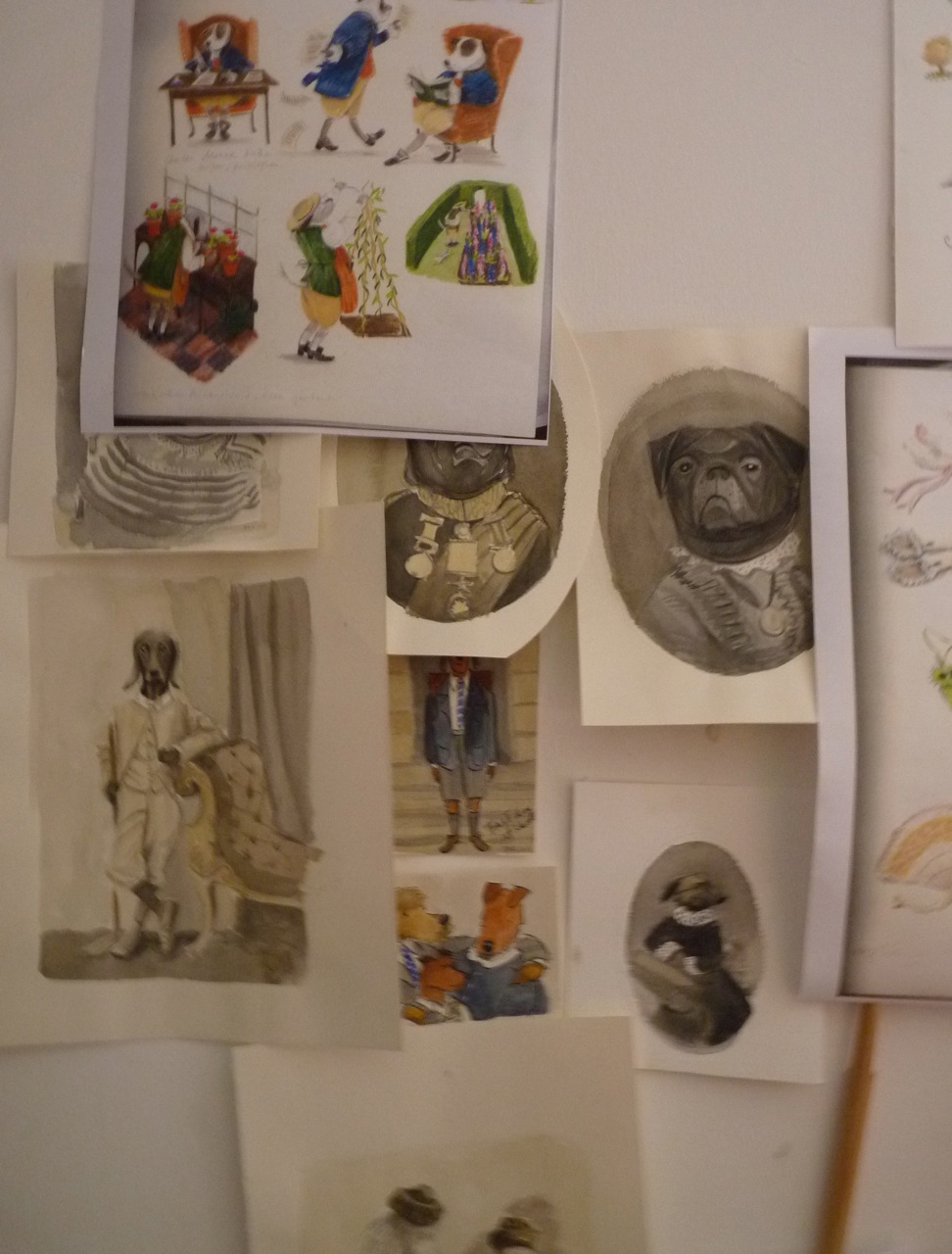
Vignettes and character sketches for the new book.
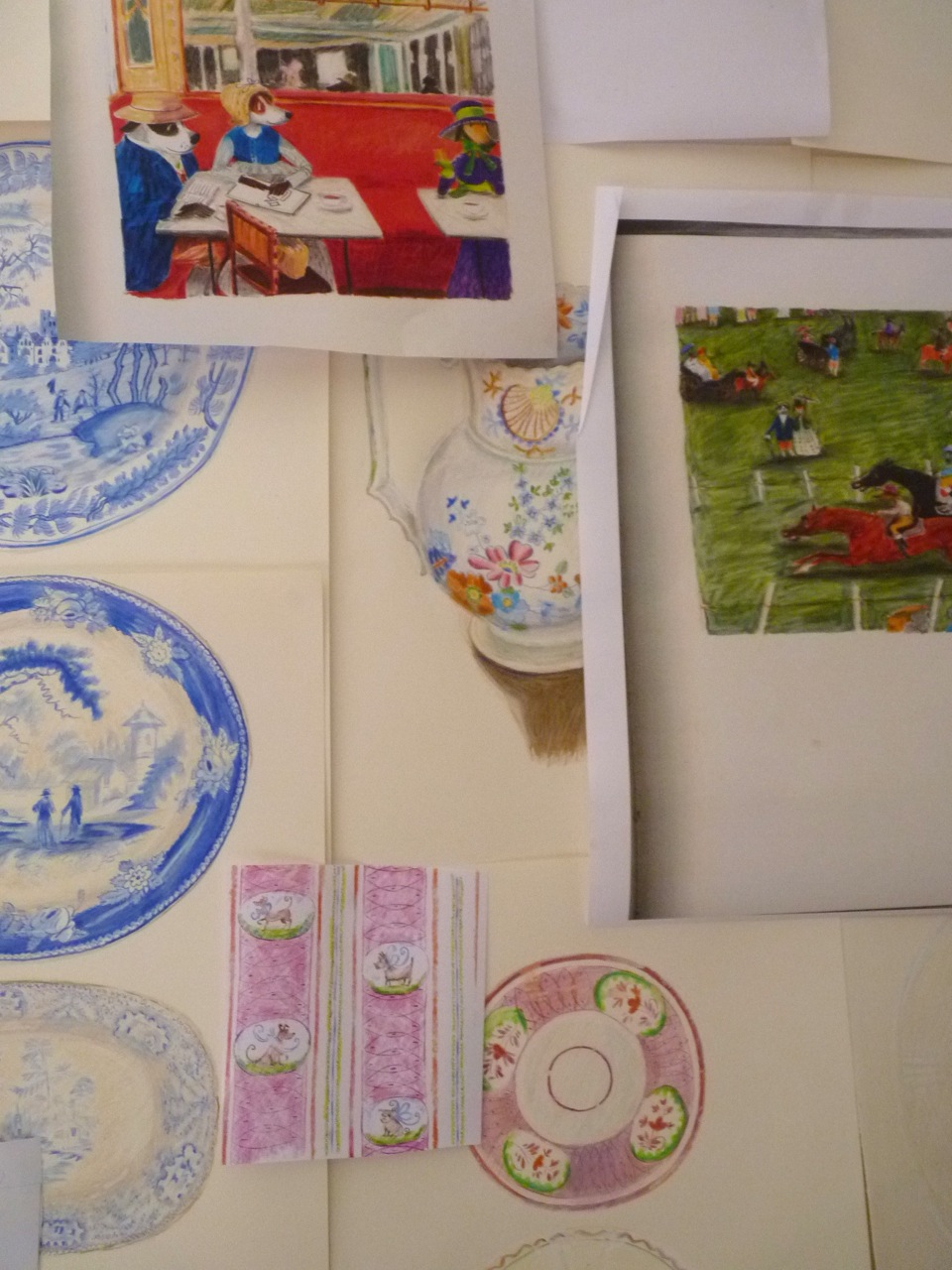
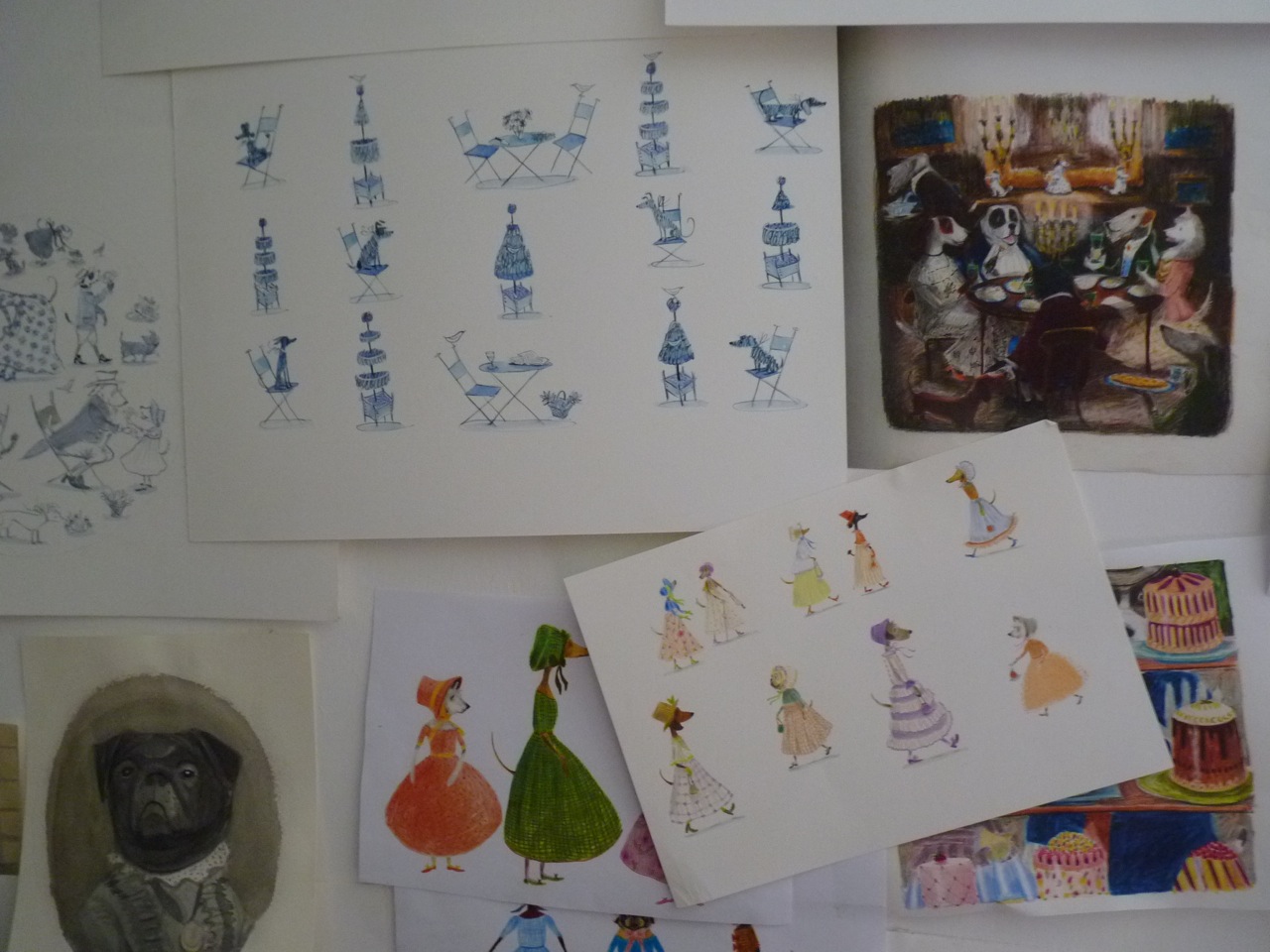
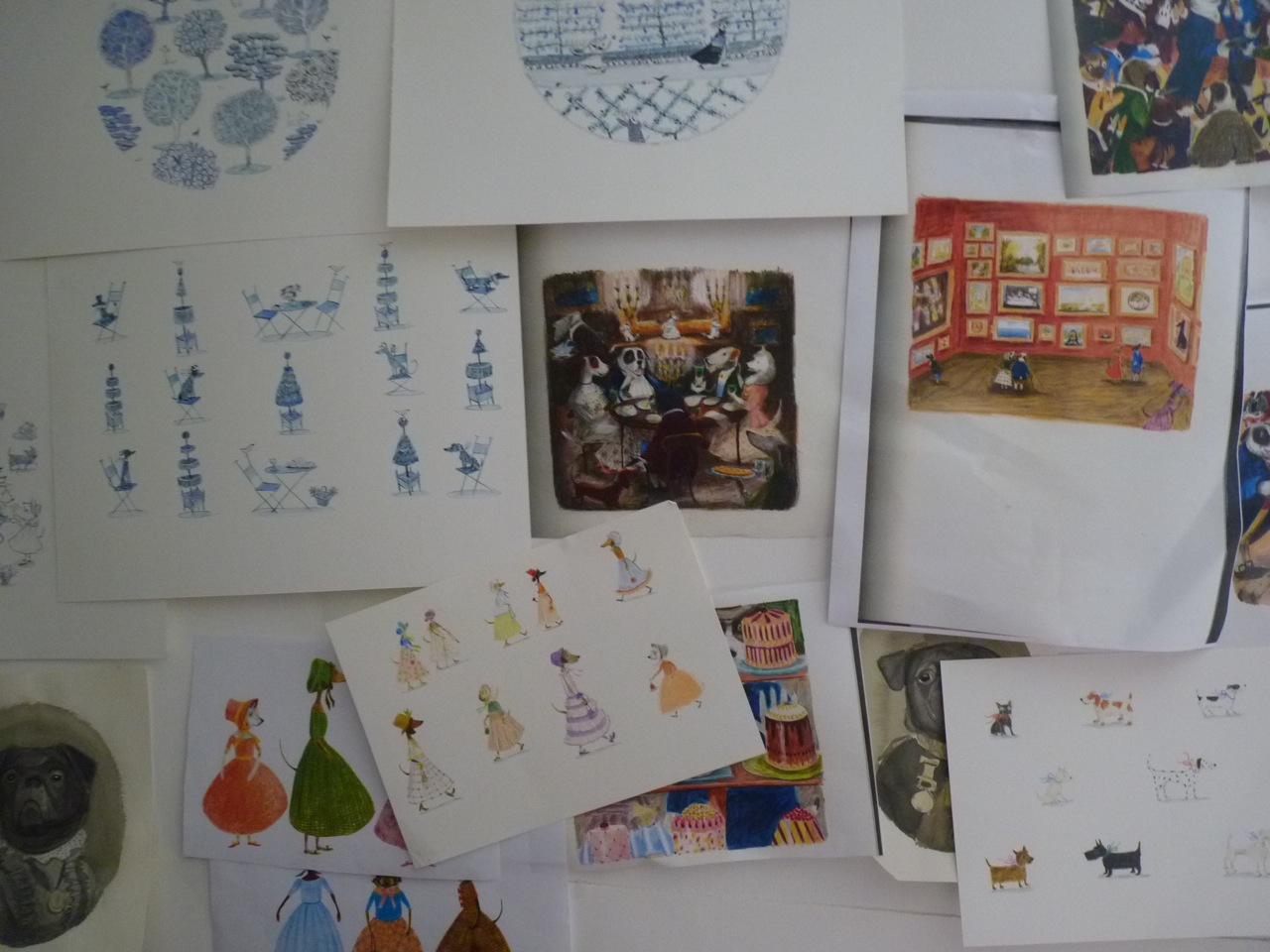
Excerpts and links may be used, provided that full and clear credit is given to bibleofbritishtaste, with appropriate and specific direction to the original content.
Grateful thanks to Domenica and Marianne More Gordon and Charlie Fletcher. All photographs copyright Domenica More Gordon and bibleofbritshtaste.
NB: You can read Charlie's privately published short story, Safe Home, here. It was written as a 'venting exercise,' in response to the Iraq war and the Chilcot enquiry. I highly recommend it.

Glynn Boyd Harte was born in Rochdale in 1948. He met his wife Caroline Bullock (herself an artist and historian) in the foyer of the Royal Opera House Covent Garden in 1968, when he was a 21 year old student at St. Martin's : she was wearing a crinoline, he fell in love with her at first sight. They married in 1971 (and later had two sons, Lucian and Caspar); after this they were very good at everything they turned their hands to, and didn't bother at all with anything they did not care about. Above all, Glynn's object was always to have fun, to amuse and to be amused, and in this he generally excelled.
![An Eric Ravilious 'Alphabet' mug, in a lithograph which will be sold by Neil Jennings in a mixed sale of artwork to be held at the Artworkers Guild, 6 Queens Square London WC1 N3AT, from March 3rd 2015. [For more information contact Neil Jennings, neil@jenningsfineart.co.uk 07812 994558].](https://www.bibleofbritishtaste.com/wp-content/uploads/2015/02/P1070061-768x1024.jpg)
An Eric Ravilious 'Alphabet' mug by GBH, in a lithograph which will be sold by Neil Jennings in a mixed sale of artwork to be held at the Artworkers Guild, 6 Queens Square London WC1 N3AT, from March 3rd 2015. [For more information contact Neil Jennings, neil@jenningsfineart.co.uk 07812 994558].

The Boyd Harte's as 'Mr. and Mrs. Soanie', described by Alexandra Artley and John Martin Robinson in Harpers and Queen's New Georgian Handbook published in 1985. 'Like all British thinkers, they run for months on ginger nuts and tea.' A tiny Ravilious Alphabet mug is in everyday use on the floorboards. The GBH's were part of the Young Fogey gang of coevals who moved into and restored derelict eighteenth housing stock in formerly slummy parts of London, that included the architectural historian Gavin Stamp, his first wife Alexandra Artley and Dan Cruikshank among others.

GBH illustrated many books, but the very best were those that he conceived of and wrote himself. These is the title page from his very first publication, 'Murderer's Cottages,' (Warren Editions 1976), published by that fellow perfectionist Jonathan Gili and now a rare item. Note the Pop Art lettertype. It is in chapbook style measuring approximately 3 x 5 inches, each plate depicting a Staffordshire china souvenir of a notorious murderer's cottage. Peter Blake, GBH's tutor at the RCA, would have appreciated it. Only 500 copies were printed. Glynn's friend and collaborator as one of the Freres Perverts, Ian Beck, has published all the other plates here.
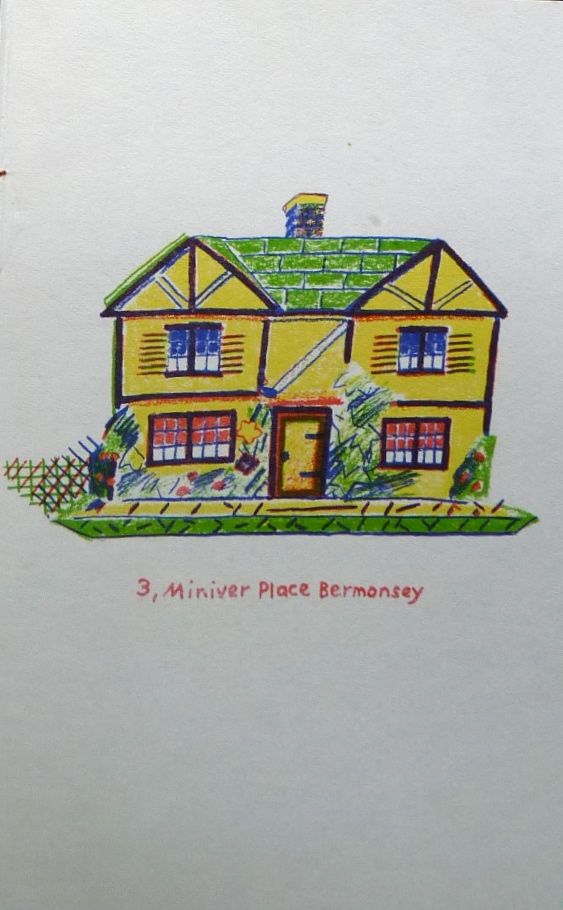
The house in which George Frederick Manning helped his wife Marie de Roux to murder her lover in 1839, and then to bury his body in quicklime under the kitchen flagstones. Both were hanged for their crime. Charles Dickens would later model the character of Hortense in his novel Bleak House on Marie Manning, and Marie appeared as a waxwork in Madame Tussard's Chamber of Horrors. The murder was remembered as the 'Bermondsey Horror,' and so the Mannings' house was immortalised in glazed ceramic for the popular Victorian market.

GBH played the piano soulfully and set the Poet Laureate John Betjeman's prose poem script for the television programme Metro-land to music; Glynn, a cast of his friends and the poet performed it together with cardboard megaphones and train noises in two locations, sometimes forgetting their lines. This is taken from his deluxe artist's book of 1977. His lithographs were and still are reproduced by the Curwen Press.

Glynn and Carrie dressed beautifully and fantastically, she in print dresses and tea gowns and he in 'bags,' waistcoats and two-tone, co-respondent shoes. But despite his rather fin de siecle good looks he enjoyed telling a joke against himself in which a third party, possibly the late James Lees-Milne, had referred to him as 'rather plain.' A fulsome thank you letter from the 1990s describing sybaritic holidays in Cornwall and France – lobsters eaten, glorious sunsets, church crawls and 'Proust's bedroom at the Carnavalet' – ended with the plaint, 'The question is, had I been less plain, would I have been able to enjoy myself so much?' Another anecdote involved being spotted by a member of the public buying his little sons an ice cream, taken for a child-molester and detained by the police. It ended with a car chase through the streets of Bloomsbury as the uncertain coppers drove him hither and tither, doubting that he was the marrying kind but searching at his insistence for the woman whom he claimed was his wife, and whom he had helpfully described to them as, 'a Bloomsbury bat in a Fauvist frock, Officer!'

Glynn's father was a commercial artist and art teacher and his grandfather owned a lithographic printing works. The front garden path of his childhood home was paved with old litho stones. At the RCA, Bawden – who taught him – and Ravilious were his artistic heroes long before they came back into vogue, but his earliest works also shared traits with those of his near contemporary David Hockney. His first works were in crayon but in the early 1980s he changed medium for watercolour, and later, egg tempera, without ever falling below his own self-imposed standard of perfection. He was a genius at depicting the perfectly arranged tablescape, sometimes as the illustration to a cookery book or newspaper column in the Times or Telegraph, sometimes for his own delectation. This is my favourite amongst those that were translated into lithograph, "Mr Dodd's Auricula' (1979). Barbara Jones's genius King Penguin Guide to the Isle of Wight can be seen in the top right corner. Mr Dodd's house has featured on the bobt here and here.

Table-scape at Charlecote House in Warwickshire.

GBH in the the Georgian house at no 29, Percy Street, to which they moved in the mid 80s, where the wallpapers were either meticulously hand painted or designed by him and some were reproduced for for his Dolphin Studio design company. Cynthia Kee described her first meeting, finding him up a ladder painting wallpaper on to the bare plaster there, ' the stripes were uncompromisingly in period, magenta, with a thinner line alongside and another of gold dots. Glynn was working on the dots.' This clipping and the following one from The Times, October 1990.

Here in Fitzrovia GBH felt entirely spiritually at home, in a house so dilapidated when he found it that the electrical wiring had been gnawed by rats. No matter, for in his imagination the Vorticists were still in the Eiffel Tower restaurant a stone's throw away, 'being very avant-garde and angular in black and magenta, Augustus John swishing his coat and beard, Ronald Firbank manfully grappling with a pea. Nina Hamnett, of course – always the perfect lady – was being sick into her handbag over the road at the Fitzroy Tavern.' What is missing here, is a proper photographic record of the exquisite rooms that Glynn and Carrie contrived here and earlier, at Cloudesley Square. Glynn's lithograph below goes some way to supply this.

Chimmneypiece at Percy Street.

GBH at Cloudesley Square, Islington, the Boyd Harte's first marital home in the 1970s . The architectural historian John Martin Robinson described meeting Glynn and Carrie for the first time, being asked to supper and then arriving at an 'uninhabitable Georgian wreck' where they removed a bit of rusty corrugated iron, climbed in and then ate a picnic together off the floor.Its finished interiors featured period decorative treatments and especially wood-graining, about which the GBH's were evangelical in an age of universally stripped pine. They had often rushed into a junk dealer's workshop to rescue some sweetly grained bedroom chest of drawers from the stripper's chemical tank.

Ravilious bowl, lithograph. The Eric Ravilious 'Boatrace' bowl for Wedgwood, standing on a burr walnut table in Cloudesley Square..

Foodie books. A labour of love. In 1986 GBH illustrated The Entertaining Book co-authored by Teresa and Auberon Waugh – she provided the seasonal recipes, he wrote about the best wine to drink with them. Glynn went down to Combe Florey House in Somerset, where Bron's father the celebrated author Evelyn Waugh had lived before him, and drew the kitchen table set with their lunch as the book's cover design, ate it, and then drew the table with dirty plates, empty glasses and chairs pushed back afterwards as the back cover.

For Teresa's introduction he chose to illustrate the sentence, 'My children's generation has been brought up on a mixture of Camembert, junk food and avocado pears – such things would have been unheard of in a post-war nursery,' ( as the daughter of the 6th earl of Onslow, Teresa's childhood was passed at Clandon Park, their country seat). She was fascinated when he drew these objects just as they were including the 1980s Tesco price tag, executed with great verisimilitude.

Asparagus watercolour. Glynn was particularly fond of the grid, trellis or graph pattern as a background matrix.

Carnations and brushes lithograph.

The album of five musical compositions which he composed, illustrated and dedicated to his wife Carrie.

'Tea at Farringdon,' Lord Berners, Penelope Betjeman and her Arab mare, Moti. For the original watercolour, featured in an earlier post, see here.

The plangent musical score. 'The? Lait? One-Lump-or-Two? Un Cheval ! Un Cheval Rose !! Encore du The?'

'The Pyramids.' Also utilised as the 'Carte Postale,' in a dramatic routine performed by les Freres Perverts.

'Les Mains de Ravel.'

GBH as artist in residence during the rebuilding of the Royal Opera House, Covent Garden.

The Pansy fabric designed by GBH for Dolphin Studios.

GBH's watercolour, 'Johnnie Scraping his boot,' (2000), painted at Charlecote, the Warwickshire country house of his art school coeval and old friend, Sir Edmund Fairfax Lucy.

A.N. Wilson and ex-Battersea Dogs Home cocker spaniel 'Percy,' in an infamous incident recorded by GBH in strip-cartoon narrative in memoriam, after Percy died prematurely.

Early sketch towards an unrealised painting that was to have been titled, 'Mr and Mrs. Wilson and Percy,' after Hockney's semi-eponymous double portrait of Ossie Clark and Celia Birtwell in the Tate. Glynn was an obelisk fetishist with an admirable collection; 'poor man's obelisks' referred to my less desirable shelf full of minature lighthouses manufactured from Cornish Serpentine on the Lizard peninsula.

All missives, programmes, envelopes and invitations were opportunities for more jokes, wildly embellished gossip and ancient running jokes of long-standing. During his final illness, a friend described a dinner at her house at which GBH and another dinner guest who was a dress designer laughed themselves silly as they discussed couture shrouds – 'a shroud to die for.' After he collapsed in a hospital waiting room his jacket, ripped by the resuscitation team, was exhibited like a toreador's cloak to visitors at his house in Gower Street.

Glynn, Lucian, Caspar and Carrie Boyd Harte drawn by an ailing GBH shortly before his death. As Carrie points out, 'He got all the shoes exactly right.' GBH is remembered as an enthusiastic Brother and Past Master (in 1996) of the Art Worker's Guild. When the Guild 'Revels' were revived he directed several full-dress pantomimes, which oscillated between 'farcical under-rehearsal and total professionalism' ( as one of his collaborators, Alan Powers, recalled in his obituary for the Independent) and were performed to sell-out audiences. As Powers also wrote, 'The listing of individual achievements fails to convey the totality of Glynn Boyd Harte's life, which, like Oscar Wilde's, was the vehicle of genius. It extended to his taste in decoration and collecting, his circles of friends and enemies ( irreversibly and often unreasonably transferred from the first category into the second) and not least, the warmth of the family life that surrounded him.' Excerpts and links can be used providing that full and clear credit to bibleofbritishtaste is given along with direction back to the original content.
To say that his achievements should be better known would be quite true, to say that he is greatly missed is an understatement.
All images copyright bibleofbritishtaste / the estate of Glynn Boyd Harte.
This week Nicky Haslam's Folly de Grandeur was published. It's the story of the house in which he has lived for over thirty years, told in a prose which is never purple but ever so slightly lilac. He writes in the same distinctive, confidential tone that he would use if he were leading you through its pretty rooms himself. There are hundreds of glorious pictures drawing you back to leaf through its pages again and again and their edges are burnished a bright silver.
Nicky Haslam is an English interior designer, old Etonian and cabaret singer, member of the Traveller's Club, writer and witty columnist, the most beautiful, best dressed and favourite friend and guest wherever he goes. His company is NH Design and its style, like his, is never boring.
In his autobiography Redeeming Features (2009,) Nicky writes, It is risky to eulogise one's own home but to me the Hunting Lodge is quite simply the prettiest small house in the world. It was once a Tudor hunting box in the Royal Forest that stretched from Windsor to Winchester. There is a tradition that Prince Arthur the soon-to-die son and heir of Henry VII, first set eyes on his bride Catherine of Aragon there. Nicky has given it the treatment it deserves, with chintz covers gay with roses and fuschia, old pictures and furniture, books, generous hospitality and masses and masses of English flowers from his cutting garden.
These hastily taken photos are not as good as they should be whereas the lunch which came first, one warm summer Sunday, was heavenly.
It was such a good lunch that a few rooms somehow got missed out altogether, including the silvery green Dining Room created by Nicky with its foliate walls painted to resemble an Anglo-Chinese wallpaper and the garden room with one of the most beautiful English Rococo chimney pieces ever. But then these pictures are only an amuse bouche.
Folly de Grandeur will show you all this and much more.

The brick facade is 'pretend Jacobean,' put on in the 1720s for the Mildmay family of Dogmersfield Park. Its chalky look comes from the whitewash applied in the nineteenth century and then taken off again. NH points out the vista down to the lake to lunch guest Miss G.K.M.W.
The legendary interior designer John Fowler, a partner in the firm of Colefax and Fowler, found the Hunting Lodge and beautified it in the 1940s, adding an entrance hall and kitchen and reclaiming the garden from heathland. He laid it out in an eighteenth century Dutch style as a very grand cottage garden with many hedged compartments. He lived here until the 1970s. 'The contrast of discomfort and luxury was an integral part of staying there during his later years' his friend John Cornforth remembered. Fowler left it to the National Trust and for a while nobody wanted it. Nicky was its next incumbent.

The little entrance hall, added by Fowler and refurbished by Nicky Haslam. French decorative touches abound and the pedestal is in the style of those at Sanssouci, the summer place of Frederick the Great, King of Prussia.

In the long narrow old hall which runs the length of the house, John Fowler had a rather strict and chilly dining arrangement with a round Regency table pushed into one corner. Now it is a place for taking off boots and winter drinks, with a sofa before the fire and huge club fender.

On the marble topped table the etching After Chardin by Lucian Freud inscribed 'To Nicky,' sits next to a self portrait by Cecil Beaton. The cire perdue landscape was a gift from Hockney, behind is a huge floor plan by James Wyatt for The Waterloo Palace, in front is the visitor's book. Signatures from its thickly inscribed pages are reproduced on the end papers of Folly de Grandeur.

The three windows were curtained with Colefax and Fowler's 'Oak Leaf' pattern, now out of production. Lady Homayoun Renwick gave NH enough to remake them to Fowler's scheme, and he kindly spared me the bit I needed to patch an old sofa cover cover made from the same glazed chintz.

Nicky's mother Diana Ponsonby, by whom he is descended from the earls of Bessborough, enshrined above the drinks tray. His last big party was held in their former villa Parksted House built by William Chambers on the edge of Richmond Park, where he installed a huge circular rotating dance floor for one night only. The paper in the Staircase Hall is a giant Mauny papier peint flower print which continues up the stairs, Fowler's choice, restored by NH.

The sitting room walls were traditionally washed in a mixture of distemper and bull's blood.

The needlework petit point cover on the low bench was worked by NH. It is a stylised representation of the house's gabled skyline which took ages to complete. The guest-rumpled French linen cushions are edged with a deep wool and metal thread fringe.

The grand carved wood Baroque fire surround was put in by John Fowler. The lobsters were once part of a table setting designed for Cartier.

The mantle is crowded with invitations and the photographs of friends of the bosom, although in Folly de Grandeur you will see it more formally arrayed with specimen roses from the garden in crystal vases. The painting of St. Francis of Copertino, the patron saint of aviation, belonged to NH's father.

The busts of a French nobleman wearing the Order of the Golden Fleece, on the 'David' table in homage to to the late David Hicks, inventor of the 'tablescape' and the giver of several items seen here. NH's tablescapes are far more generous, running up to and almost over the edges.

The dressing room, tweed, more tweed and a bit of leather.

The dressing room, some hats and a lot of boots.

The master bedroom with its canopied bed (not seen) and blue grey dragged paintwork divided with wallpaper border strips of a Mauny design.


The garden room contains its own complement of books, pictures, pretty china, sofas, drinks and a huge fireplace. There is a potting shed orneé at the rear.

Lush.

Et in Arcadia ego : NH and house guest.
All pictures copyright bibleofbritishtaste/ NH.
John Boyd Designs Notting Hill 3 Drawer Chest
Source: https://bibleofbritishtaste.com/tag/david-hockney
Posted by: beckerzekere.blogspot.com

0 Response to "John Boyd Designs Notting Hill 3 Drawer Chest"
Post a Comment